- Search Please fill out this field.
- Manage Your Subscription
- Give a Gift Subscription
- Sweepstakes
- Travel Tips

The Best (and Worst) Times to Visit Vietnam, According to Experts
Here's when to visit Vietnam for sunny weather, lower prices, and excellent sightseeing.
:max_bytes(150000):strip_icc():format(webp)/SophieDodd-29f8105329084ddbafdf19974fa43b45.jpg)
Best Times to Visit for Smaller Crowds
Best times to visit for good weather, best times to visit for lower prices, best times to visit for hiking in sa pa, best times to visit for cruising ha long bay, worst times to visit.
Khoa Nguyen/Getty Images
Cinnamon and star anise perfume my memories of Vietnam, a country that lodged itself into my palate in fragrant, frenzied bursts. That alluring scent of pho was one of few constants as I traveled through vastly different landscapes, trekking through verdant rice terraces, dodging motorbikes en route to speakeasies, and standing face to face with an endangered monkey in my oceanfront outdoor shower — all within the span of two weeks.
Vietnam is more than 1,000 miles long, a spectacularly slim country that’s only 30 miles wide at its narrowest point. Every region boasts its own allure as well as its own climate, which means you’ll need to carefully consider the time of your visit based on your desired itinerary.
“As the climate varies so much from north to south, there will always be somewhere worth going in Vietnam, whatever time of year you travel,” says Melissa Matthews, regional director for Southeast Asia and North America at luxury travel company Red Savannah .
Here's a regional breakdown of the primary tourist seasons in Vietnam:
- High Seasons: North: September to November, March and April; Central: April to August; South: October to April
- Shoulder Seasons: North: December to February, May to August; Central: September to March; South: September to December
- Low Season: North: May to October; Central: September to May; South: May to September
Before you start planning your trip, read on to learn about the best times to visit Vietnam for hiking the majestic, mountainous rice terraces of Sa Pa, cruising the limestone marvels of Ha Long Bay, and avoiding the rainy monsoon season.
Bang The Tran/Getty Images
The high season in Vietnam varies according to the region, so you’ll always be able to find a place that feels more secluded from the bustle of crowded beaches or cruise ships. Wet season attracts fewer crowds, says Matthews, which falls from May to October in the north, September to May in the central part of the country, and May to September in the south.
Visiting during this time has plenty of perks, as you’ll likely be able to save on accommodations and travel costs. Popular restaurants and tours will be less overrun with tourists, offering a rare opportunity to better immerse yourself in the local culture as you tuck into bun cha on a sidewalk stool. However, bursts of rain and cloudy weather can dampen any plans to hike in Sa Pa or cruise along Ha Long Bay — two quintessential experiences you won’t want to miss.
There are also an abundance of places that remain less crowded throughout the year, says Benjamin Kreuz, general manager of Six Senses Ninh Van Bay — the resort itself is one of them, nestled in a private cove of Nha Trang that became my personal definition of paradise. Many visitors tend to prioritize other attractions as they make their way south, so natural wonders in the north like Ban Gioc Waterfall and the network of caves in Quang Binh remain less busy.
Meet the Expert
- Melissa Matthews is the regional director for Southeast Asia and North America at luxury travel company Red Savannah.
- Benjamin Kreuz is the general manager of Six Senses Ninh Van Bay in Vietnam.
No matter when you visit, you’ll always find good weather somewhere in Vietnam. “Vietnam is a beautiful country with tropical weather, making it suitable for visits throughout the year,” says Kreuz.
For those hoping to see Hanoi, Ho Chi Minh City, and everything in between, it’s best to go in the dry season. “February and March are the best months to see the entire country from north to south in relatively dry weather,” says Matthews. She notes that Tet, or Vietnamese Lunar New Year, falls during this time and can last for up to 10 days. “During this time, most of the key sights in the cities are closed, as everyone goes back to their family villages to celebrate,” she says. She recommends heading to the beach during the festival and bookending your trip with time in the major cities.
For a dry and temperate trip to Sa Pa or Hanoi in the north, head there from September to November, or in March and April, she suggests. A sunny beach visit to Hoi An or Nha Trang in the central region is best from April to August, while the Mekong Delta and Phu Quoc Island in the south are warmest from October to April.
Vietnam is a relatively affordable destination all year long, with abundant and economical street food and comfortable hotels for all budgets. For your best chance at scoring low-cost flights and accommodations, consider traveling outside the peak tourist season. April, May, October, and November are excellent times, as you’ll still find warm weather throughout the country, but will have fewer tourists to contend with.
Wand_Prapan/Getty Images
A visit to the verdant, terraced rice fields of Sa Pa are a must for nature lovers and outdoor enthusiasts alike. Overlooking the Muong Hoa Valley, the hills are surrounded by spectacular mountains and home to dozens of communities, including the Hmong and Red Dao peoples — many of whom open their homes for overnight stays and lead private or group trekking tours. You can reach this famed hiking destination by car from Hanoi in five hours, by a bus in six to eight hours, or on an overnight sleeper train.
Matthews notes that this region tends to get colder from December to February, so it’s best to plan a trip from September to November or in March and April. Harvest season is also an unforgettable time to visit: In late August through September, the vibrant green hillsides turn a voluptuous shade of gold as the rice ripens.
Nikada/Getty Images
Ha Long Bay, with its emerald waters and limestone towers, is one of the primary tourist destinations in Vietnam, and as such, has become increasingly overrun with cruise operators leading day tours. For a less crowded experience, consider booking an overnight cruise that will take you deeper into the bay — or to the equally beautiful, slightly less populated neighboring Lan Ha Bay. (I splurged for a two-night cruise with Orchid Cruises , one of the more luxurious tour operators).
March, April, October, and November are ideal months to visit, as they tend to bring warm and sunny weather without as much humidity. You’ll also avoid the peak season, so while it’s still bound to be busy, you can enjoy kayaking through the tranquil waters and hiking Cat Ba island in relative peace. The UNESCO World Heritage Site is also a great opportunity for a snorkeling or scuba diving adventure.
Nick Dolding/Getty Images
While Vietnam’s varied climate means there’s never really a bad time to visit, you may want to avoid traveling to the country during monsoon season.
“When the monsoon hits, it is hard and heavy and very humid,” says Matthews, who suggests sightseeing in cities during the wet season, where you can still visit museums and historic temples between rainstorms. “Avoid the mountainous region of Sa Pa and definitely don’t book a cruise in Ha Long Bay, as storms will occur and boats are grounded,” she warns.
If you do decide to travel during the rainy season, it’s best to remain flexible in your planning, says Kreuz. “Consider not booking everything in advance due to unpredictable weather,” he says, adding that staying open-minded may help you to take advantage of potential low-season discounts.
Tet, which marks the Vietnamese Lunar New Year, is another tricky time to visit, as many landmarks and businesses close for a week or more to celebrate. It typically lands in late January or early February — this year, it falls on Feb. 10.
The Best Time to Visit Vietnam
:max_bytes(150000):strip_icc():format(webp)/greg-rodgers-adventure-ed92646b25f247049e53af6d36f6c15f.jpg)
sutthinon sanyakup/Getty Images
The Weather in Vietnam
- Monsoon Season
- Typhoon Season
- Key Events & Festivals
- Frequently Asked Questions
Deciding the best time to visit Vietnam greatly depends upon how far north or south that you begin, as well as other factors such as festivals and holidays. In general, the best time to visit Vietnam is from December through February when temperatures are milder and rain is minimal.
Vietnam's long, narrow shape means that the three primary regions (north, central, and south) experience different types of seasons and weather events throughout the year. Choosing when to go to Vietnam is important, both for personal comfort and packing purposes. The south generally receives more rain and enjoys a tropical climate, however, Hanoi and points farther north have cooler winters than many travelers expect. The area is one of the few places in Southeast Asia you can really feel cold without going to higher elevations.
Vietnam can be enjoyed at any time throughout the year, however, weather plays a big factor—particularly if you plan to enjoy trekking and outdoor activities. There are two tropical monsoons that affect the country's climate, dividing the year into a wet season and a dry season.
The wet season is due to the southwest monsoon (May to September), which brings torrential rains and high temps. Sometimes monsoon rains can become so heavy in urban areas that streets flood and transportation shuts down completely!
Meanwhile, the northeast monsoon creates the cool, dry season (November to March). Although Vietnam still receives a little rain this time of year, the driest months for visiting the south of Vietnam ( Ho Chi Minh City ) are typically between December and April. Temperatures and humidity levels in March and April can be suffocating before monsoon rains begin to cool things off in the summer months.
The spring and autumn months are most pleasant for visiting the north of Vietnam ( Hanoi ). Winter nights can get relatively chilly, with temperatures dipping into the 50s. Much colder has been recorded. You'll certainly need a jacket when visiting Halong Bay in the winter, particularly if you're already accustomed to warmer temperatures in the south or other countries around Southeast Asia .
Visiting Vietnam During Monsoon Season
As with most destinations, Vietnam can still be enjoyed during the monsoon season , but there are some caveats.
You'll meet far fewer travelers and a lot more mosquitoes during the rainy season. Negotiating better prices for accommodation becomes easier, and tours may be cheaper, but outdoor activities such as exploring the Citadel at Hue become soggy experiences.
Transportation delays happen. Buses may not run during long periods of heavy rain—perhaps a good thing as roads become flooded and more dangerous to drive. Even the low-lying tracks along the north-south railway become flooded, causing delays in train service.
If your plan is to travel between Hanoi and Saigon , have a flexible itinerary in case the weather causes delays. You may be better off flying into the part of Vietnam you wish to visit rather than trying to travel long distances overland during monsoon season.
Visiting Vietnam During Typhoon Season
Regardless of the season, large weather events such as tropical depressions and typhoons blowing in from the east can create week-long downpours that disrupt trip plans. Sometimes they can devastate areas that are prone to flooding.
Although Mother Nature doesn't always play by the rules, typhoon season typically ends around December each year. The start dates depend upon which part of Vietnam (north, central, or south), but August is a general starting point. October tends to be a stormy month overall.
The good news is that typhoons don't normally sneak up on a country unexpectedly. Keep an eye on weather events as your trip approaches. If a typhoon is moving into the area, flights may be diverted or delayed anyway.
Key Events and Festivals in Vietnam
The largest national holiday in Vietnam is the Lunar New Year celebration known as Tet.
During Tet, transportation and accommodations go up in price or become booked solid as people move around the country to celebrate or visit family. An influx of Chinese tourists traveling for Chinese New Year hit popular beach areas such as Nha Trang. Although Tet is an extremely interesting and exciting time to be in Vietnam, your travel plans will certainly be affected, so book ahead and arrive early.
Tet follows a lunisolar calendar—after all, it is Lunar New Year—so dates vary from year to year, usually coinciding with Chinese New Year. It's one of the largest winter festivals in Asia and occurs between January and February.
Other big national holidays include May 1 (International Worker's Day) and September 2 (National Day). Reunification Day on April 30 celebrates the reunification of North Vietnam and South Vietnam at the end of the Vietnam War. Local families may be traveling during these times. The Mid-Autumn Festival ( Chinese Moon Festival ) is observed in September or October (based on the lunisolar calendar).
March and April in Vietnam are quite hot, with temperatures averaging around 80 degrees Fahrenheit. Typically, rain begins in full force by late April, and by May, the heat and humidity are intense. The upside: Fewer crowds.
Events to check out:
- Thay Pagoda Festival honors Tu Dao Hanh, a Buddhist monk who invented Vietnamese water puppetry. Taking place during the third month of the Chinese lunar calendar, the event is celebrated with water puppetry festivals about 18 miles southwest of Hanoi.
- International Labor Day is held on May 1. Celebrations and parades are held in central squares throughout the country.
- Saigon Liberation Day is celebrated nationwide on April 30.
Summertime weather can vary depending on where you are in the country. The south is quite warm, with highs climbing above 90 degrees Fahrenheit regularly, and is often victim to frequent heavy showers. If you're in the northern part of the country, you'll want to bring plenty of insect repellant—mosquitoes are at their peak, thanks to frequent heavy rainfall. Plan to pack sandals and a travel umbrella that can withstand strong winds.
- National Day celebrates the rise of the Socialist Republic of Vietnam on September 2 each year.
Rains continue through September and October, with the latter being the wettest month in Ho Chi Minh City (the city sees an average rainfall of 7.5 inches every October). Keep in mind that typhoons can cause rough seas; unsuspecting tourists should be aware that central regions of Vietnam are subject to hurricanes during the fall months.
- During mid-September, Haiphong hosts the Do Son Buffalo Fighting Festival.
- The Mid-Autumn Festival (Tet Trung Thu), also held in mid-September (on the half-moon of the eighth lunar month, to be exact), is popular with kids and includes dance, sweets, and toys for purchase.
At last, come December, the country dries out. Winter marks the best time for seaside vacations in Vietnam, but the northern part of the country can be quite cool and gloomy. Expect temperatures of around 50 degrees Fahrenheit and occasional drizzle.
- Vietnam's Traditional Lunar New Year Festival ( Tet Nguyen Dan ) is celebrated countrywide. During this four-day event, you can expect lion dances, feasts featuring sticky rice and mung bean cake, and fireworks.
- Celebrated during the first lunar month of the Chinese lunar calendar, the Lim Festival commemorates Ba Mu, a Buddhist nun at Lim Pagoda. Every year, visitors travel to Bac Ninh province to listen to traditional Quan Ho folk songs and watch weaving competitions.
December to February is the best time to visit Vietnam for mild temperatures and minimal rain, especially if you're visiting the south. However, northern cities like Hanoi can get surprisingly cold in the winter, so plan for spring if you want more heat.
The monsoon season in Vietnam lasts from April to October, so be prepared for humidity and rainy days. The peak of the rainy season lasts from June to August, so avoid these months if you want to enjoy outdoor activities.
Apart from the rainy summer months, Lunar New Year—known as Tet—is one of the busiest times around the country. It's an exciting time to be in Vietnam, but plane tickets and hotel rooms shoot up in price and making reservations will be extra difficult.
March through May is heat season in the south of Vietnam (Ho Chi Minh City), with temps reaching as high as 95 degrees Fahrenheit in April. In the north (Hanoi), June and July are the hottest months of the year, seeing average highs in the high-80s.
The Best Time to Visit Ho Chi Minh City
The Best Time to Visit Morocco
The Best Time to Visit Japan
The Best Time to Visit Macao
The Best Time to Visit Hanoi, Vietnam
The Best Time to Visit Boston
The Best Time to Visit the Maldives
Vietnam's Favorite Festivals
The Best Time to Visit Munich
Weather in Southeast Asia: Climate, Seasons, and Average Monthly Temperature
Fall in Asia: Weather, What to Pack, and What to See
A Guide to Celebrating Lunar New Year Around the World
February in Asia: Weather, What to Pack, and What to See
The 7 Best Temples and Pagodas in Ho Chi Minh City, Vietnam
Weather in Ho Chi Minh City: Climate, Seasons, and Average Monthly Temperature
January in Asia: Weather, What to Pack, and What to See
Best time to visit Vietnam & weather
The weather and the best time to visit Vietnam vary enormously between the north and the south. Depending on where you want to spend most of your time, make sure you are prepared for the weather.
What is the best time to visit Vietnam
The best time to visit Vietnam is from December to April. The temperature is pleasant and there is almost no rain. But the best time to visit Vietnam also depends on where in Vietnam. In the north it can get quite cold in December and January. Therefore, view the weather by month for each region. March is the best month to travel throughout Vietnam.
High season (June-July)
High season for traveling to Vietnam is usually in June and July. Although this is a peak season for the Dutch due to school holidays, the Vietnamese school holidays are also overlapping at the moment. Prepare for busy airports and full flights, especially if you plan to explore more of Southeast Asia while you are there. If you want to travel cheaply, this period, as well as during Tet (early February), may not be the best time to visit Vietnam. You will find that many hotels and flights are fully booked if you look for it at the last minute. With many people on the move, it’s best to plan in advance to get some good deals on flights and accommodation.
Low season (September-October)
This is the cheapest time to fly to Vietnam. Not only can you save a lot on airline tickets, but you also have less crowds during your holiday!
Rain season (monsoon season)
As with most destinations, you can still enjoy Vietnam during the monsoon season (April to October), but there are some reservations. You meet fewer travelers and many more mosquitoes during the rainy season. Negotiating better prices for accommodation becomes easier, and tours can be cheaper, but outdoor activities become soaked experiences. Transport delays happen. Buses may not run during long periods of heavy rainfall, because sometimes roads get flooded and become more dangerous to drive.
Typhoon season
Although nature does not always play by the rules, hurricane season (typhoon season) usually ends every December around December. The start dates depend on which part of Vietnam: north, central or south. In general from August to November and October is generally the most stormy month.
When are the rice fields the most beautiful?
If you have ever dreamed of seeing the beautiful golden rice fields, be on time, the harvest season only lasts 1 month! Vietnam has beautiful rice fields in different locations in the countryside from north to south.
Terraced fields in the mountainous provinces in the north of Vietnam are the best at the end of September and October , when the harvest season starts and then show beautiful colors.
Best time to visit Vietnam per region
North vietnam.
North Vietnam (Hanoi, Halong Bay, Sapa, Mai Chau & Ninh Binh) has a clear winter and summer season. The cool but mostly dry winter lasts from November to April, at an average temperature of 17-22 ° C with the coldest months of January – March. The summer lasts from May to October when it is hot and humid and the region has the most rainfall. July to September are often the wettest months of the year.
Central Vietnam
Central Vietnam (Hoi An, Da Nang, Hue) has warm and dry weather from mid-January to the end of August, with temperatures often reaching mid-30 degrees. During the winter months, rainfall increases with the peak levels in October and November, sometimes in the form of typhoons.
South Vietnam
With temperatures remaining constant throughout the year, the climate in the south (Ho Chi Minh City, Mekong Delta, Mui Ne, Phu Quoc) is split into two simple seasons, wet and dry. The dry season starts in November and ends in April / beginning of May, with a little warmer and more humid at the end of February to May. The wet season lasts from May to early November, with the months of June, July and August receiving the most rainfall of the year.
Weather by month
View the weather each month to see what you can expect when you are in Vietnam. Keep in mind that the explanation below is an estimate of what you can expect in Vietnam, because in practice it happens that, for example, the rainy season starts later or earlier and continues longer or shorter. You can also read more about the holidays and events per month in Vietnam.
During this time of the year, dry and pleasant weather can be enjoyed in most of the country, with the only exception being the northern regions. Temperatures can drop dramatically in these areas, especially in the mornings and late evenings it feels much cooler. This is especially the case for Sapa and Ha Giang. For the best beach weather you have to go to Phu Quoc with guaranteed sunshine. It is good to know that the Halong Bay can be quite blurry at this time of year and you may not get the best views.
The cold mornings begin to disappear in the north and hot dry weather is expected in most of the country. North Vietnam remains an exception and feels colder. Good to know is that while traveling in February during TET (Vietnamese New Year) the majority of shops, museums and restaurants are closed for about a week.
This is high season for travel to Vietnam and the best time to visit. Beachgoers now have a better choice of destinations, with Mui Ne, Con Dao and Nha Trang all getting good weather. Hoi An is also a great beach destination by the end of the month. This is the perfect time to visit Halong Bay, which should have a clear blue sky without haze.
Like March, April is the best time to visit to travel to the country and you will see more crowds, with fantastic weather everywhere.
It is getting hot and May offers a wonderful opportunity to miss the April high season prices. Rain has yet to come, but by the end of the month you can expect a rain shower in the northern and southern regions.
You may get occasional rain in the north and south of the country, but Hanoi, Mai Chau and Halong probably have a clear blue sky most of the time. The best place to be is in Central Vietnam, where the sun is still shining. Very little rain is expected in Lang Co, and Hoi An serves as a beautiful beach destination. Grab your chance in the off season before the school holidays start next month.
Central Vietnam is the best place to be, with hours of sunshine and little rain. The rest of Vietnam is likely to experience some showers, but not enough to influence your pleasure.
Central Vietnam is the best place to visit at this time of the year, although the rest of the country is still worth a visit, if you don’t mind having occasional rain. Although flights can be more expensive, hotels offer great promotions during the Vietnamese low season.
Catch the last sun on the central coast of Vietnam before the rain occurs more often at the end of the month. The north and south are usually very wet at this time of the year, but hotels are cheap.
The sun is returning to the north of the country and this is a great time to go to Sapa or leave the beaten track in Ha Giang. Although this is not the best time for a beach vacation, Vietnam has so much more to offer and traveling in October means you skip the crowds.
The high season begins again and many people head to Vietnam for the colder winter months in the north. By the end of the month, the entire country is generally hot and dry, with the exception of the central region, which can have some showers.
There is still a chance of rain in the central part of the country; however, the rest of Vietnam will be hot and dry. The beach season starts again on Phu Quoc. It is advisable to book early for the Christmas period, because there is not much available.
- Ho Chi Minh City
- Mekong Delta
- Language & travel dictionary
- Electricity
- Internet & calling
- Best travel time & weather
- Hoe does it work?
- Visa on Arrival
- Visa at embassy
- Holidays & Events
- People & minorities
- Flights to Vietnam
- Domestic flights
- Motorbike buy/rent
- Train travel
- 15 most beautiful destinations
- 20 best things to do
- 10 best off the beaten track
- 10 most stunning beaches
- 10 best rice fields places
- 10 best adventures
- 10 cultural experience
- All travel inspiration
- Package trips
- Custom made trip
- Destination Guide
- Essential Guide
- Getting Around
- Vietnam Month by Month
- Inspiration
- Vietnam blog
- Travel tips
- Custom Made Trip
- Day- & Multiple Day tours
- Holiday Packages
- Local Meo Vac Homestay
- Local Dong Van Homestay
- Our Team & Company
- Our Customers & Reviews
Copyright © 2023 Local Vietnam
Start typing and press enter to search
Free ebook vietnam travel guide.

- Best time to visit Vietnam
Book your individual trip , stress-free with local travel experts
- roughguides.com
- Travel guide
- Itineraries
- Local Experts
- Travel Advice
- Accommodation
Plan your tailor-made trip with a local expert
Book securely with money-back guarantee
Travel stress-free with local assistance and 24/7 support
We wanted to write and commend one of your tour guides - Nina, who has spent to days with us in Bangkok, staying along the river. Nina is the most professi...
There’s no wrong time to visit Vietnam. The country has a tropical monsoon climate, with the south or southwesterly monsoon dominating from May to September and the northeast monsoon from October to April. So figuring out the best time to visit Vietnam depends on which parts of the country you want to visit – unless you’re willing to be caught in a daily downpour or don’t mind fierce temperatures and high humidity.
When is the best time to visit Vietnam?
Weather in vietnam by month, best time to visit sapa (north vietnam), best time to visit south vietnam, when is the rain season in vietnam, visiting vietnam during festivals, tailor-made travel itineraries for vietnam, created by local experts.

10 days / from 2150 USD
Vietnam Culinary Discovery
Vietnamese cuisine can be divided into three categories, each pertaining to a specific region, namely the North, Centre and South. You will visit all of these on this culinary tour of Vietnam. Awaken all of your senses to the wonderful sights, sounds and aromas of this fascinating country.

16 days / from 2150 USD
Very Vietnam
Vietnam is full of surprises, seamlessly mixing both ancient and modern. See rice paddies, traditional villages, markets, temples and pagodas. Discover romantic cities, cruise around mystical Halong Bay, laze on pristine beaches and get out and about in exuberant Ho Chi Minh City.

4 days / from 550 USD
Cultural Saigon
Southern Vietnam is home to modern Ho Chi Minh City, a vibrant southern capital full of historic attraction and old Saigonese charm. Soak up some café culture, enjoy authentic street food, and get a taste of the city’s thriving markets.
Tailor-made trips for Vietnam
If you intend to see a bit of everything, you need to work around the regional weather differences. Overall, autumn / winter (September - December) and spring (March and April) are probably the most favourable seasons if you’re planning to cover the whole country.
But, the best time to visit Vietnam varies depending on the region, as the country experiences a diverse climate due to its elongated geography.
North Vietnam
In the North, including cities like Hanoi and Sapa, the ideal time to visit is from October to April when the weather is cooler and less humid, perfect for trekking and sightseeing.
- Best Time: October to April
- Weather: Cooler and less humid
- Activities: Trekking, sightseeing, cultural visits to temples and historical site
- Avoid: May to September due to hot and humid conditions, heavy rainfall
Central Vietnam
The Central region, encompassing places like Hue, Da Nang, and Hoi An, is best visited from February to May when the rainfall is moderate and the temperatures are warm but not scorching.
- Best Time: February to May
- Weather: Moderate rainfall, warm temperatures
- Activities: Beach visits, historical tours, water sports
- Avoid: Late May to November due to typhoon season and heavy rains
South Vietnam
The South, including bustling Ho Chi Minh City and the Mekong Delta, is favourable for travel from December to April, avoiding the monsoon season and making the most of the tropical climate.
- Best Time: December to April
- Weather: Dry and less humid
- Activities: Exploring urban areas, river cruises, visiting tropical forests
- Avoid: May to November due to monsoon season, high humidity and rainfall
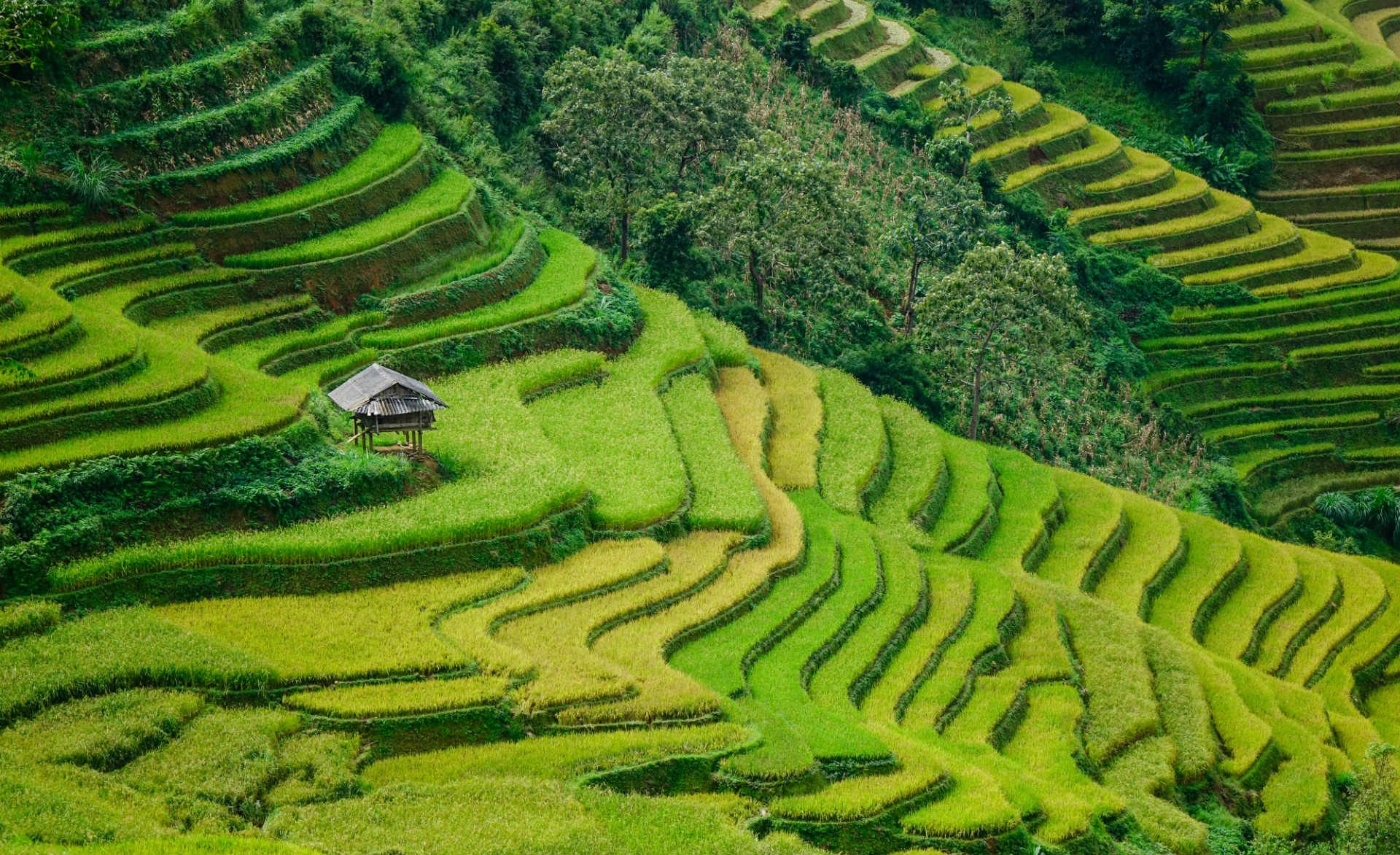
Make sure to visit the rice fields in Sapa © Shutterstock
Not sure about the best time to visit Vietnam? We divided Vietnam's weather by month to help you decide the optimal time for your visit, ensuring that you're prepared for whatever climatic nuances each region has to offer. From the chilly winters in the north to the tropical summers in the south, here's what you can expect in terms of weather throughout the year in this captivating country.
Visiting Vietnam in January
In January , cold winter weather hits the north . This is often accompanied by fine persistent mists, which could spoil your views at Ha Long Bay. There’s also the chance of ground frost in higher regions, or even a rare snowfall. Don’t let it put you off outdoor activities though – while January is the coldest month in mountainous areas, such as Sa Pa, rainfall is at its lowest, making perfect trekking conditions. Hanoi averages a pleasant 20ºC.
The southern end of the country is firmly into the dry season come January, so it’s a good time to explore cities such as Ho Chi Minh . And for post-city downtime make for beaches within easy reach of the capital, such as at Phan Thiet and Mui Ne . It’s a fantastic time to try water-related activities, such as diving , around Phu Quoc.
Nha Trang and Da Nang beaches also start to beckon in January, as the central coast sees the tail end of the rains.
Visiting Vietnam in February
Vietnam sees optimum weather conditions all-round in February . The south and the central coast, are perfect for beach bums, with just a smattering of rain perhaps on the beaches between Hoi An and Da Nang. If you can tear yourself away from the sands near Da Nang to dip into the back streets of the city, you’re in for some of the best street food in Vietnam . The north sees the chill lifting, leaving clear and warm days for hiking and exploring the region.
Dominating the calendar is Tet , or the Lunar New Year, and the biggest festival in Vietnam. While it’s wonderfully festive throughout, note that much of the country shuts down during this period, such as restaurants and museums. Also, accommodation can be hard to come by, as the Vietnamese take their holidays, and the transport system is stretched.
Visiting Vietnam in March
In terms of the weather, March is perhaps the best month to visit Vietnam, especially if you want to see the whole country . Temperatures in the north are rising, making March a perfect time for adventure and trekking in the highlands and mountains. Clear skies around Ha Long Bay make it an ideal time to take a boat tour, stopping off at the beguiling Cat Ba Island.
Dry weather means you can visit the awesome Phong Nha Caves in Phong Nha-ke Bang National Park , which boasts the world’s biggest cave.
You can be sure of sunshine and hot days in the south, which means lazy days on the beaches and water-based activities are a must, also on beaches on the central coast, such as at Nha Trang.

Ha Long Bay, Vietnam © Shutterstock
Visiting Vietnam in April
Temperatures in the north are rising in April as summer approaches, and some rain is not uncommon. But it’s still very pleasant and great for hiking, with spring flowers in full bloom making the region especially beautiful.
The centre of Vietnam entices with blue skies and sunshine, so make for charming town of Hoi An and the nearby beach of An Bang, and the broad sands at Da Nang. Further south, Nha Trang is at its best. Temperatures in the city of Hué are agreeable and the highlands experiences great weather at this time.
There's a chance of some rain in southern Vietnam, but with mostly clear skies and temperatures hitting 31ºC it’s still great for sun worshippers on the south’s beautiful beaches.
Visiting Vietnam in May
The south is getting wetter in May as it moves into its monsoon season , but it’s easy to avoid the short afternoon downpours. The north is hotting up and seeing more rain, although it’s still mostly dry and great for exploring the great outdoors. The central coast is the place to be this month , with hot, sunny days.
Visiting Vietnam in June
June isn't the best time to visit Vietnam. The rainy season in the south is in full swing and floods are common, and rainfall is increasing in the central highlands. The north is heating up and getting wetter too, meaning trekking can be hazardous – so bring appropriate footwear and outer layers if that’s on your itinerary. But don’t let the rain deter you from visiting Vietnam. The central coast is at its best , so perfect for idling away some time on the beaches near Hoi An, Da Nang and Lang Co, and the south still has plenty of dry hours in the day. Hanoi in the north and the Mai Chau Valley are still mostly dry. Added to which, visitor numbers in Vietnam tend to be fewer in June.
Read all about the weather in Vietnam in June .
Visiting Vietnam in July
July is a similar story to June: heavy downpours occurring at both ends of the country. Temperatures reach their peak in the north and the central coast is a searing 31ºC, on average. But if you don’t mind a roasting, it’s still a good month to hit the beaches, as there are still plenty of clear days, and the rain offsets some of the heat. Rain in the central highlands means trekking conditions are poor. Also, transport can be more complicated, sometimes washing out roads and cutting off the more remote villages. Hanoi tends to be very wet.
Read all about the weather in Vietnam in July .
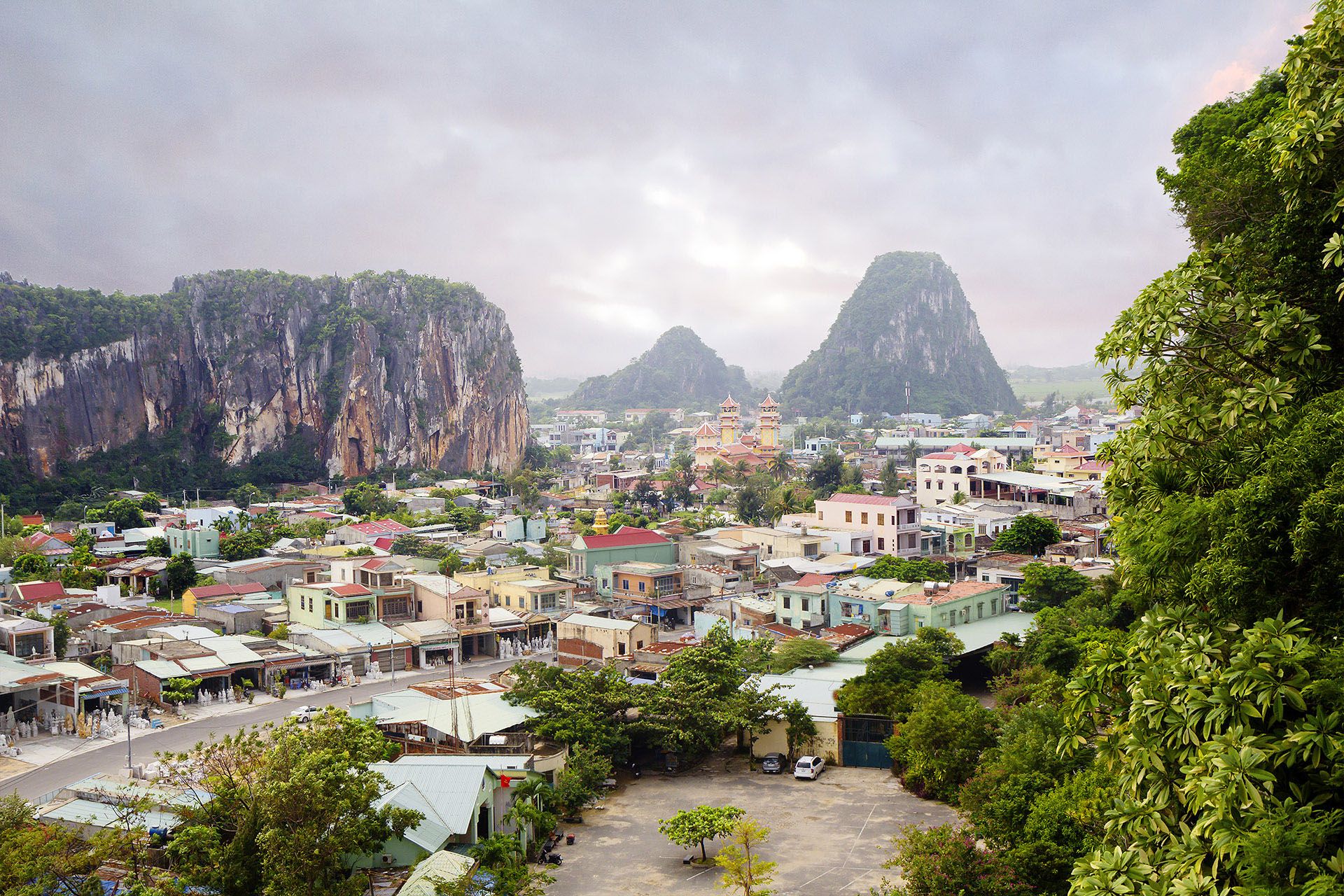
Danang, Vietnam © Galina Savina/Shutterstock
Visiting Vietnam in August
If you intend to trek in Vietnam, avoid visiting in August : the mountains of the north and the central highlands are experiencing peak rainfall now. And the deluge of rain at Ha Long Bay means you should forget about going on a boat tour this month. Conditions on the central coast are, on the whole, still pretty good, especially at Nha Trang , although the fine days are coming to an end. While the south is fully ensconced in its wet season, it’s not exactly a bad time to visit, with plenty of rain-free hours in the day to enjoy.
Visiting Vietnam in September
September is officially the start of the best time to visit Vietnam, although it can never be pinned down to months. The north and south are experiencing a similar story: temperatures are high but it’s getting drier, opening up the possibility of trekking once more in the north, around Sa Pa . The central coast and central highlands , however, are getting very wet indeed, with storms on the horizon.
Read all about the weather in Vietnam in September .
Visiting Vietnam in October
If trekking and other outdoor adventure activities are your bag and you’re wondering when to visit Vietnam, October is a great month. The sun puts its hat back on in the north, and dry weather makes for ideal conditions in Sa Pa and the Dong Van Karst Plateau Geopark in Ha Giang province. It’s a good time to explore the picturesque Mai Chau Valley, its rice fields a golden colour during the harvest season, against a backdrop of jagged mountains, and visit the minority White Thai villages.
Sunbathing in central Vietnam is over, however, as the rain dumps down, and storms make it difficult to get around. It’s best to avoid Hoi An, in October and November, when serious flooding can mean water in the streets can be knee- or waist high.

The Mekong Delta is a beautiful region to visit © Shutterstock
Visiting Vietnam in November
Balmy temperatures in the south and favourable conditions in the north make this an ideal month to visit either end of the country. Take your pick of the beaches in the south, or go trekking in the north. November is also the best time of year to visit Vietnam for a cruise at Ha Long Bay.
It’s a different picture along the central coast. The wet season starts with a flourish around Nha Trang, and be warned that when the northeasterly winter monsoon hits, the riptides between Da Nang and Hoi An become particularly dangerous.
Read all about the weather in Vietnam in November .
Visiting Vietnam in December
This is one of the most fun and certainly part of the best time to visit Vietnam. Most of Vietnam enjoys dry conditions and basks in sunshine by December . Central Vietnam is the exception, which is gradually emerging from its rainy season. So it’s a good time to head to the southern coast if you want to soak up some rays and rack up some time on Vietnam’s gorgeous beaches . Beaches such as Mui Ne, or on the island of Phu Quoc are great in this month.
It’s also a good time to visit Ho Chi Minh City , with temperatures averaging a comfortable 26ºC.
If you’re planning a Christmas getaway be aware that things get booked up way in advance, so plan ahead.
Outdoor activities in the north are good in December. It is somewhat chilly, however, especially in the mountains – so pack extra layers.

Celebrate Newyears in Hoi An © Shutterstock
The best time to visit Sapa, located in northern Vietnam, largely depends on what you're looking to experience. For those keen on trekking and enjoying the lush landscapes, the optimal time is between September and November or from March to May.
During these months, the weather is fairly stable with warm days and cool nights, offering clear skies and stunning views of the Hoang Lien Son mountain range. September to November showcases Sapa in full harvest season, offering golden terraced rice fields that are nothing short of breathtaking. On the other hand, if you're fascinated by cultural experiences, visiting during the Lunar New Year, usually falling in late January to mid-February, offers a unique insight into local traditions, although it will be quite cold.
However, be prepared for a wetter experience if you opt for a summertime visit, as June to August is Sapa's rainy season. While the landscape is incredibly lush, trekking can be more challenging due to slippery paths. Choose your timeframe according to your interests, whether it's trekking, cultural immersion, or landscape photography, and Sapa will not disappoint.
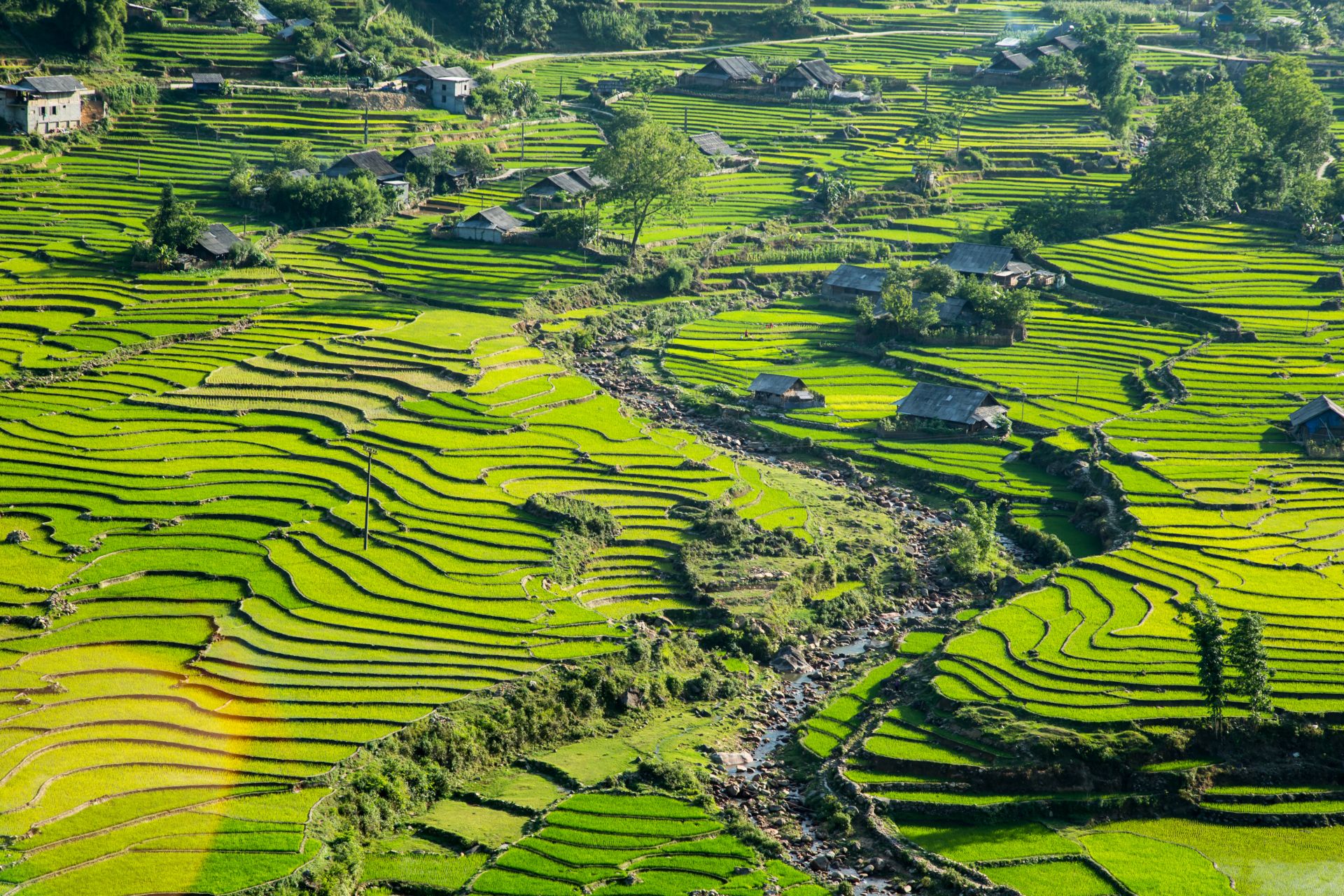
Come between September and November to see the rice fields! © Shutterstock
The best time to visit South Vietnam, including destinations like Ho Chi Minh City and the Mekong Delta, is from December to April. During these months, the region experiences dry, sunny weather with less humidity, making it ideal for urban exploration, river cruises, and tropical forest visits.
This is also a great time for beach activities along the southern coast. The absence of monsoons during this period means fewer disruptions to travel plans and more comfortable conditions for outdoor adventures. However, if you're interested in experiencing local festivals, the Lunar New Year, usually occurring from late January to mid-February, offers a unique cultural insight, albeit at a time when many services may be closed.
It's advisable to avoid the wet season from May to November if you're not a fan of high humidity and heavy rainfall, as these conditions can impact travel and outdoor activities. Overall, the dry months provide the most favorable conditions for a diverse range of activities and experiences in South Vietnam.
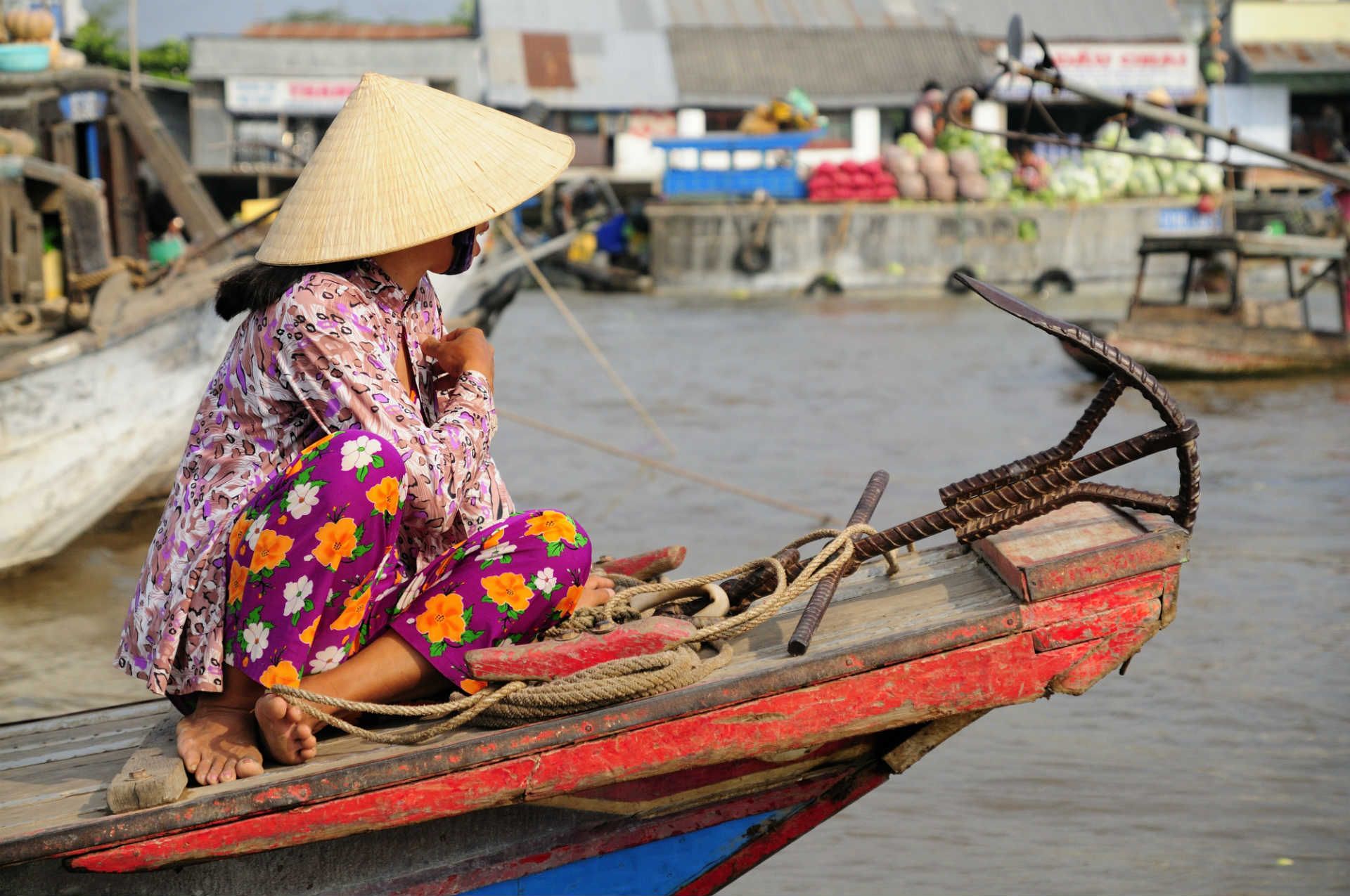
Floating market on the Mekong Delta in Vietnam © Shutterstock
The rainy season in Vietnam varies depending on the region:
- North Vietnam (e.g., Hanoi, Sapa ) : The rainy season typically lasts from May to September. During this time, the north experiences heavy rainfall, particularly in July and August. The mountainous areas like Sapa can be especially wet and slippery.
- Central Vietnam (e.g., Hue, Da Nang, Hoi An): The central region has its rainy season from September to December. This period often sees typhoons and very heavy rains, particularly in October and November.
- South Vietnam (e.g., Ho Chi Minh City, Mekong Delta): The rainy season here is from May to November. Rain usually comes in short, heavy bursts and is often at night, making it possible to still enjoy some daytime activities.
When you are deciding on when to go to Vietnam it's worth looking at the calendar of annual festivals, so that you can perhaps plot them on your itinerary.
The most important festival is Tet, the Vietnamese New Year, and lasts for seven days sometime between the last week of January and the third week of February. Families get together to celebrate and there's a party-like atmosphere in the cities, with colourful decorations adorning the streets, the scent of incense in the air, and glorious fireworks displays filling the skies.
The majority of festivals take place in spring, with a second flurry in the autumn months. One festival you might want to make a note of, however, is Tet: not only does most of Vietnam close down for the week, but either side of the holiday local transport services are stretched to the limit and international flights are filled by returning overseas Vietnamese.
TET: the Vietnamese New Year
If we're talking about the best time to visit Vietnam, we can't ignore TET. Tet or Tet Nguyen Dan, is Vietnam's most important annual festival lasting seven days. Typically falling between late January and mid-February during the new moon, Tet is a time for family reunions, welcoming ancestral spirits, and celebrating the New Year. Interestingly, everyone in Vietnam becomes a year older at Tet, as age is counted by the new year, not individual birthdays.
In preparation for Tet, the excitement builds, culminating in fireworks displays on the eve since firecrackers were banned in 1995. A week prior, the Ong Tau festival kicks off, honoring the god of the hearth. Families prepare by cleaning the house thoroughly and making offerings to Ong Tau.
Tet is a time for fresh starts. Debts are settled, and new clothes and haircuts are acquired if affordable. Charms for good luck are placed around homes, and the first moments of the New Year are considered crucial for setting the tone for the year ahead. The characteristics of the first visitor on Tet morning can also influence a family's fortune for the entire year, making this a significant aspect of the celebration.
What is Tet?
- Full Name: Tet Nguyen Dan
- Meaning: Festival of the first day
- Duration: 7 days
- Time: Last week of January to the third week of February, on the new moon night
- Purpose: Celebrate renewal and hope for the New Year, family reunions, and welcoming ancestral spirits.
When Does it Happen?
- Calendar: Falls on the new moon night between late January and mid-February.
- Counting Age: Everyone in Vietnam becomes a year older as age is reckoned by the new year, not individual birthdays.
Crucial Moments
- First Minutes and Hours: Set the pattern for the year.
- Avoid: Arguments, swearing, or breaking anything, especially during the first three days.
- The First Visitor: Good Luck or Bad Luck
- Ideal Visitor: Respected, wealthy, and happily married individuals are considered good luck.
- Avoid: Bereaved, unemployed, accident-prone, or pregnant visitors are considered ill-favored.
- Responsibility: The first visitor's attributes could affect the family's luck for the whole year.

Old Vietnamese man preparing altar with foods during TET ©Shutterstock
The Rough Guides to Vietnam and related travel guides
In-depth, easy-to-use travel guides filled with expert advice.

Travel advice for Vietnam
From travel safety to visa requirements, discover the best tips for traveling to Vietnam
- Crime and personal safety tips Vietnam
- Eating and drinking in Vietnam
- Getting around Vietnam: Transportation Tips
- How to get to Vietnam
- Travel Health Vietnam
- Shopping tips for Vietnam
- Sports and Outdoor activities in Vietnam
- Travel Tips Vietnam for planning and on the go
- Vietnam Weather in September
- Vietnam Weather in November
- Vietnam Weather in June
- Vietnam Weather in July
- Vietnam Weather in December
- Vietnam Weather in August
- Vietnam Weather in January
- Vietnam Weather in February
- Vietnam weather in March
- How to get from Hanoi to Halong Bay
- How To Get From Hanoi To Da Nang
- How to get from Hanoi to Sapa
- Vietnam Weather in April
- How to get a Vietnam visa
Find even more inspiration here

- Travel Tips
written by Rough Guides Editors
updated 09.04.2024
Ready to travel and discover Vietnam?
Get support from our local experts for stress-free planning & worry-free travels.
- Where to stay
- Travel advice
Help me plan my trip
Infographic - Best time to visit Vietnam (Travel Guide & Tips 2022)
Vietnam is blessed with cultural and natural attractions throughout the three regions which means each region and destination has its distinct ideal time for visiting. For first-time visitors to Vietnam , worry no longer! In this travel guide, we’ll show you in detail what to notice in the weather in Vietnam, the best time to visit Vietnam, and when and best places to visit Vietnam month to month in the most visualized and easiest way to follow. Are you ready?
Table of Contents
- 1.1 Here are Vietnam weather highlights
- 1.2 Peak Tourism Season in Vietnam
- 2 Best time to visit Vietnam
- 3.1.1 Vietnam Weather in January
- 3.1.2 Where to travel to Vietnam in January
- 3.2.1 How Vietnam’s weather like in February is like?
- 3.2.2 Where to visit Vietnam in February
- 3.3.1 Weather in Vietnam during March
- 3.3.2 Vietnam destinations for March
- 3.4.1 Vietnam weather in April
- 3.4.2 Best places to visit Vietnam in April
- 3.5.1 Weather in Vietnam during May
- 3.5.2 Where to visit in May
- 3.6.1 Vietnam weather in June
- 3.6.2 Where to go in Vietnam during June
- 3.7.1 Vietnam weather in July
- 3.7.2 Where to visit Vietnam in July
- 3.8.1 Vietnam Weather in August
- 3.8.2 Where to visit in August
- 3.9.1 Vietnam Weather in September
- 3.9.2 Where to visit in September
- 3.10.1 Vietnam Weather in October
- 3.10.2 Where to visit in October
- 3.11.1 Vietnam Weather in November
- 3.11.2 Where to visit in November
- 3.12.1 Vietnam Weather in December
- 3.12.2 Where to visit in December
Brief Guide on Vietnam Weather Characteristics
Here are vietnam weather highlights.
North Vietnam – North Central Vietnam : four seasons with winter lasting from December – February, temperature dropping, and low humidity. Summer from June to August is hot, rainy, and humid.
Central Vietnam : Tropical wet climate or a tropical monsoon and trade-wind littoral climate. The hot temperature is almost all year round. Drier months last from November to April while in the summer months the region suffers from storms and flooding.
South Vietnam : only dry and wet season while the temperature remains high all year round. The wet season lasts from November to April and the wet season is from May to October.
Peak Tourism Season in Vietnam
For foreign tourists, the peak season of tourism in Vietnam starts around December and goes all the way to the end of March of the next year . These months fall right in the dry season of North Vietnam and Central Vietnam while in South Vietnam, it’s just the perfect time of flooding season in the Mekong Delta when life comes back to the vast plains and wet forests.
Best time to visit Vietnam
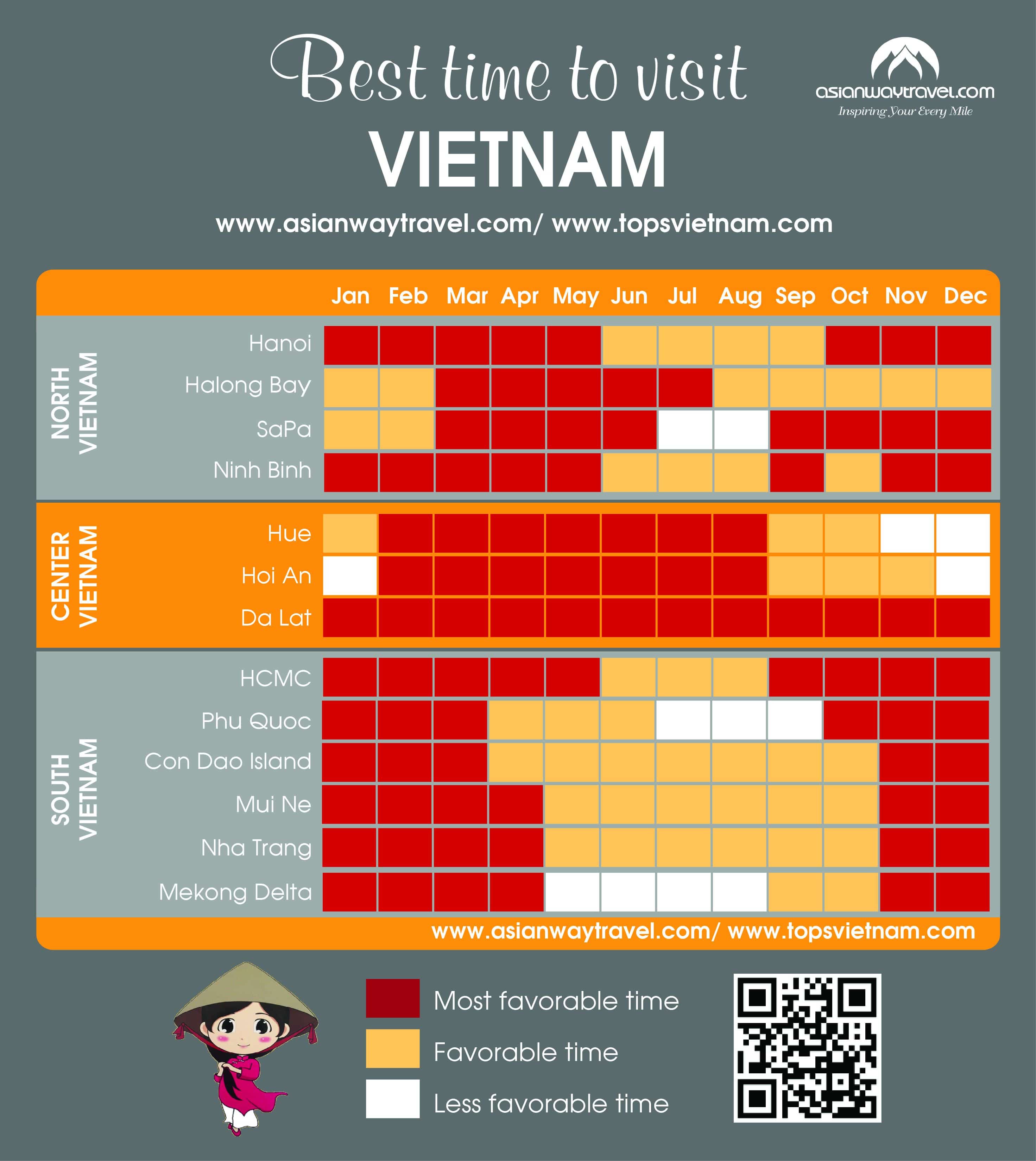
Vietnam’s weather month by month (Best places to visit Vietnam in each month)
Vietnam weather in january.
January in Vietnam is one of the best months for tourism activities and also the month with the most diverse weather characteristics throughout the country. January is the first month of the year in the Gregorian calendar but the last month in the Lunar year. This makes the atmosphere in Vietnam generally bustling, festive, and happy. North Vietnam in January is blessed with the prime of winter which brings almost no rain, dry air, and low temperature (avg. 10-15 degrees Celsius). Water activities in Halong Bay, Cat Ba island, and other beaches in north Vietnam are quite impossible because of the cold temperature. In Sapa, there’s a chance that it might snow. Central and South Vietnam in January are warmer than North Vietnam with an average temperature of 20 and 30 degrees Celsius. If you’re seeking some tropical sunlight then we suggest you go south.
Where to travel to Vietnam in January
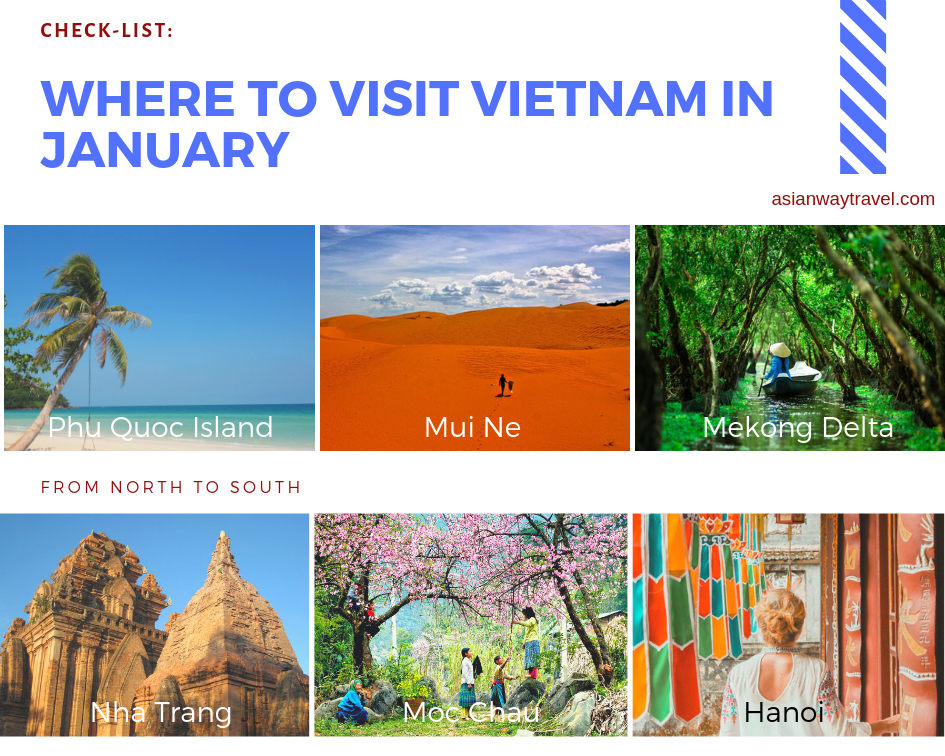
How Vietnam’s weather like in February is like?
Not much different from January, February has dry, bright weather across the country with temperatures raising southward. This month is also the first month of the lunar new year, so you can you the festive atmosphere of the most important holiday in Vietnam everywhere you go.
North Vietnam still is in wintertime, with clear skies with little rain which bring a certain romantic feeling to the new year since people say if it rains on the first day, the whole year will be lucky. Northern mountainous areas are covered in pastel colors of plum, apricot, and peach blossoms with the backdrop of grey mountains.
The weather in Central and South Vietnam offers a great condition for a beach break with clear, sunny skies and warm seawater. The average temperature is from 25-27 degrees Celsius.
Where to visit Vietnam in February
Like January, you can visit a lot of places in Vietnam during February, especially since February is a season of flowers. As mentioned, this month is lunar new year month, so you should visit major cities to enjoy the culture and cuisine. Come to north Vietnam plateaus to breathe in the fresh air and enjoy the natural landscape of spring blossoms. Drift south if you want to work on your tan and enjoy the water. Da Lat also sees the beautiful sight of cherry blossoms at this time of year. If you have more time, you can also combine your Vietnam Trip with Cambodia. February is one of the best months to visit Vietnam & Cambodia
Weather in Vietnam during March
March is one of the best months to discover Vietnam with ideal weather suitable for all kinds of activities. In North Vietnam, March is not as cold and dry as January and February while in central and south Vietnam, it’s warm and dry. March is the month that many festivals are held throughout the country, of which the most bustling and important is the Perfume Pagoda festival. People from all parts of the country come here to pray for luck, health, and happiness in the upcoming year.
Many central coast cities in this time turn into beach paradises with warm water, mild weather, and pristine culture. Southern islands are still the places to go for high blue sky and sunny beaches.
Vietnam destinations for March
It’s not at all to choose where to visit in Vietnam in March. It’s the month for almost all destinations both famous attractions and off-the-beaten-path destinations.
Tay Nguyen at this time has white coffee flowers season blooming all over the place and also the most bustling festival in the area – Elephant Racing Festival.
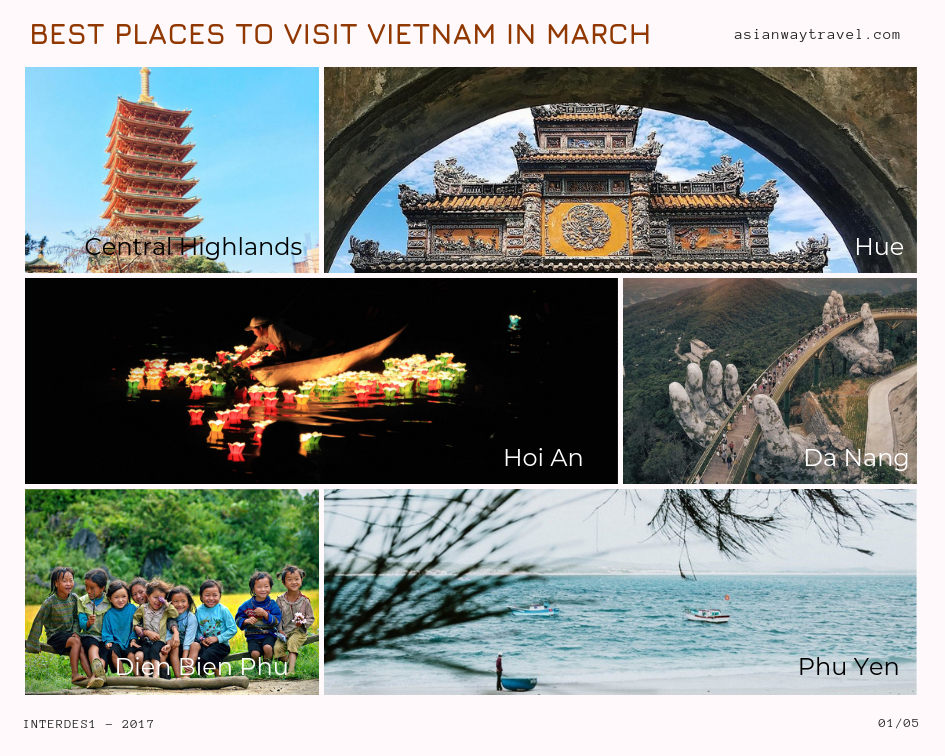
Vietnam weather in April
April marks the end of tourism peak season in Vietnam. It’s the last month of spring, wrapping up the festive season of Lunar New Year as well as the winter in North Vietnam. From this month onward, the average temperature and humidity throughout the country rise. Still, the weather in March is still much milder than the summer months and there’re still many things to do and places to see at this time of year.

Ninh Binh can be visited almost all year round. In North Vietnam, it’s getting warmer with fewer cold days, and slightly rainier but you can expect plenty of dry days to see around. In Central and South Vietnam, it’s not different much from summer with an average temperature of 25-33 degrees Celsius.
April is also a historical month in Vietnam history, marking the reunification of the whole country after the Vietnam-America War.
- Best places to visit Vietnam in April
Hanoi in April turns vibrant red with the flags and flowers everywhere you go. Perfume Pagoda in the suburb of Hanoi is also in the month it’s most beautiful and less crowded since the festival ended.
April is also the month to visit Vietnam’s best beaches and islands like Halong Bay, Co To Island, and Ly Son . In North Vietnam, it’s the time farmers water the rice fields, making a gorgeous sight of nature.
In central Vietnam, April is ideal to visit Da Nang city with an average temperature of 27-29 degrees Celsius. The beaches have blue water and calm waves.
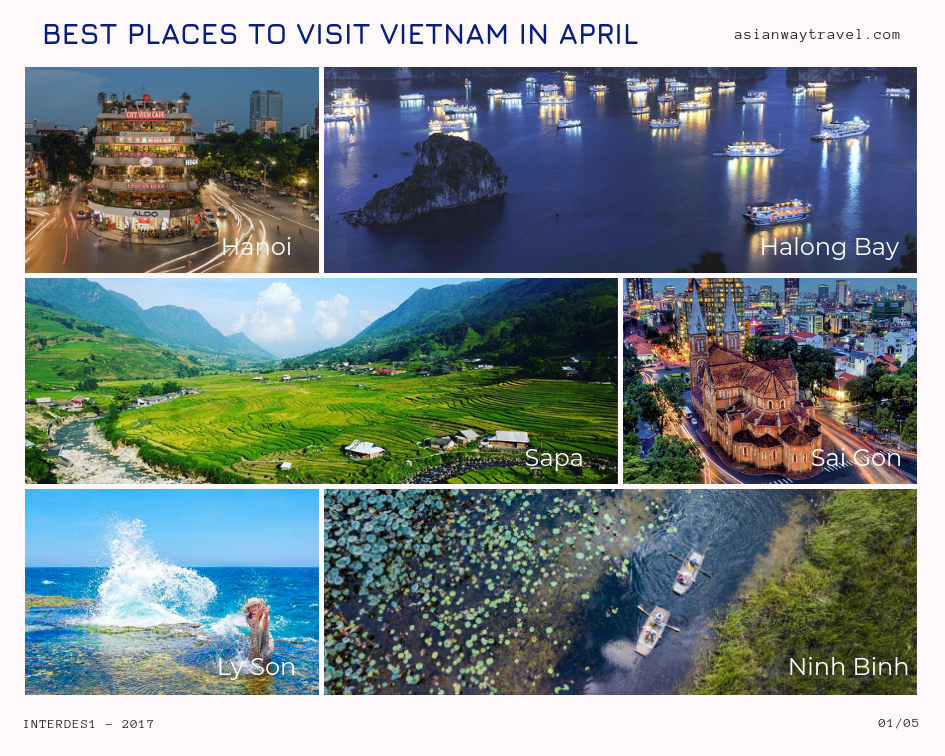
Weather in Vietnam during May
May is the month right before summer hits north Vietnam. You can see the season changing in north Vietnam so blatantly and beautifully. The sun shines, nice breezes, and the temperature rise slightly to 30 degrees Celsius. However, you can barely feel the heat in early May. The rain happens more frequently but also ends quickly.
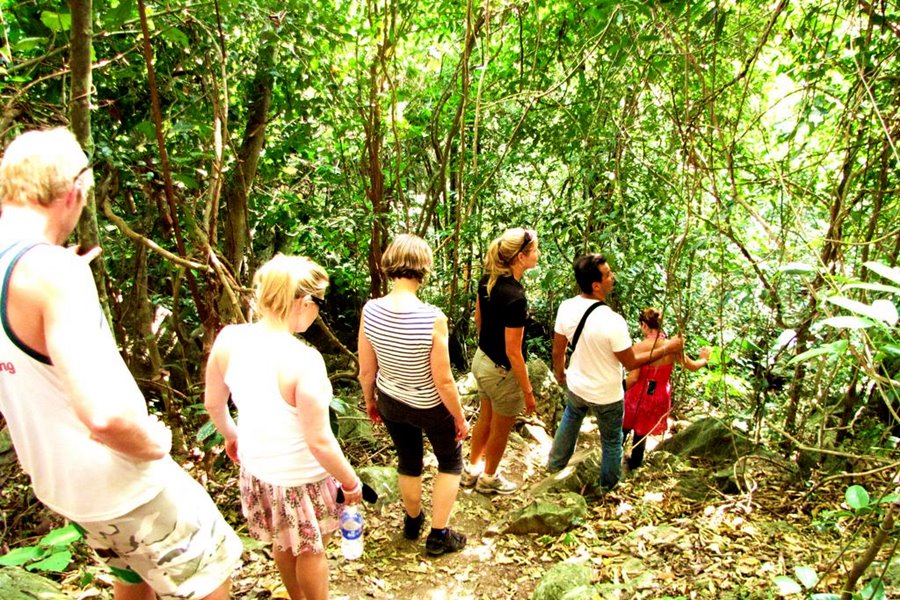
Throughout the country, the summer holiday for students is about to start so you can feel a certain excitement of Vietnamese people. In central and south Vietnam, the rain starts to happen more but not as frequently as in the north. May is a great time to visit the major cities of Vietnam. Like April, May is also a historical month with two important events: Dien Bien Phu Victory on May 7 and Ho Chi Minh’s Birthday on May 19.
Where to visit in May
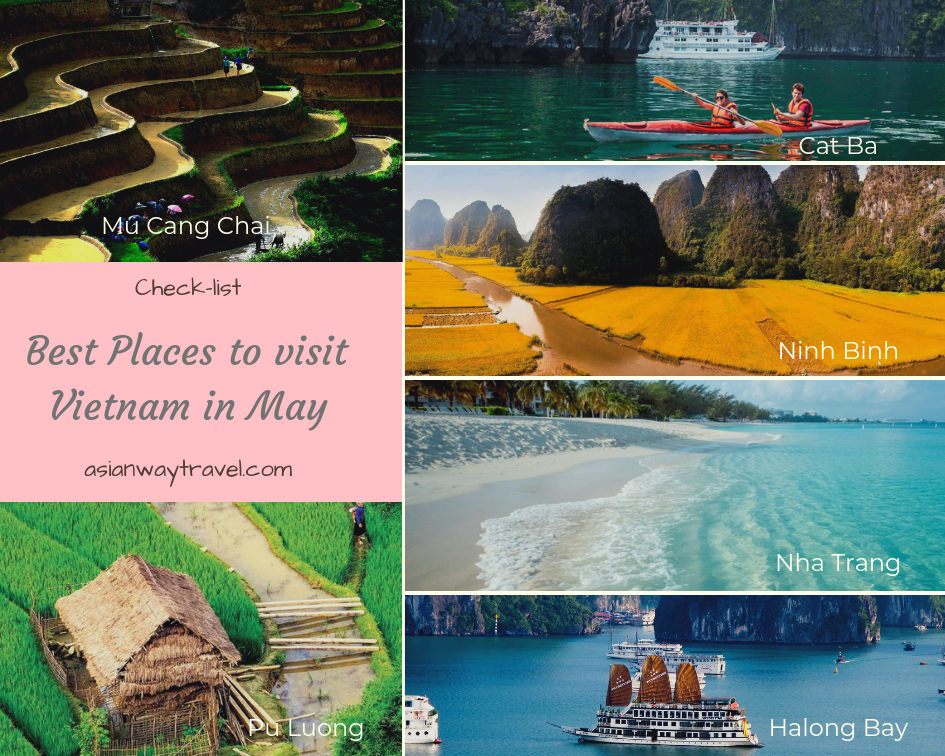
Vietnam weather in June
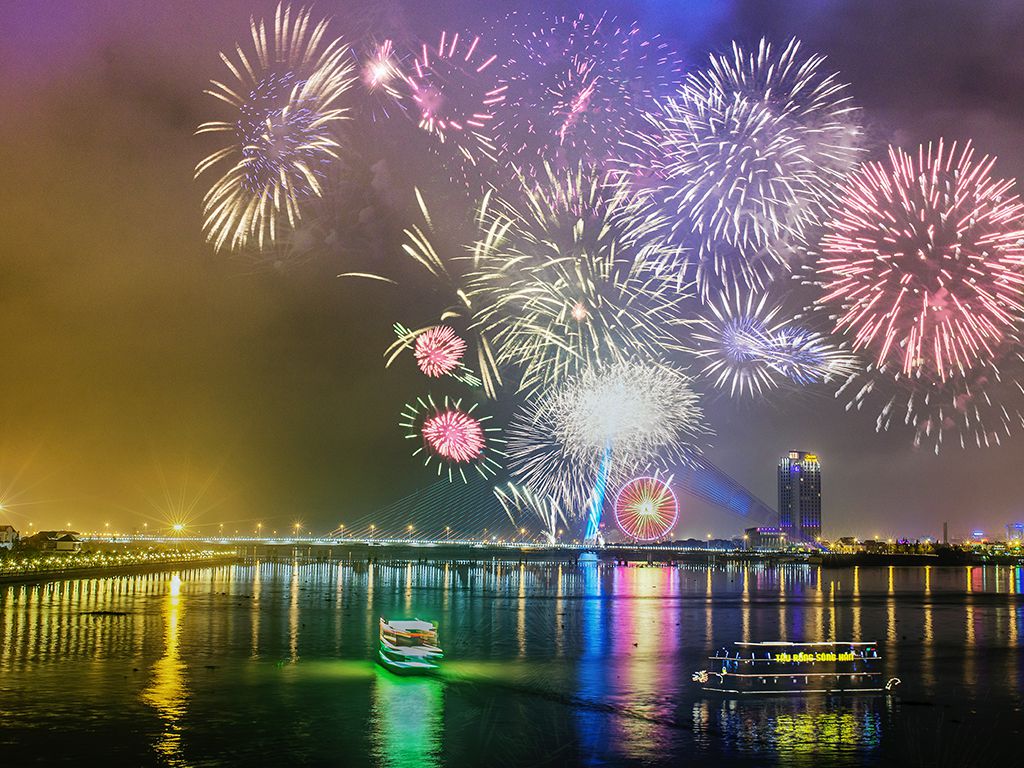
Where to go in Vietnam during June
Halong bay , southern islands, and coastal line cities are the best destinations in Vietnam during June. Con Dao island has not only endless blue beaches but this month, it’s the month of turtles hatching season. Halong Bay is bluer than ever and Da Lat is one of the best places to stay away from the heat and enjoy the cool air.
Coastal cities have not only pristine beaches but also rich local culture. Nha Trang, Da Nang and Hoi An are the best places to go in this month. >>> Best Vietnam tours in June:
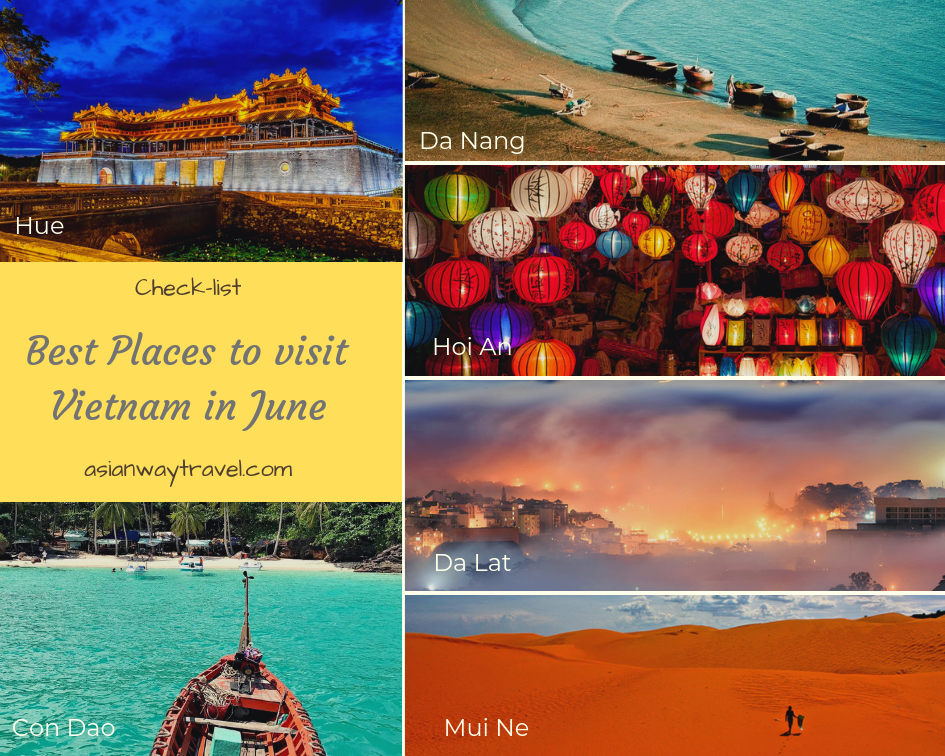
Vietnam weather in July
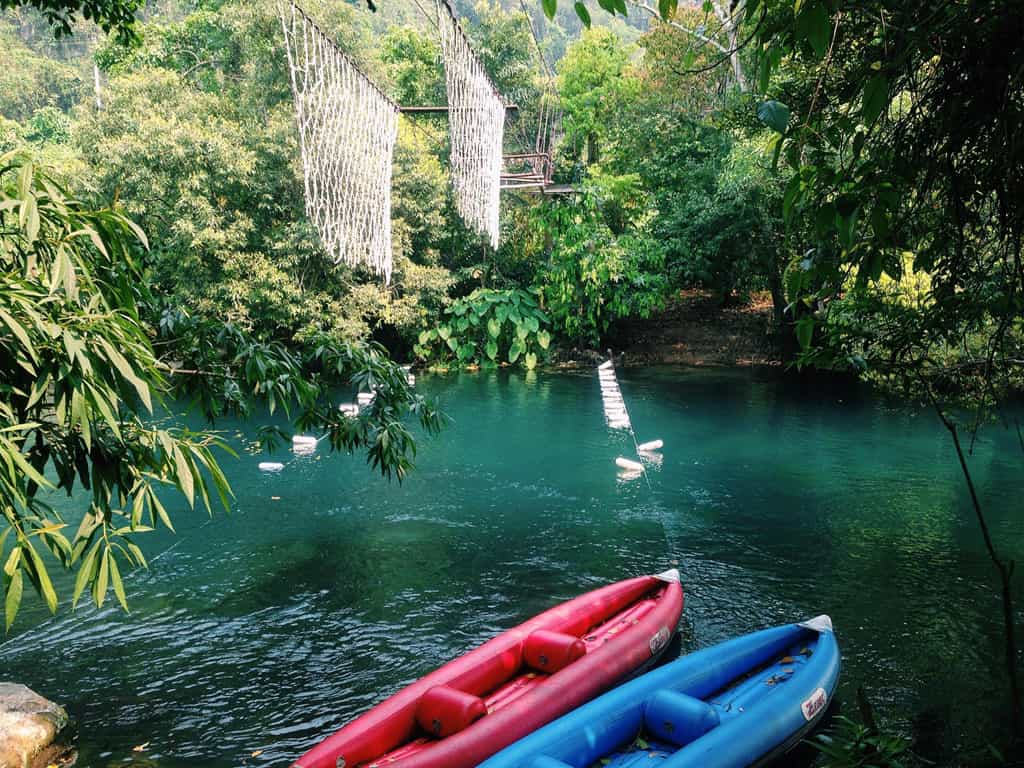
Where to visit Vietnam in July

Vietnam Weather in August
Where to visit in august.
August is a great month to explore the caves in Phong Nha Ke Bang and Halong Bay , relax on the white beaches of Cat Ba island, Nha Trang, stroll the ancient town of Hoi An, and have fun with sand sliding in Mui Ne . However, Mekong Delta isn’t ideal since it’s the rainy season this month while trekking to mountainous areas in North Vietnam can be dangerous. When there’re typhoons, stay away from the coastal beaches of the area where the typhoons hit.
Recommended Vietnam tours in August: Spirit of Vietnam and Cambodia – 17 Days Vietnam Essential Tour – 7 Days Vietnam Travel Line – 14 Days Pin our August check-list for later:
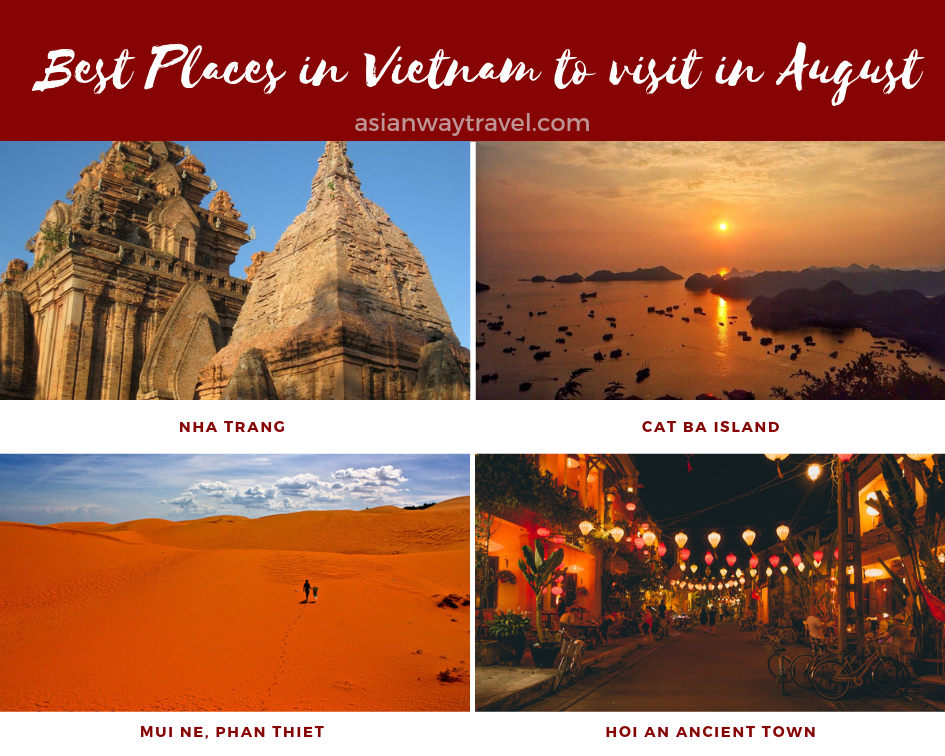
Vietnam Weather in September
As one of the best months to visit Vietnam, September offers diverse weather conditions and natural landscape features across the country. September is also the end of summer with the temperature dropping significantly. In northern Vietnam, there is still rain but not as heavy as rain in June – August. While in central highlands, it rains more frequently. In the south, rain is less and less while Mekong Delta enters its flooding season.
Cat Ba Island and Halong Bay have great conditions to enjoy the water and the scenery. Mountainous areas start their harvesting season: terraced rice fields turning golden.
Where to visit in September
Northwest Vietnam in general and Mu Cang Chai, in particular, becomes a real cultural paradise with its gorgeous endless terraced rice fields and rich local culture. Bach Ma National Park in Hue should be your off-the-beaten path to explore. Mekong Delta is just so beautiful in the flooding season. September brings a romantic atmosphere to Hanoi.
Phong Nha Ke Bang is closed in its flooding season (September – November) and Hoi An suffers more rains in this month.

Vietnam Weather in October
Autumn officially arrives in North Vietnam when October starts: the skies are blue, cooler breezes, and bountiful treats. Rain is lesser, the air is drier and the temperature drops a little bit further.
The beauty of the northwest in October is in its prime. When you go to a higher altitude, the air gets chillier. In central Vietnam cities like Hue, Hoi An, and Da Nang, the rain continues but doesn’t make these cities any less beautiful than themselves in any other month.
In the south, the average temperature is fixed at 24-31 degrees Celsius with much less rain.
Where to visit in October

Vietnam Weather in November
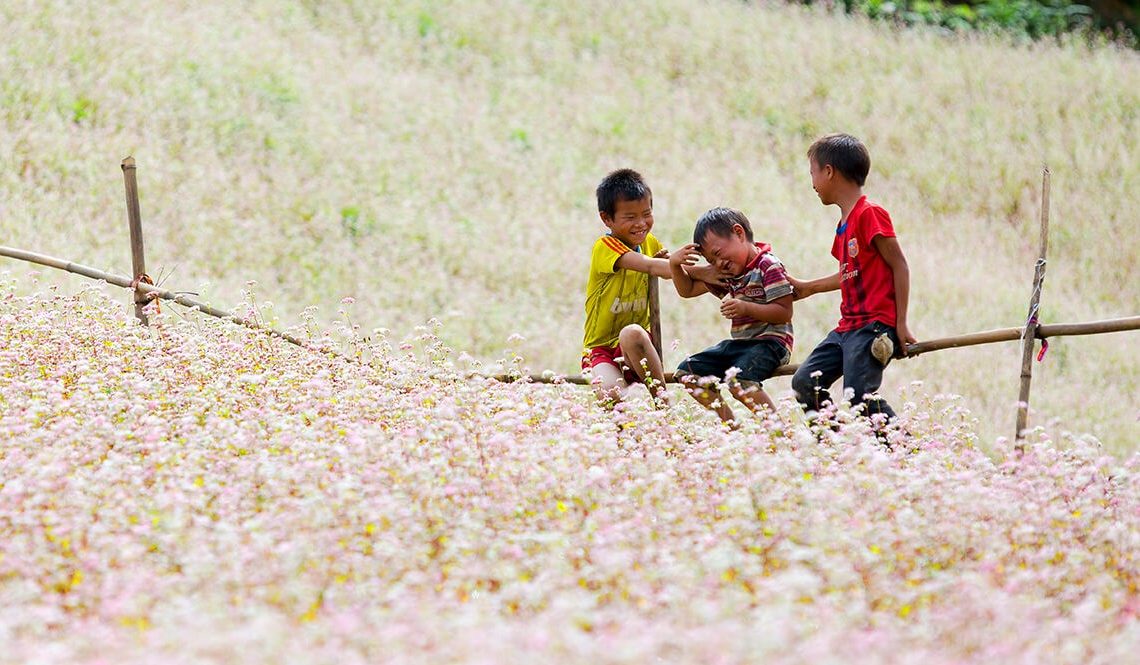
Where to visit in November

Vietnam Weather in December
Where to visit in december.
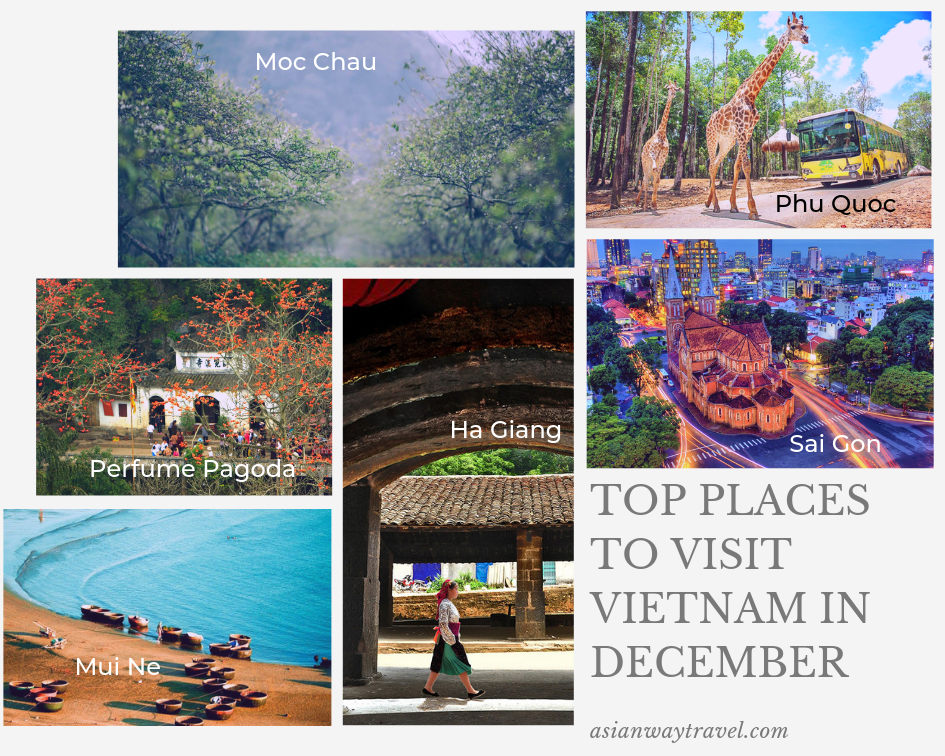
Share this:
- 479 Shares
- Best places to visit Vietnam in August
- Best places to visit Vietnam in December
- Best places to visit Vietnam in Feburary
- Best places to visit Vietnam in January
- Best places to visit Vietnam in July
- Best places to visit Vietnam in June
- Best places to visit Vietnam in March
- Best places to visit Vietnam in May
- Best places to visit Vietnam in November
- Best places to visit Vietnam in October
- Best places to visit Vietnam in September
- things to do in vietnam
Related Posts
10+ amazing things to do in ninh binh.
Since Ninh Binh was the filming location for the famous movie ‘Kong: Skull Island’, it’s such an unnecessary thing to mention how beautiful and dramatic the landscape of Ninh Bi...
11+ Best Vietnam Landscape
Vietnam makes a terrific destination to travel for nature: Vietnam landscape are diverse, there’s always something to do and see during the year and the auxiliary services are p...
Best Places For Vietnam Honeymoon Vacation
Either you’re going to Vietnam for a date or an important event like honeymoon vacation, you won’t be disappointed. With beautiful landscape, romantic settings and peaceful atmo...
Most Fun and Educational Things to do & see in Vietnam with Kids
If you're traveling to Vietnam with kids, especially for a long duration, you can expect a lot yet there are many work to do and prepare for your trip to be as exciting, safe an...
Top Beach Paradises in Vietnam You Might Not Know About
Vietnam is blessed with a long stretching coastline of over 3000 kilometers from north to south. This geographic characteristic has given Vietnam so many beach paradises which c...
Top Destinations
- Things to do in Vietnam
- Things to do in Hanoi
- Things to do in Sapa
- Things to do in Halong Bay
- Things to do in Mai Chau
- Things to do in Ninh Binh
- Things to do in Hue
- Things to do in Hoi An
- Things to do in Danang
- Things to do in Nha Trang
- Things to do in Ho Chi Minh City
- Things to do in Phu Quoc
- Things to do in Mekong Delta
- Things to do in Can Tho
- Things to do in Cambodia
Related Tours
10 Days A Glance of Vietnam & Laos
From $895 - 10 days
Duration 10 days
Destinations Hanoi - Ninh Binh - Halong ...
Tour style Classic & Culture Tours
Price from US$ 895 / person
14 Days Honeymoon in Vietnam & Cambodia
From $1185 - 14 days
Duration 14 days
Destinations Hanoi - Halong - Nha Trang ...
Tour style Honeymoon & Romance
Price from US$ 1,185 / person
4 Days Discover Danang and Hoian
From $255 - 4 days
Duration 4 days
Destinations Danang - Hoian
Price from US$ 255 / person
4 Days Discover Nha Trang Coastal City
From $228 - 4 days
Destinations Nha Trang
Price from US$ 228 / person
4 Days Saigon & Nearby
From $170 - 4 days
Destinations HCMC - Cu Chi - Mekong Delta
Price from US$ 170 / person
Free and Tailor-made Inquiry
Send us a quick inquiry so that we can offer you an itinerary with price for your information. This short inquiry is FREE and NOT a commitment for booking.
- Destinations
- Travel Guide
- Things to Do

Vietnam’s geography means its climate isn’t uniform. The country can be broadly categorized into three main climatic zones: North, Central, and South.
- Northern Vietnam (Hanoi, Sapa, Ha Long Bay): Cold winters from November to April and hot summers from May to October.
- Central Vietnam (Hue, Da Nang, Hoi An): Hot and dry from January to August, with rains from October to December.
- Southern Vietnam (Ho Chi Minh City, Mekong Delta): Tropical with two main seasons – wet (May to November) and dry (December to April).
Understanding these patterns is vital for planning your visit. For instance, if you’re thinking of trekking in Sapa, the cooler months would be ideal.
Highlights:
- Distinct climatic zones.
- Northern cold winters and hot summers.
- Central dry heat and rainy seasons.
- Southern tropical climate.
Travel Tip: Always carry light rainwear if traveling during the wet season, as showers can be unpredictable!
19 Unique Places to Visit in Spain
Best Time for Beach Lovers

For sun-chasers and beach bums, Vietnam is a paradise, but timing is essential. Beach destinations like Da Nang , Nha Trang , and Phu Quoc are most inviting between January and August when the skies are clear, and the seas are calm.
However, beaches in the North like Sam Son or Cat Ba are better from May to October. Regardless of when you go, Vietnam’s coast promises golden sands, azure waters, and a chance to bask in tropical glory.
- Beaches are best from January to August.
- Northern beaches are exceptions.
- Golden sands and clear waters.
Travel Tip: Remember to check local weather updates, as Central Vietnam occasionally faces storms or typhoons.
Best Time for Cultural Explorers

For those with a thirst for culture, Vietnam doesn’t disappoint. Timing traditional festivals can make your trip even more memorable. The Tet Festival (Lunar New Year ) which occurs around late January to mid-February is a vivid showcase of Vietnamese traditions.
Historical sites like the temples of My Son or the Imperial City of Hue are best enjoyed in the drier months when the weather is pleasant. Avoiding the rainy season ensures these ancient sites are preserved and prevents any access issues due to flooding.
- Tet Festival for a cultural deep dive.
- Dry months for historical sites.
- Rich and varied traditions.
Travel Tip: If visiting during Tet, book accommodations and transport in advance, as it’s a major holiday and many services are booked solid.
Best Time for Adventurers

For adrenaline junkies, Vietnam’s diverse landscape offers much. Treks in Sapa , exploring the world-renowned caves of Phong Nha , or motorbiking the Hai Van Pass are adventures to cherish.
The cooler months from October to April are ideal for trekking in Northern regions like Sapa, as the paths are less muddy and the views, unparalleled. For caving, the dry season is best to avoid the high water levels in the caves.
- Cooler months for Northern treks.
- Dry season for cave explorations.
- Diverse adventure opportunities.
Travel Tip: Always have a local guide when trekking or caving. They know the terrains and can ensure a safe and enriching experience.
19 Best Summer Vacation Spots for Families
Best Time for Food Enthusiasts

Vietnamese cuisine is a symphony of flavors, and certain dishes are seasonal. Summer brings a bounty of tropical fruits like mangoes and lychees, while autumn is perfect for moon cakes during the Mid-Autumn Festival.
Street food tours in cities like Hanoi or Ho Chi Minh City are enjoyable year-round, but the cooler months make the experience even more pleasant. And who can resist a steaming bowl of Pho on a cool day?
- Seasonal dishes and fruits.
- Year-round street food delights.
- Culinary adventures at every corner.
Travel Tip: Be adventurous but ensure you eat at places that are busy and have a good turnover, indicating fresh produce.
Avoiding Tourist Crowds

While the best time to visit Vietnam often coincides with peak tourist seasons, there are ways to escape the crowds. Opting for off-peak seasons or exploring lesser-known destinations can give you a more authentic experience.
For instance, instead of the bustling streets of Hanoi, consider the serene beauty of Mai Chau. Similarly, while Ha Long Bay is often crowded, nearby Bai Tu Long Bay offers similar karst landscapes with fewer tourists.
- Off-peak seasons for fewer crowds.
- Lesser-known gems.
- Authentic Vietnamese experiences.
Travel Tip: Sometimes, visiting a popular site early morning or late afternoon can help you avoid the tourist rush.
Cost Considerations: High vs. Low Season

Your budget can influence the best time to visit Vietnam . High season, which generally includes the times around Tet and summer vacations, sees a surge in prices for accommodations and attractions. On the other hand, the low season, marked by monsoons, might offer attractive discounts.
While accommodations in major cities remain relatively stable, tourist hotspots like Hoi An or Phu Quoc might see a significant price jump during peak seasons.
- High season price surges.
- Off-season discounts.
- Variable costs across destinations.
Travel Tip: Flexibility in travel dates can help you get better deals, especially if you’re open to last-minute bookings.
Deciding on the best time to visit Vietnam hinges on your preferences – be it basking on beaches, diving into cultural fests, or seeking adventures. With its varied climates and myriad attractions, Vietnam promises unique experiences at any time of the year. Plan with intent, embrace flexibility, and Vietnam will unfailingly charm you with its beauty and diversity.
Related Stories
Avoid the crowds: best days to fly for thanksgiving, christmas, and new year’s, 7 things travelers need to know before visiting cairo, 5 safest countries in latin america for travelers, best places to visit in ireland – our top..., top tourist attractions in singapore, top tourist attractions & places to visit in bali, the best tourist attractions in spain: discover the rich..., beautiful lakes in new jersey: exploring the best lakes..., best beaches on anna maria island: a comprehensive guide, popular categories.
- Destinations 73
- Travel Guide 62
- Things to Do 29
- Activities 10
- Travel Tips & Hacks 9
- Travel Resources 6
LEAVE A REPLY Cancel reply
Save my name, email, and website in this browser for the next time I comment.
Notify me of follow-up comments by email.
Notify me of new posts by email.
Quick Access
- Privacy Policy
- Terms of Service
- Sponsored Posts
- Zero Forex Broker
Enjoying my content?
Make this choice and from now on, you will forever be a part of every adventure!
- Ho Chi Minh City

- Planning A Trip
Best Time to Visit Vietnam: When to Go & What to Expect
"When is the best time to visit Vietnam" is one of the most common questions that spring up to mind for all trip planners. Finding a time that fits well with your precious holiday, comes with amicable weather and is not packed with other visitors may seem an utopia in this booming age of tourism. Though you may not afford to plan it exactly as advised or find a solution to all your expectation, you can always "make do with" the next best option. Here comes a very convenient truth: anytime can be a good time to visit Vietnam.
- 1. If you want good weather
- 2. If you want to experience festivals
- 3. If you want to offer your family the best holiday
- 4. If you are mostly interested in beach escape
- 5. If you want to avoid the crowd
- 6. If you want great deals
The opposing monsoonal season spreading from the North to the South, the multiple types of terrains and landscapes, the high and low altitudes give the country a little bit of everything: you can get layered with warm clothes at one destination only to find yourself sunbathing under the scorching sun on the next leg of your very same trip. Beautiful as it may sound, the diverse weather patterns across the country also poses a dilemma: you cannot find a month that has perfect weather all throughout. To put it simply, each month and each season in Vietnam will meet some of your expectations, but not all.
If you want good weather
... take your trip in March-May or October-early December
Vietnam weather between March and May is quite steady and consistent across the whole country, with medium-high temperature and very little rain. It hardly gets above 30°C and only rises significantly towards the end of May. Humidity is higher in the North (Hanoi, Halong Bay, Sapa) and Center (Hue, Danang, Hoi An) than in the South (Ho Chi Minh City, Nha Trang, Mekong Delta) but in general more pleasant than the rest of the year.
The period from October-early December is cooler than the former, with temperature plunging to under 20°C in the Northern part of Vietnam. However the low humidity totally makes up for the fewer hours of sunshine: you will get cool breeze throughout the day, with some cities such as Hanoi being said to be at its best at this time of the year. There may be more rain as you travel south-ward, but the tempt is also higher and rain comes and goes quickly. If you spend the majority of time in the central region of Vietnam, March-May may be a better period as there are significantly fewer chances of downpours.
The balmy weather in these two periods is ideal especially if you want to spend time being outdoors, whether lazing on a Southern beach or ride a dirt bike up North. There are fewer risks for sunstroke, landslide, flooding or typhoon especially from March to May, and consequently lower the chance of trip cancellation.
If you want to experience festivals
... plan your trip for December - March
The period from late December up until March is a continuum of cultural events, both the Western-inspired and the thousand-year-traditions.
Toward the end of December, major travel destinations will be illuminated with Christmas trees and New Year countdown stages, offering you a glimpse into the modern day cultural values of Vietnamese. Churches and cathedrals normally celebrate the authentic holiday spirits with nativity scenes, prayers and carols. The larger downtown areas, however, are plainly covered with festive moods of Christmas decorations and musics. Youngsters normally seize the week from Christmas to New Year for hanging out with friends, dressed up nicely and celebrating the holiday season rather than joining family reunion (which is saved for Tet holiday).
Vietnamese have 2-3 days off for the New Year holiday, and many urban dwellers spend this short break on nearby beaches or popular travel destinations such as Halong Bay in the North and Dalat in the South. The city may temporarily look empty before the crowd returns in preparation for Tet holiday, which normally takes place from the end of January to mid-February (the actual date changes based on the Lunar calendar).
The most important event in Vietnam, Tet holiday or the Lunar New Year carries great momentum. It is a time to reflect on the past and look forward to the future, to pray for all the best to come, to sit down with the extended family and cherish the reuniting moments.
The period preceding Tet is totally worth your travel time: you will get to witness this once-in-a-year magnetic chaos. Supermarkets are flooded with red and yellow confectionery, streets are buzzing with more traffic as local residents shop for Tet and decorative trees sit abundantly on the sidewalk waiting to be picked. City and country areas will totally come alive, which is definitely a catch for visiting Vietnam at this time of the year.
On the actual Tet days, streets will be eerily quiet. Stores are closed, traffic will reduce to almost zero. You will get to see cheerful Vietnamese, young and old, men and women, dressed up in colorful clothes and paying visit to families and relatives, or crowding temples and pagodas hoping for a lucky year to come. Again, this happens only once a year - and regret/inconvenience will be the last thing that comes to your mind even though shops and services are mostly closed.
The period after Tet - from mid Feb till the end of March - is also dominated by cultural festivals. From the North to the South, spring is a special time for Vietnamese since the ancient history: it is a time to stay calm and laid-back, enjoying some travel or joining one of the many festivals such as Lim Festival (Bac Ninh), Perfume Pagoda (Hanoi), Yen Tu festival (Quang Ninh). In short, if you want to experience Vietnam's culture at its best, visit the country in the period leading up to March.
If you want to offer your family the best holiday
... consider March-May or November
It's not exactly in anyone's interest to haul their family around town in the blistering heat of summer (June- August) or under the staggering rain (September- early October) or the jam-packed traffic (December - February).
That leaves us with the two options: March-May or November, when the weather is calmest and the traffic is most acceptable. Spring is in full force from March and your kids will be just happy seeing the tropical flowers in full bloom.
Cool temperature and low domestic tourism volume also mean you get to experience any part of the country you would want: the sea, the mountain, the emerald bay, the rain forest, the highlands, the canals and even the cities. And in case you have enough of the exotic natural scenery, you can always bring your kids to visit a safari or amusement parks, such as VinWonders (Nha Trang, Phu Quoc, Nam Hoi An) or Sun World Park (Sapa, Halong Bay, Danang, Cat Ba).
If you are mostly interested in beach escape
... go for January or April-May
If you visit Vietnam in January: pick Southern beaches such as Nha Trang, Vung Tau and Phu Quoc. If you visit Vietnam in April-May: pick Northern and Central beaches such as Cat Ba Island, Thuan An, An Bang, My Khe or Ly Son Island.
The reason to plan your beach visit during these two periods is not just the temperate weather, low rain-fall, clear sky and gentle wind, but also because the beach is largely empty and perfect for your vacation. Vietnam's extensive coastal stretch is something one should not miss, and you can also do it well by scheduling the right time to visit.
Besides indulging yourself in the Pacific ocean water, you may also consider one of the many water-based activities such as snorkeling, scuba diving, paragliding or island tours. Vietnam is a beach paradise, and will not disappoint you in the least.
If you want to avoid the crowd
... leave late December - mid January, June-August weekends off your table
Everyone wants to include at least a few, if not all, of the must-do, must-see, must-eat on their list - and that, inevitably, leads to over-crowding.
If you prefer tranquility over the hustle-bustle, and can actually afford to alter your travel time for it, we recommend you to stay away from the two periods: late Dec to mid-Jan and all summer weekends.
It is a fact that the Christmas holiday is also the busiest inbound tourist season: hotels are booked, spas are booked, restaurants are booked, attractions are not booked but packed. Everyone seems to take their annual leave at this same moment and flock to the popular destinations. Many feel better when joined by a crowd, but if this is not you, avoid at all cost. This can save you some considerable budget too as peak season surcharges are popular during this time of the year.
Then comes the locals' precious summer holiday: weekends from June to August. Vietnamese hardly travel solo - most find joy in a crowded destination with their extended family. It is not uncommon that a group tour of 20-30 people belongs to the same family. Parents normally wait for their children to finish school before jamming themselves on the beaches. This period without doubt is the peak domestic travel season, and you may find yourself lost in vast ocean of domestic visitors, cheering out loud over alcoholic beverage, or screaming babies running all over the hotel lobby.
The best case scenario if you only have these months to spare: visit during the weekdays instead.
If you want great deals
... May and September are your friends
In terms of weather, May and September are quite pleasant to begin with. The heat wave has either not yet arrived, or already gone by these two months, and so are local holiday makers. Most tourist facilities lower their price during these two months to attract more visits and balance out their annual revenue sheet, which means you can save as much as 30% compared with peak tourist season.
What's more, you can find yourself at a deserted beach, an empty mountain trail, an exclusive swimming pool just for yourself. Golden sunshine is on from 7am to 7pm but without the severe intensity like the months in between. Weather- and money-wise, there is no better time to visit Vietnam than May and September.
You can find further information about temperature, humidity, rainy days and precipitation level with our monthly weather guide .
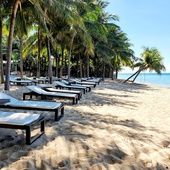
Latest Travel Alerts & Updates for Vietnam
Can I travel to Vietnam right now? What are the requirement? When can I expect to be allowed to travel to Vietnam? Find answers to these questions with our frequently updated travel alerts.

What $1 Can Buy in Vietnam
Although the cost of living has risen tremendously in Vietnam in recent years, you can still to live by with few dollars per day in your pocket. Below is a quick summary of what a dollar can be worth in various cities in Vietnam.
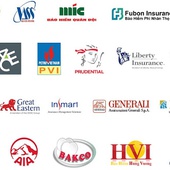
All-in-one Guide to Travel Insurance For Your Vietnam Trip
In many countries, purchasing and showing proof of a purchase for a travel insurance is a must as you apply for your travel documents. As you get a visa for Vietnam, you are not required to present one. But do you need one? YES, you will greatly benefit from well-picked travel insurance.
Featured Streets

Hang Thung - Street Of Buckets

Hang Bac - Street Of Silver

Hang Tre - Street Of Bamboos
Meet our experts.

Suggested Holiday Packages

- Customized Tour
When Is The Best Time To Visit Vietnam?

Vietnam is a captivating country in Southeast Asia that offers a rich cultural heritage, stunning natural beauty, and diverse ethnic diversity. However, Vietnam also has a complex and varied climate that can affect your travel plans and experiences. In this article, we will help you choose the best time to visit Vietnam based on the weather and climate by month. Whether you want to explore the historic capital of Hanoi, witness the spectacular scenery of Halong Bay, or relax on the tropical island of Phu Quoc, we will help you plan your trip to Vietnam based on when to go.
Before planning holidays in Vietnam, you might wonder when is the best time to visit Vietnam. The answer is quite simple and obvious: anytime is the best time.
Thanks to its long stretching terrace of over a thousand kilometers, Vietnam has a diversified climate from North to South although both of them are effected to monsoon climate. The Northern climate has four seasons with the northeast monsoon from October to December. The South has tropical climate with only two seasons: dry and wet, in which the south or southwesterly monsoon dominating from May to September. So figuring out the best time to visit Vietnam depends on which parts of the country you want to visit, unless you’re willing to be caught in a daily downpour or don’t mind fierce temperatures and high humidity.
If you want to see a bit of everything, you have to spend time studying the differences in regional weather. Autumn (Sep to Dec) and spring (March to Apr) are the most favorable seasons (they are also a high and peak season) to explore the whole country. However, traveling Vietnam in low season is an amazing experience. You can take advantage of less crowded tourist attractions and discount deals on services. Besides, you can enjoy the predictable shower rain in May to Oct which lasts only 30 to 60 minutes and brings fresher atmosphere when it ends. At Vietnam travel, we look at detailed weather factors and recommend how these might affect your holiday plans in Vietnam. Now, please have a look at our month to month guide to visit Vietnam.
Table of Contents
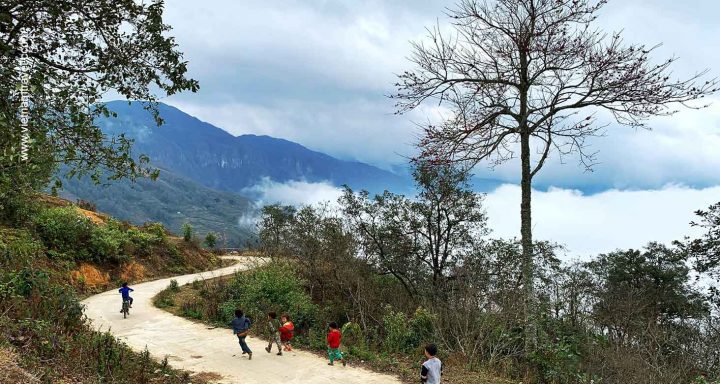
January is a dry month in Vietnam, with different temperatures in the north, central, and south regions. The north is the coolest, with an average of 18°C, while the south is the warmest, with an average of 26°C. The central regions have a moderate average of 23°C. The inland mountains may see some rain in early January, but the rest of the country is mostly dry. For more tips and information read this article on vietnam in january .

February is a sunny and dry month in Vietnam, with mild temperatures across the country. The average highs are around 30°C (86°F) and the average lows are around 21°C (70°F). The north is still chilly, with an average of 17°C, while the south is warm and humid. The rainfall is minimal in February, but there may be some misty haze along the coast and in Halong Bay. You can enjoy many outdoor activities like cycling, boating, and exploring the countryside in February. You can also visit a floating market to experience the culture and lifestyle of this region. For more details and tips on Weather in Vietnam in February check out this article .
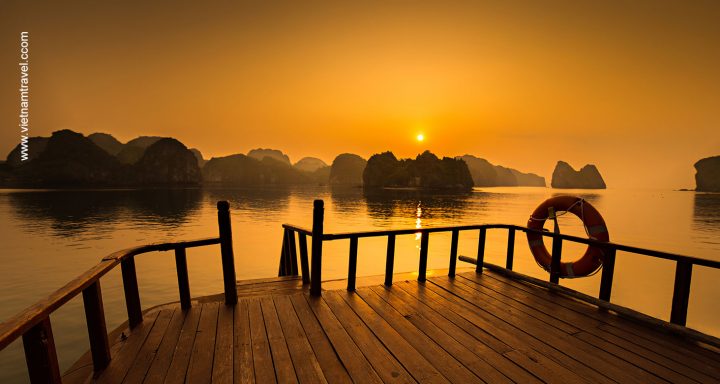
March is a good month to visit Vietnam , as the weather is mostly dry and sunny across the country. However, there are some regional variations that you should be aware of before planning your trip. In March, North Vietnam has a spring-like climate with mild temperatures and low rainfall, while Central Vietnam is warm and dry with high temperatures and low humidity. South Vietnam, on the other hand, is hot and humid with frequent rain and thunderstorms. The average temperature in Hanoi, Da Nang, and Ho Chi Minh City are 19°C (66°F), 26°C (79°F), and 28°C (82°F) respectively. It is recommended to pack warm clothes and a raincoat for North Vietnam, light clothes, sunscreen, and a hat for Central Vietnam, and light clothes, a raincoat, and an umbrella for South Vietnam.
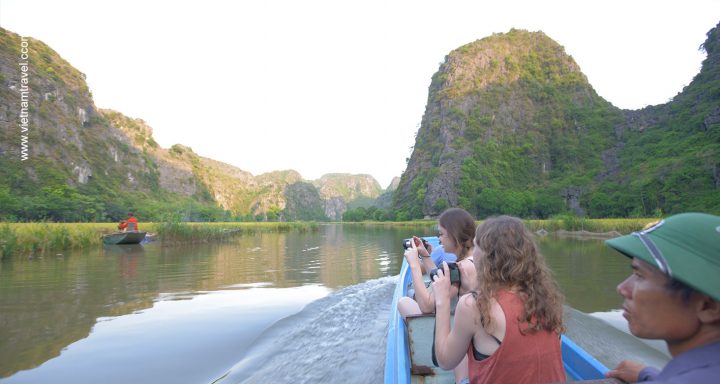
Vietnam has a warm and sunny weather in April, but the temperature differs by region. In the North, the average temperature goes up by 5°C from the previous months and stays between 25°C and 30°C. There are some rainy days in April, but it is less foggy than March. In the Central region, from Danang to Nha Trang, it is a great time to enjoy the summer beaches with an average temperature of 28°C and very little rain. Hue in the central and Dalat and the Central Highlands in the west also have good weather. The weather in Vietnam in April is quite complicated. The days are hot and the nights are mild, so visitors should bring light and comfortable clothes. The highest average temperature is 33 C and the lowest average temperature is 25 C.

May is a good time to travel to Vietnam with reasonable prices and mostly dry weather. The average temperature is between 28°C and 30°C, but you may encounter some afternoon showers in the north and south towards the end of the month. The north is hot and humid, with some rainy days (avg temp: 29 °C). The mountains are still favorable for exploring Mu Cang Chai and Sapa, but Ha Giang gets more rain. The central coast is not very comfortable, as the cold monsoon lasts from October to April. If you want to avoid the crowds and enjoy warm and sunny weather, the best months to visit Vietnam are May, June, and September. The north is cooler from October to December, but the central coast is better. From March onwards, the north can be very hot.

June is a hot and humid month in Vietnam , with frequent rain and high temperatures. The average temperature ranges from 26°C to 35°C (79°F to 95°F), but it can vary by region. The north of Vietnam is very wet in June, especially in the mountain areas. The average temperature is 30°C, but it can be cooler in the highlands. The central regions have sunny and dry weather, with ideal conditions for beach towns like Hoi An, Nha Trang, and Danang. The average temperature is also 30°C, with lots of sunshine. The south of Vietnam has a tropical monsoon climate, with two seasons: wet and dry. The temperature is consistent throughout the year, but June is part of the wet season. You can expect some heavy showers and thunderstorms, but also some sunny days.
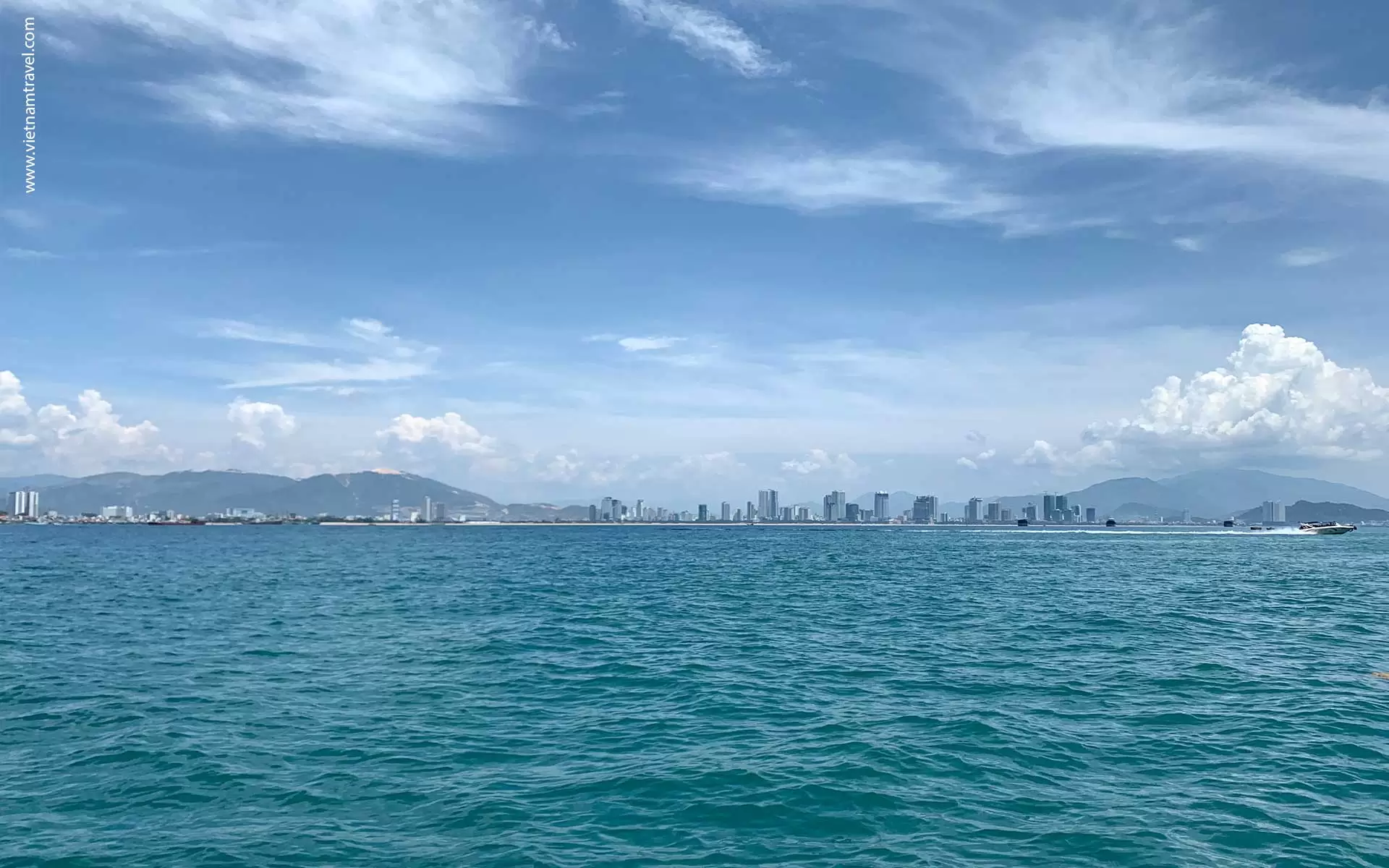
Nha Trang City – View from Spectrum of the Sea.
July has a temperature at nearly 40 Celsius degrees with rain. However, this month is perfect to enjoy beach across the country. You can choose the hottest days for a trip to Halong, Phu Quoc, Nha Trang, Mui Ne or Con Dao. Visitors can enjoy the crystal ocean, sunny skies and delicious seafood. July is also a great time to visit the cities of the central coastal line: Da Nang, Hoi An and Hue. Or you can choose to stay away to the heat by visiting Da Lat.
July is a peak season for Vietnam travel , especially by the coast. You should book your hotels early, as prices can go up by 50%. The weather is hot and humid across the country, except for the far north. You may also experience some summer monsoon rains, which can be spectacular. North Vietnam has a rainy season in July, with high temperatures and humidity. The average daily temperature in Hanoi is around 29°C (84°F), but it can be lower in the mountainous areas like Sapa and Ha Giang. Central Vietnam has a sunny and dry weather in July, with occasional light showers. The beaches and islands of this region are the main attractions in this month. The average temperature is above 31°C (88°F) during the day.

In the north and south, September marks an end of summer with the temperature drops significantly and it’s getting drier, opening up the possibility of trekking once more in the north, around Sa Pa. As one of the best months to visit Vietnam, September offers diverse weather conditions and natural landscape features across the country. Cat Ba island, Halong Bay, Phu Quoc and Mui Ne have great conditions to enjoy the water and the scenery. Mountainous areas like Sapa, Mu Cang Chai start their harvesting season: terraced rice fields turning golden which creates a picturesque landscape that visitors cannot take their eyes off.
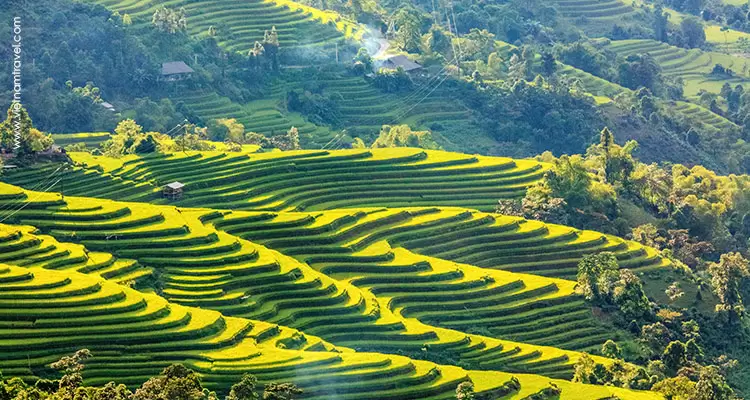
If you plan to visit Vietnam on October, you cannot miss Ha Giang or Mai Chau, which appeals travelers with its beauty of golden terraced rice fields and pink fields of buckwheat flowers. When the heat is gone, visiting Hanoi is prefect and trekking in Sapa is great. In October, Da Lat becomes a romantic town with the fog covers all house roofs and trees, in addition with the beautiful of colorful blooming flowers. Meanwhile, in the south, it is getting dry and warm, and it’s a great month to visit Can Tho – the Mekong Delta and its floating markets.
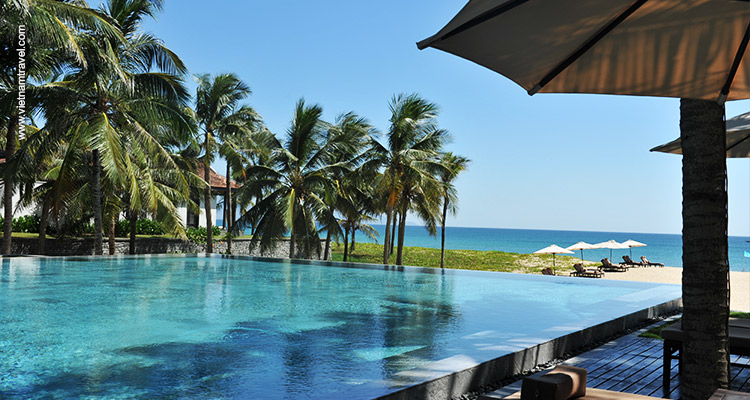
The north becomes cold at this time, but visiting Mai Chau is still appeal to many travelers because of its pretty nature and interesting culture. Ban Gioc Waterfall, one of Top 10 Waterfalls in Vietnam , is at its best beauty in this time of year. And visiting Perfume Pagoda in its off-season is just so relaxing and you can truly appreciate nature. Meanwhile, the South still offers travelers the sunny beaches and warm water in Mui Ne, Phu Quoc and Con Dao islands.
There are so many places for tourist to discover Vietnam. No matter what time you plan to visit, Vietnam Travel organizes private tours of your choice destinations and visitors escorted by our professional guides will get chance to explore part of Vietnam. Ask travel questions, get tour help related to best time to visit Vietnam and adventures, please feel free to contact Vietnam Travel’s tour planners today.
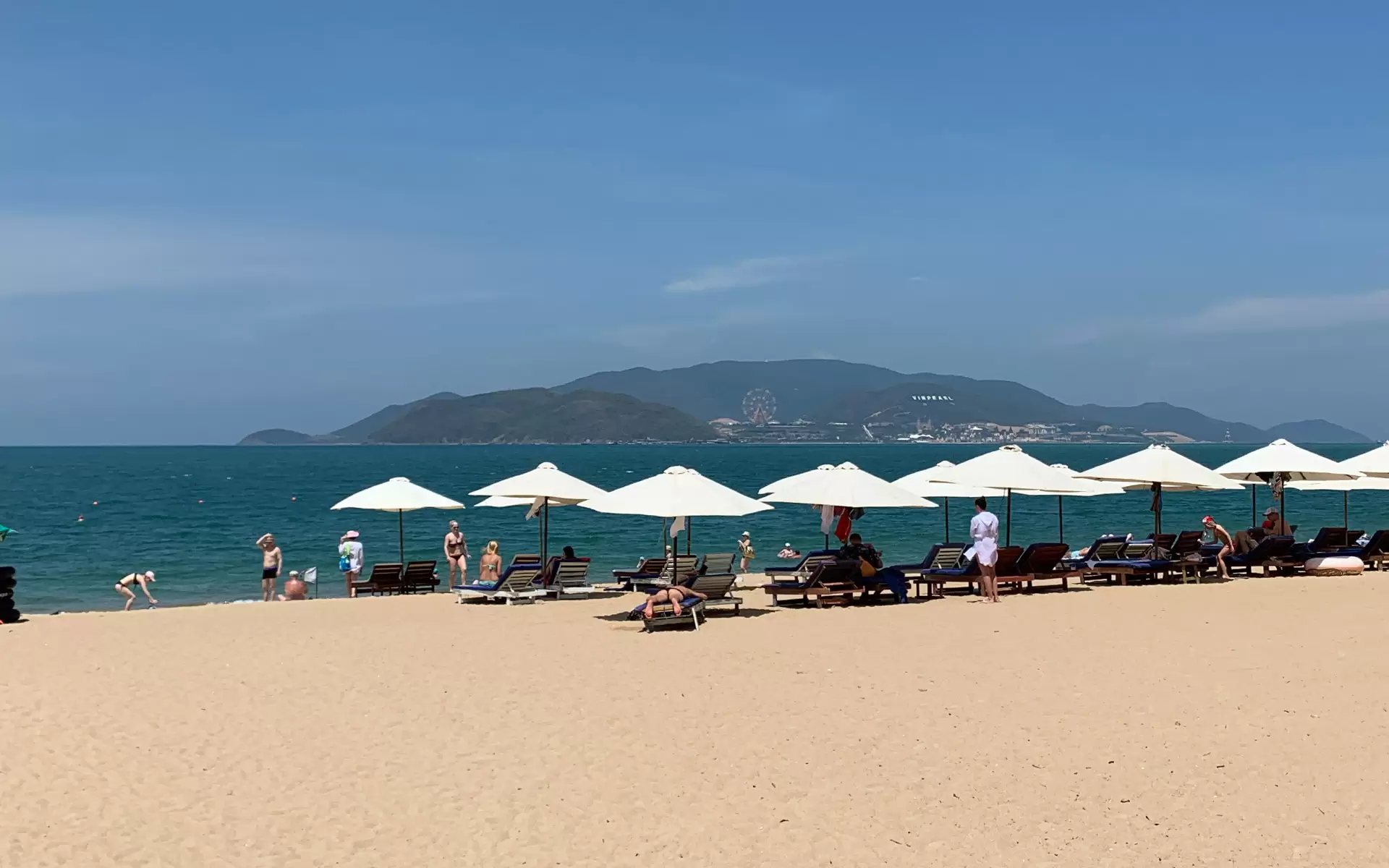
Related Posts
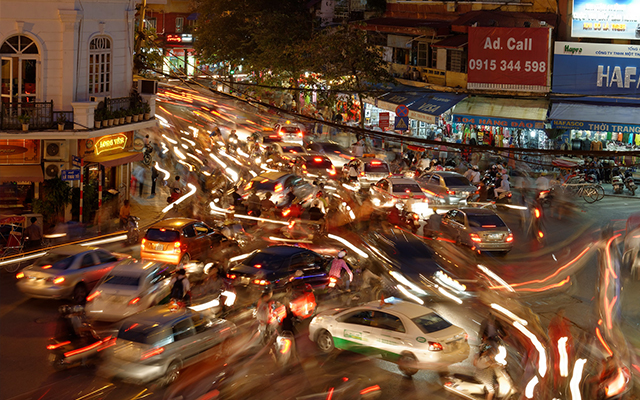
25 Best Things to Do in Hanoi – Top Sightseeing & Activities
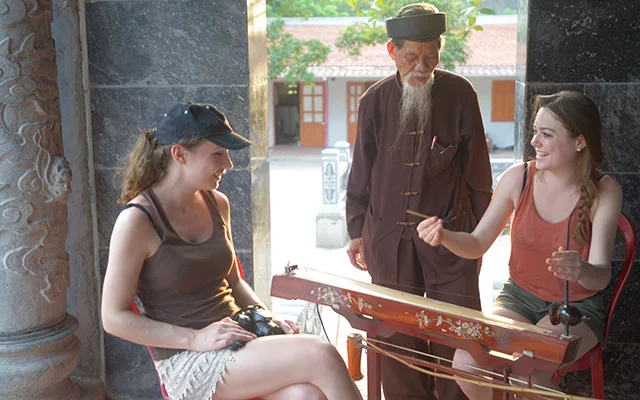
Trang An Scenic Landscape Complex

Best Vietnam Private Tours you should know before traveling
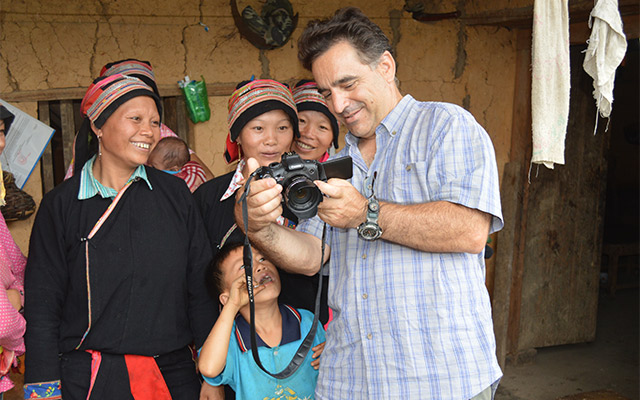
Vietnam Tours from Portugal
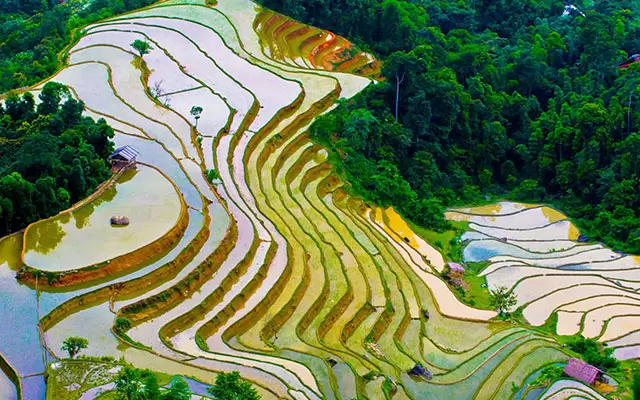
Weather of March in Vietnam

Vietnam tour packages from Shanghai, China
I want to know what the best time to visit your country and what it like in Late October or Early November and could you let me know how many sunny days you get there. Is it still warm weather as like between 20 to 25 during the day. What’s is like at night time there. What is your money over there to What is your food price for eating out to. Just want information on it.
Leave a Comment Cancel comment
Request a free quote, thank you we have received your travel request. you will receive an email shortly. please check your email and verify the information. your request will be processed after your confirmation..
You have chosen a tour duration longer than 20 days. Please specify the exact number of days you want to travel in the message box below, so that we can have enough information and make a program for you. Thank you for your cooperation.
You have selected a number of travellers greater than 20. Please let us know the exact number of people in your group in the message box below so that we can quote you accurately. Thank you for your cooperation.
You have selected a number of travellers and duration greater than 20. Please let us know the exact number of people in your group and the exact number of days in the message box below so that we can quote you accurately. Thank you for your cooperation.
- Vietnam Travel Guides
- Travel Planning
- Festivals & Events
- Food & Drinks
- Tourist Maps
- Travel Blog
- Travel News
Our Recommendations

Guideline to get Vietnam E-visa

Vietnam Weather: General information & Best Time to Visit

50 Things You should Know before Traveling to Vietnam

Info for travelers on Covid-19 in Vietnam: Entry requirements & Restrictions
You May Also Like
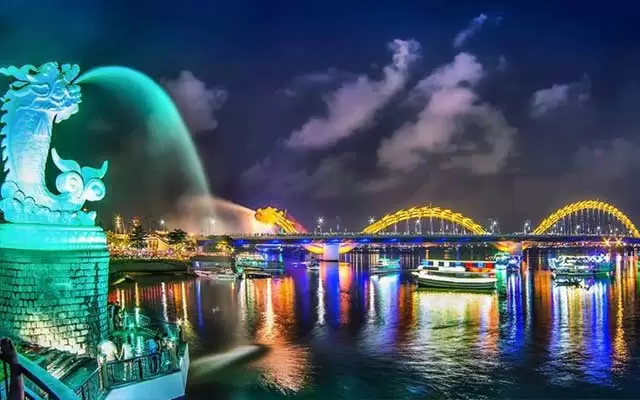
Best Nightlife in Danang City
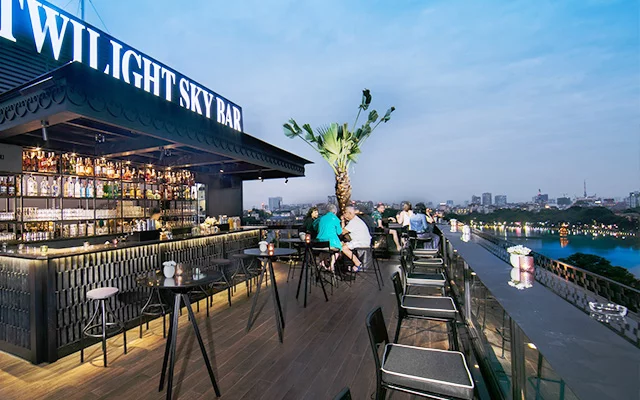
Top Best Hotels In Hanoi Old Quarter
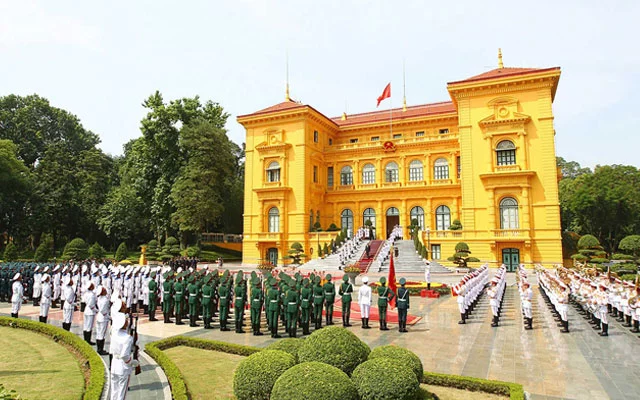
Presidential Palace Hanoi
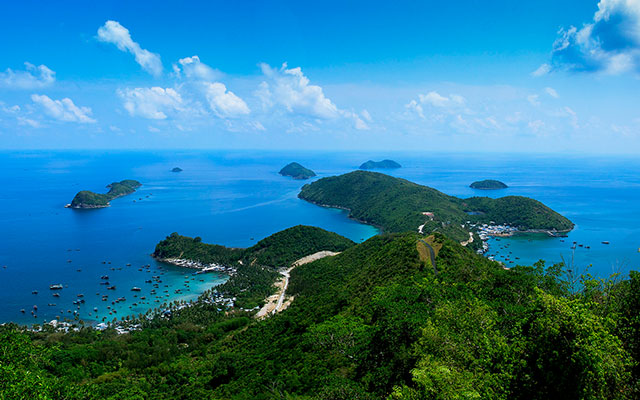
Nam Du Island

Customs and Etiquette in Vietnam
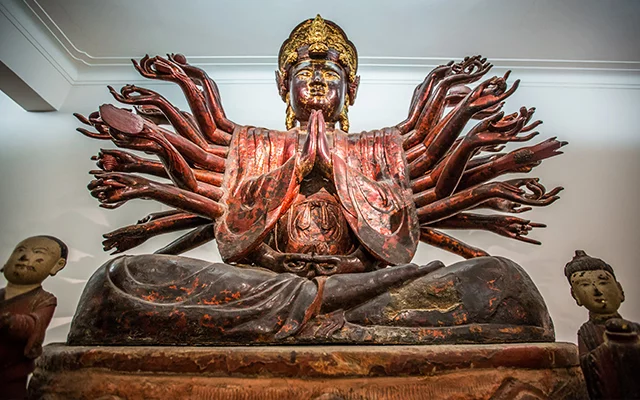
Vietnamese Art and 11+ Traditional Art Forms of Vietnam
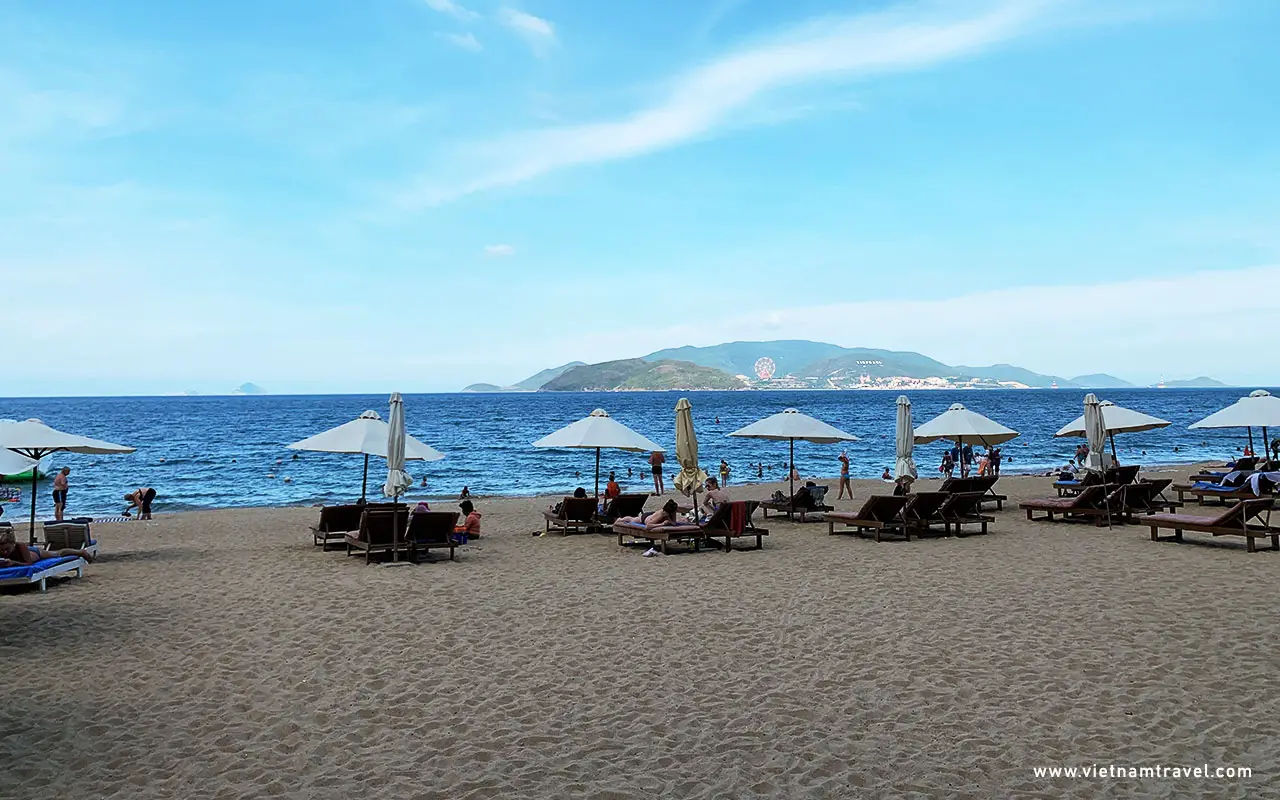
Nha Trang Weather
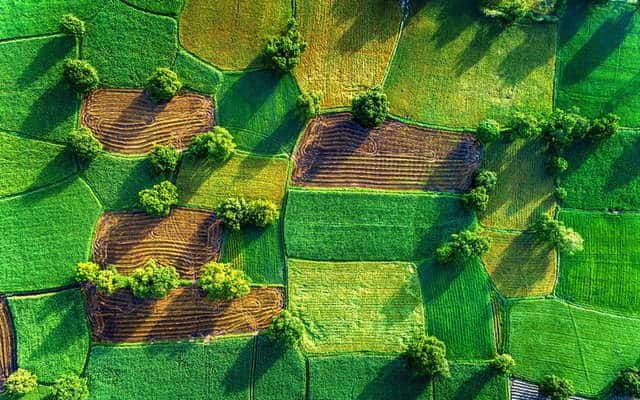
Overview Of Chau Doc
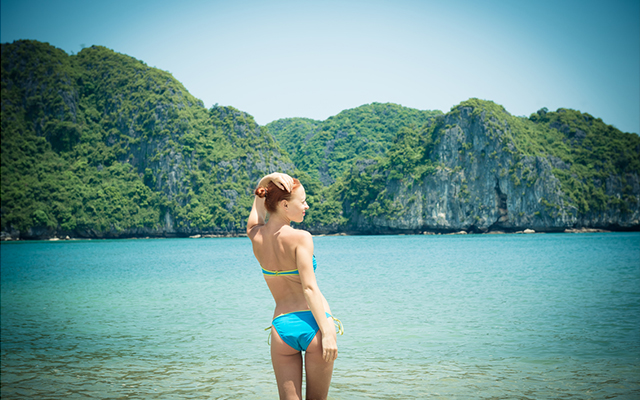
Top destinations in Vietnam for your holiday
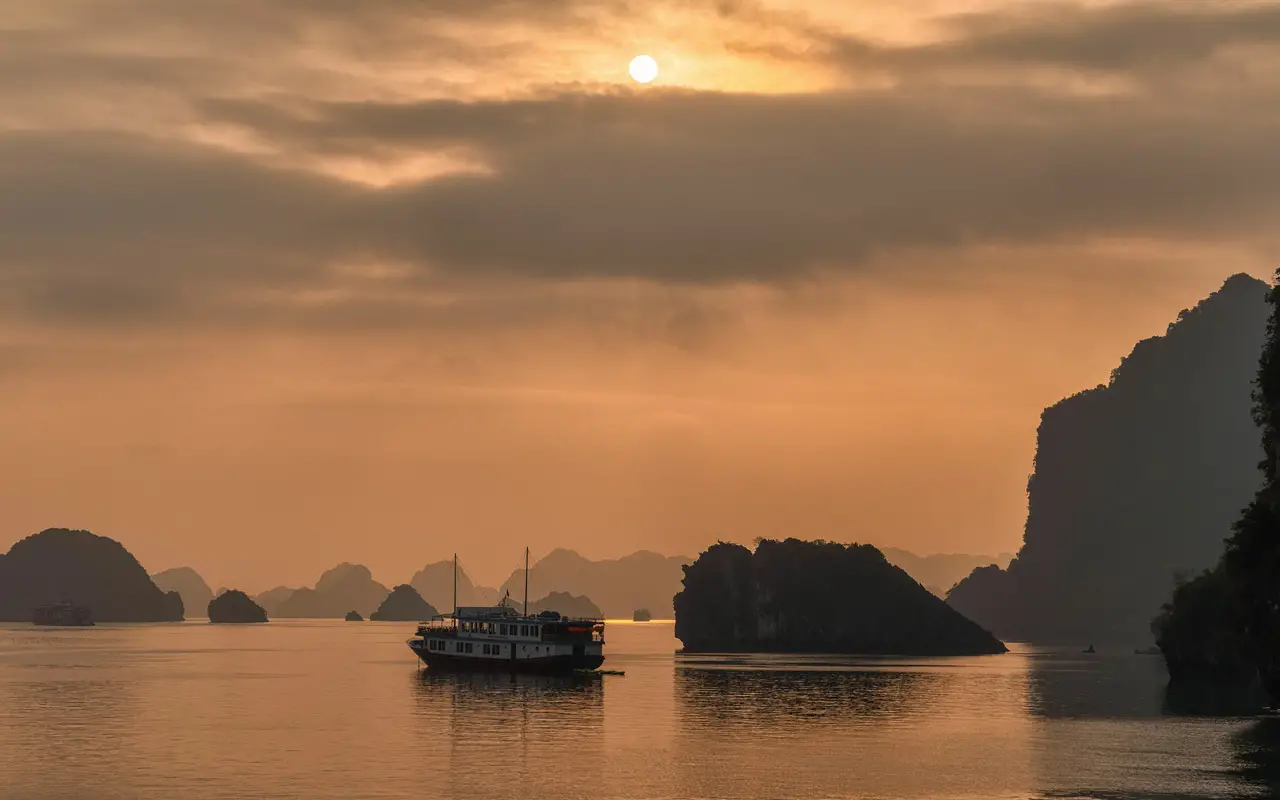
Cat Ba named by BuzzFeed as 11 Must-visit National Parks

When is the Best Time to Visit Vietnam: Month by Month Guide
Vietnam is an incredible country to visit all year round, however due to its size and shape, the weather in Vietnam couldn’t be any more different between the North, Center and South of Vietnam – from the Northern Highlands to the hot, tropical like South. When you decide to go will really depend on the type of trip you want to have and what you want to experience. To help you decide when would be the best time of year to go to Vietnam for you, we’ve outlined below the different seasons you can expect, if there’s an overall best time to go to capture the best of both worlds as well as the weather by month and what kind of activities are possible in each.
Table of contents:
Is there an overall best time to visit Vietnam?
Climate of vietnam.
- When is monsoon season in Vietnam?
- Best time to visit North Vietnam
- Best time to visit Central Vietnam
- Best time to visit South Vietnam
- Vietnam seasons
- Vietnam weather by month
Many say that the best time to visit Vietnam is between November and early April, with the weather in Vietnam and temperatures in both the North and the South being perfect for trekking and adventures. The temperatures are cooler at this time of year, but they’re also very doable if you’re used to alpine or slightly colder conditions, even in the mountains however you are likely to get cloudy days. In central Vietnam, such as Hue and Hoi An the rains have calmed and a second high season is beginning. Whether November to early April is the best time to visit Vietnam really depends on what it is you have in mind for your trip. If you are planning to try and explore as much of the country as possible and want the best weather possible to enjoy, then November to early April is possibly the best time to go to Vietnam. It’s also worth noting that depending on the calendar for the year, Tet, the Vietnamese New Year celebrations happen either at the end of January or into February. If you plan to travel around that time, be sure to book your flights and hotel as soon as possible as many places become booked up very quickly and raise prices. It’s also important to keep in mind that because it’s a country wide, family celebration, many restaurants will close around the week of the celebrations. We’d recommend doing some research to see when Tet falls if this is the time period you’re looking to travel in. However, travelling around Tet can be magical and the best time of year to visit Vietnam if you’re looking for a truly authentic experience!
Many people ask what is the climate of Vietnam, but it can’t be answered simply – due to its size, there isn’t one specific climate in Vietnam, with different areas of the country experiencing highly contrasting weather throughout the year. You can get cold days in the Northern mountains and hotter than hot days in the South, so it’s worth thoroughly considering when to visit Vietnam in terms of the kind of weather you want to experience. However, a trip to Vietnam is about much more than weather alone as there is so much to experience. But with that said, when rainy and monsoon season in Vietnam hits, it can really curtail a lot of adventure based plans, so always plan ahead! It’s entirely individual, and the worst time to visit Vietnam for you might be the best for someone else – that is what is truly wonderful about Vietnam.
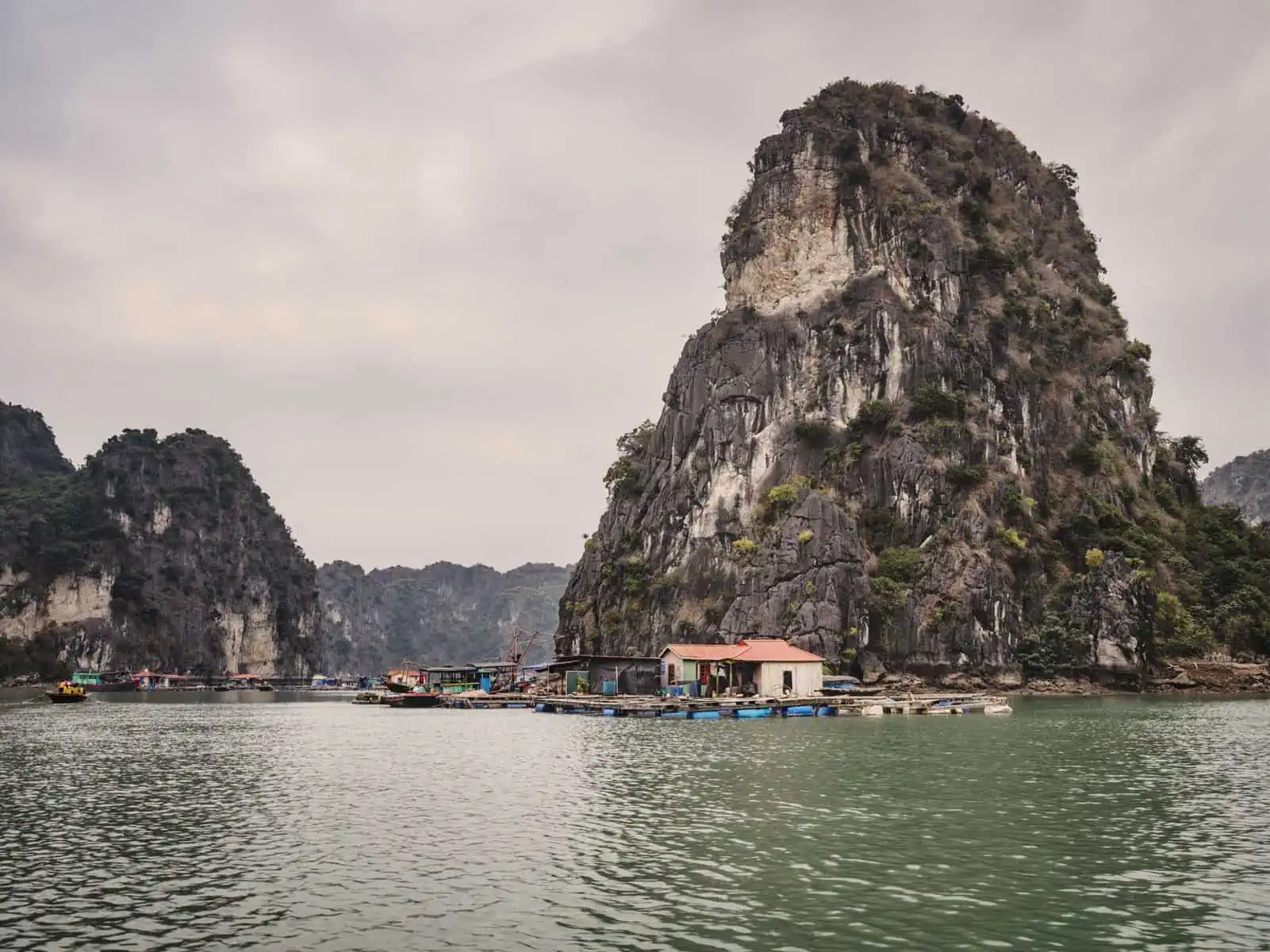
When is Monsoon Season in Vietnam?
Monsoon season in Vietnam is between June, July and August in the North and South of Vietnam and between September, October and early November in central areas where rainy season in Vietnam typically eases by late mid to late November.
Related content: From the best things to do in Tunisia , to hikes in Sedona, Arizona , we’ve got you covered with our destination guides including itineraries, hikes and so much more.
Best time to visit North Vietnam (Hanoi, Halong Bay, Sapa, Ba Bae National Park)
The best time to visit North Vietnam and places such as Halong Bay, Bai Tu Long Bay (Halong Bay’s much quieter neighbor) and Ba Bae National Park is between the months of October to April. Whilst October may still be a little unsettled, and you may still experience some rain, you can expect to see incredible colors in the landscape. You’ll also see an abundance of produce being harvested, such as rice so it’s a great time to be in the countryside. November is also a great month to visit Halong bay and neighboring, much quieter Bai Tu Long Bay as you’re more likely to get clear skies. From December, the temperatures have cooled slightly, so from December on, you will more likely see cloudy days, though there is still the chance of sunshine. October until April is when adventures in the North really come alive – trekking and hiking in the North, the Highlands and around Ba Bae National Park is truly magical. Hanoi one of the best cities in Vietnam to visit at this time of year also, with humidity at a much lower level making exploring the city a much more pleasant experience.
Best time to visit Central Vietnam (Hoi An, Hue, beaches etc)
Between February and May and November to December are great times to visit Central Vietnam. Between February and May, the temperatures are perfect for visiting the coastal areas such as Hoi An and Hue. Whilst they can become extremely hot, they are also doable. November and December are also great times to visit, but we’d advise the latter half of November would be a safer bet, depending on when the storms and rainy season end. At these times of year, you can expect some cloudy days, but mostly sunny with the odd shower. The perfect time to visit central Vietnam is April, however this is a very popular time to visit so prices can creep up very quickly. If you’re planning to visit around this time, we’d recommend booking in as much advance as possible.
Best time to visit South Vietnam (Ho Chi Minh City, Mekong Delta)
The south experiences some of the best weather in Vietnam and the best time to visit the South of Vietnam is between December and March. This is when the weather is more settled, not as hot or as humid. This time of year also makes for a much more enjoyable experience checking out Ho Chi Minh City and everything on offer in the south such as Mekong Delta and the Can Gio Mangrove Biosphere Reserve is just 40km outside of Ho Chi Minh City.
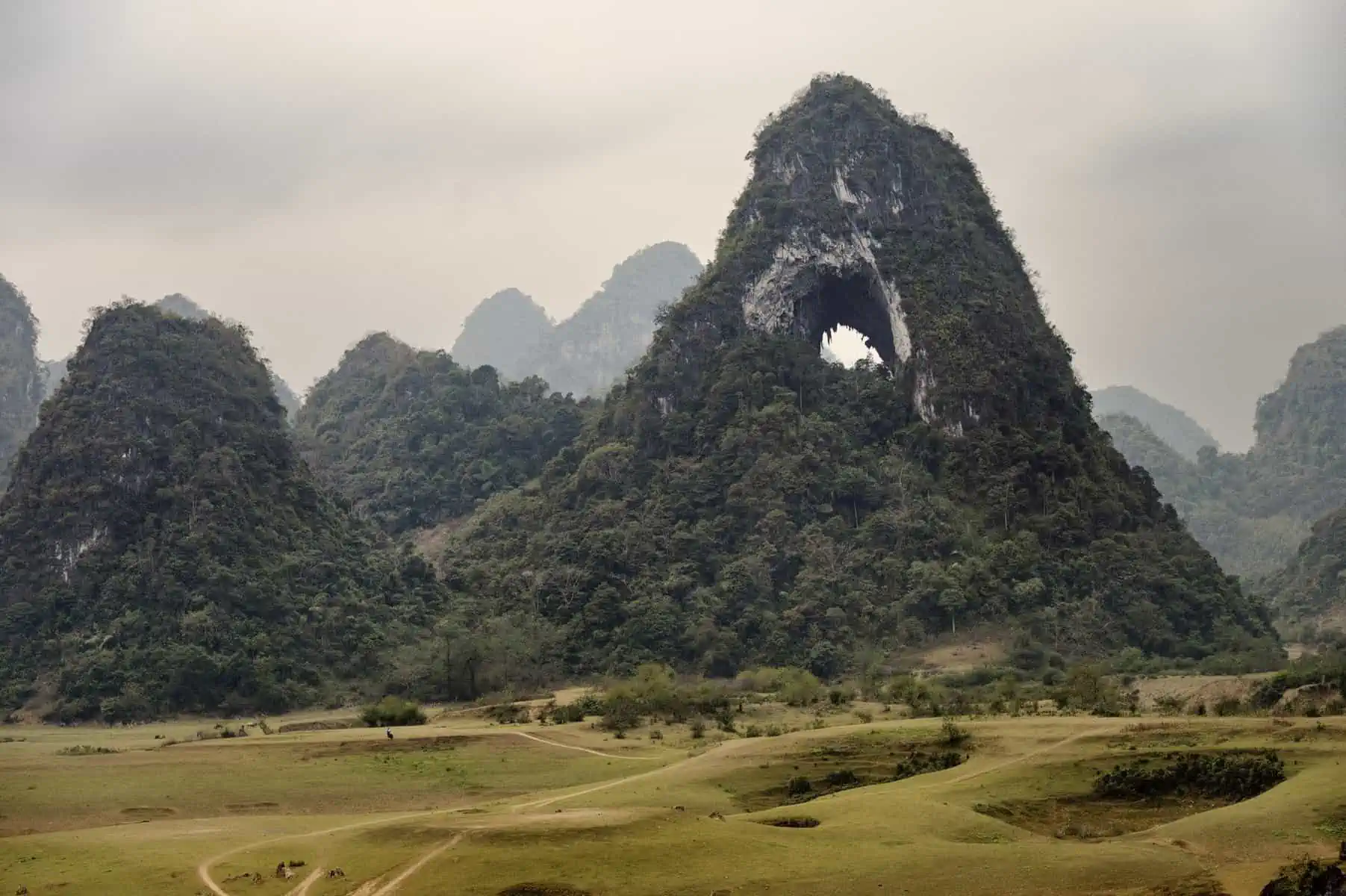
Vietnam Seasons
High season: july, august.
- Best time for relaxing on the beach in central Vietnam
- Book well in advance, very popular
- The South is hot, and the north has monsoons
Shoulder Season: December, January, February, March, April
- Best overall time to visit Vietnam due to calmed climate which is suitable in most places
- Best time for checking out Hanoi and the North, such as Ba Bae National Park, Cao Bang, Highlands, Sapa
- Best time for adventures, trekking and backpacking
- Drier and colder, but warm and pleasant with less chance of rain
- One of the best seasons in Vietnam for visiting as much of the country as possible
- During Tet, the Vietnamese New Year festival, either in late January or early February depending on the calendar that year, a lot of things can be closed, and prices do get higher in hotels
- Weather is great in April, maybe even one of the best months to visit Vietnam
Low season: May, June and September, October and November
- The start of Monsoon season in the South and rainy season and storms in the North
- If visiting at this time, it’s better to focus on visiting cities and central Vietnam
- October and November are great for checking out the harvest and floating markets along the Mekong Delta
- Checking out Halong Bay in November is great because you’re likely to get clear skies
- Much quieter with less tourists
Vietnam Weather by Month
January in vietnam.
- Mostly dry season across the country
- Cold in the North
- Shops and Restaurants close for Tet
In January, it is generally dry in the North and South of Vietnam, but it’s important to remember that in the South it is still the end of rainy season, so you can expect some inclement weather. If you’re planning to visit the North and visit Halong Bay you can expect it to be colder, but it is none the less a really nice time to visit. It’s about 50/50 in January as to whether you’ll get a cloudy or sunny day for your visit, but it is spectacular at any time and even the cloudier days give the interesting rock sculptures you’ll see a beautiful feel. Hanoi is also a great place to visit in January as the slightly cooler, dryer temperatures make taking in the city and exploring a much nicer activity. You also have Dalat flower festival to look forward to in January too. If you’re looking for a quieter experience in the countryside and in nature, travelling to the far North of Vietnam to around Ba Bae National Park and Cao Bang is a great thing to do at this time of year. At higher elevations, you’re likely to experience colder temperatures, but January is a great time for adventures such as trekking, cycling and backpacking. It’s worth keeping in mind that depending on when Tet (the Vietnamese New Year celebration) falls, January can be a very busy time in the hotels all over Vietnam, with some of them even closing. So if you plan to travel as this time of year, you should look to book in as much advance as you can.
February in Vietnam
- Warmer temperatures in most areas of the country
- Great month for partaking in for adventure sports, hiking, canoeing etc.
- Beach resorts become busier due to increased temperatures
February is a great month for visiting Vietnam as the warmer more stable climate allows you to visit much more of Vietnam. If you’re planning to travel from North to South Vietnam, or vice versa, February is a great month to look at. It’s a great month for outdoors activities across the whole of Vietnam, particularly in the North and in the Highlands where you’ll find the temperatures mild but not too hot or too cold. The coast and central Vietnam are becoming busier at this time too. If Tet (the Vietnamese New Year festival) falls in February, it’s worth noting that hotels can get very busy, and because this is a popular month anyway, can be even busier than if Tet lands in January. It’s worth looking at when Tet falls on the particular year you’re looking to visit and planning accordingly. February can also be the best time to visit Vietnam and Cambodia on the same trip, due to the warmer temperatures and lack of rain.
March in Vietnam
- South Vietnam becomes much hotter
- Ideal time for hiking and exploring the North and one of the best times to visit Vietnam
March is a very popular time to visit Vietnam due to the warmer and much dryer weather you’re likely to experience. It’s also one of the best months to visit Halong Bay where you’re likely to find exceptionally sunny skies and little to no winds for the ultimate experience. Due to the sunnier skies and warmer temperatures, it’s also a really lovely time to take a trip to the North of Vietnam and visit places like Cao Bang, Angel Eye Mountain and Ban Gioc Waterfall. Depending on the particular year, you can even start to see the beginning of the spring flowers in the countryside and mountains towards the end of March if spring comes early – a truly beautiful sight to see. Nature truly feels like it is coming alive in the North of Vietnam in March, and the farmers you see will be in full action.
April in Vietnam
- Likely to see a profusion of Spring flowers
- Beach destinations are very popular
- Potentially the best month to visit Vietnam
April could very well be the best time to visit Vietnam, especially if you want to visit as many places as possible within the country. Whilst the South of Vietnam is becoming very hot around areas like Ho Chi Minh City, it is still doable. The North of Vietnam is wonderful in April and at this time of year you’re likely to see spring flowers cropping up everywhere in the countryside, which is well worth a visit! It’s also a fantastic time to visit Central Vietnam and the coast in areas like Hue and Hoi An, where temperatures are high, but can make for an amazing time, especially if you want to spend some time relaxing on the beach within your trip.
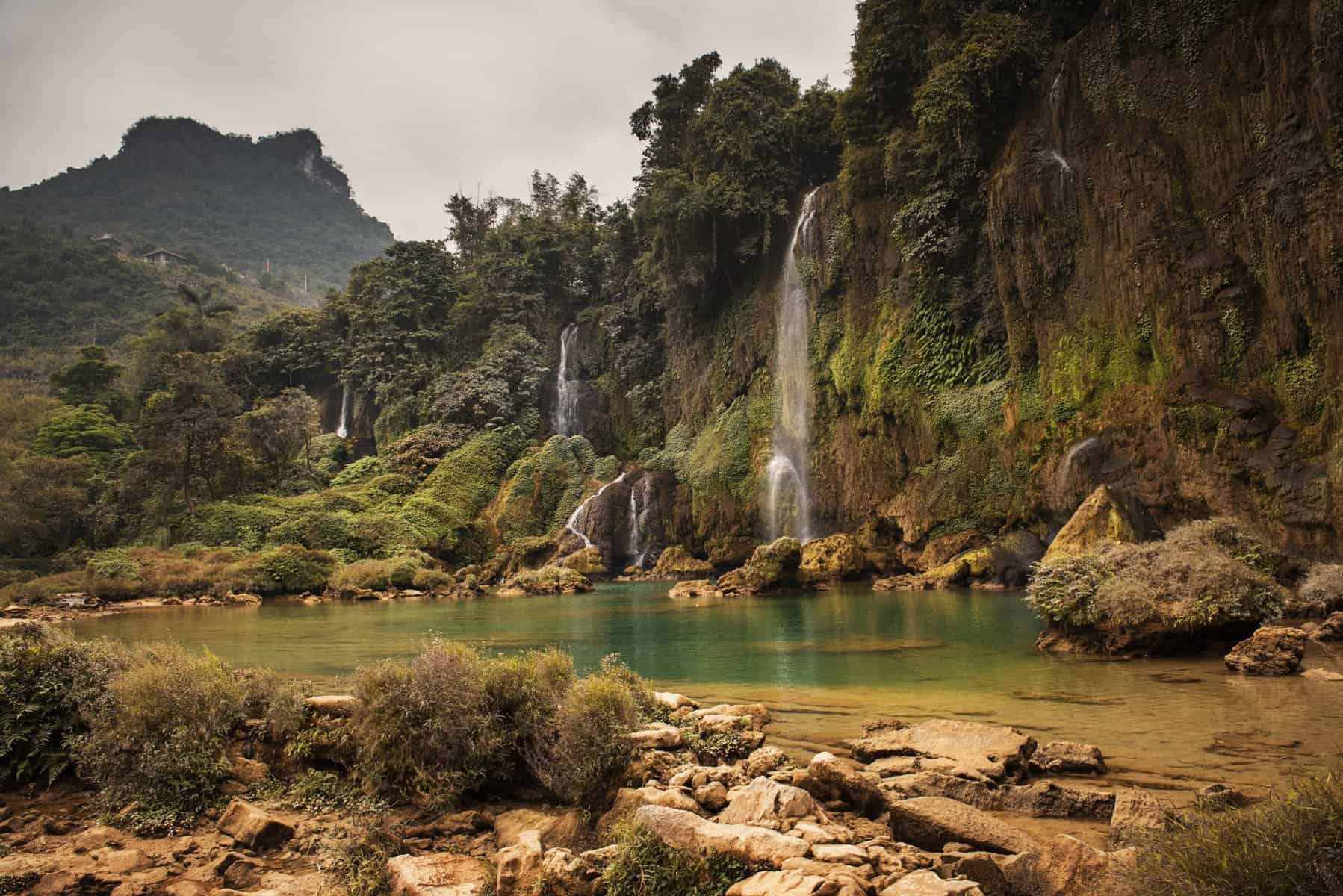
May in Vietnam
- Very hot temperatures in the South of Vietnam
- Showers to be expected in most locations
In May it is extremely hot in the South of Vietnam with temperatures reaching around 40c at times. Ho Chi Minh City is best avoided at this time due to the humidity and temperatures you’ll experience. If you’re planning to visit in May, its best to organize your trip around Hanoi or the central coast in areas such as Hoi An and Hue. You can still visit the mountains in the North of Vietnam in May, but there is likely to be rain as it’s approaching rainy season, though it can still be doable. However, because the weather is quite changeable in May, it’s possible to get a real deal on your trip with costs being much lower.
June in Vietnam
- Generally at the height of Vietnam’s monsoon season in the South
- Heavy rains and storms to be expected in the North – with adventure, hiking, trekking, and exploring off limits
In June the North of Vietnam experiences heavy rains and storms which can result in paths, roads and trails being flooded or very muddy, so unfortunately things like trekking and hiking are off limits. Whereas in the South of Vietnam, monsoon season has begun and so this isn’t the best time to visit and can lead to extensive flooding especially around the Mekong Delta. In June, you’ll need to focus your trip on central Vietnam in the areas of Hue or Hoi An. Central Vietnam is a much better option and you can often get a good deal as the coast is usually dry. The weather around central Vietnam is actually doable in June, with pleasant temperatures that make exploring much more possible. It can also be the best time to travel to Vietnam if you want to get a good deal on travel, due to the country generally being quieter at this time.
July in Vietnam
- Still at the height of rainy season in Vietnam: Generally wet in the North and South of Vietnam with monsoons continuing
- Good time to visit the central coast of Vietnam
July, in terms of weather in Vietnam is generally the same as June as it’s still at the height of Vietnam’s rainy season. Except you can expect monsoon and heavy rain conditions to potentially worsen in both the North and South of Vietnam. However, the coast and beaches of central Vietnam can be really beautiful to visit in July with temperatures reaching similar to what you’d expect in the Mediterranean at around 30c.
August in Vietnam
- Very rainy in the North of Vietnam and the Highlands
- Central coast is great to visit
- South of Vietnam is very hot with rain
You’ll have a great time in Vietnam if you’re planning to visit the center in August as temperatures are holding well from July with little rain and sunny skies. It’s a great time to visit places like Hoi An. In the North of Vietnam, August isn’t a good month to explore due to the heavy rains and storms which may well have caused significant impassable areas. The South of Vietnam is still very rainy at this time and extremely hot too. Due to flooding that is likely to have been experienced in the South of Vietnam, visiting the Mekong Delta wouldn’t really be possible in August, and visiting Ho Chi Minh City would be unpleasant because of the humidity.
September in Vietnam
- Storms start to come into central Vietnam
- The North of Vietnam is passable from late September
- Possible great time to see fall/autumn foliage if this comes early
Things start to really switch around in September with the weather in Vietnam when central Vietnam becomes stormy and very rainy. However, from mid September, depending on the year, the storms have eased off in the North and trekking, hiking and exploring the Northern mountains and countryside again becomes possible. At the end of September is also a great date to put into the calendar where the major harvest festival takes place in alignment with the full moon. The countryside is spectacular with goods being harvested and a flurry of activity to see. If Autumn/fall comes early that year, the colors to be seen in the countryside are truly beautiful, but this is more likely in October.
October in Vietnam
- Hiking and adventure in the North and South are easily enjoyed again
- Central Vietnam is wet, stormy and sometimes a lot cooler
- Rice harvest
In October, Central Vietnam is not a great place to visit as it is very stormy with heavy rains – if you visit in October, you won’t be able to take advantage of what central Vietnam is famous for (typically its paradise-like beaches and incredible cultural cities). However, October is a fantastic time for visiting the countryside of the North of Vietnam and into the mountains to see the rice harvest as well as the wonderful colors that pop up at this time of year in nature. In the South of Vietnam, there is also a flurry of activity, and it again becomes a great place to visit. If you’re visiting at this time, be sure to head to the Mekong Delta where the famous floating markets are packed full of incredible fresh produce and traditional, artisan offerings.
November in Vietnam
- Central Vietnam is still wet, stormy and colder
- Great time to visit the beaches of South Vietnam
- One of the best times for adventures in the North of Vietnam and one of the best months to visit Vietnam overall
- Clear skies in Halong Bay
November sees the start of the second high season that Vietnam experiences, but it really is at the beginning, so temperatures can be changeable. However, November is, aside from April, the best month to go to Vietnam to visit Halong Bay due to the clear skies. Much like earlier in the year, in April, you’re likely to have the best chance of experiencing Halong Bay in clear visibility. The temperatures in both the North and the South are also hot and dry at this time, with temperatures in the mountains pleasant because of the low humidity. However, it’s best to avoid central Vietnam at this time due to continued stormy conditions.
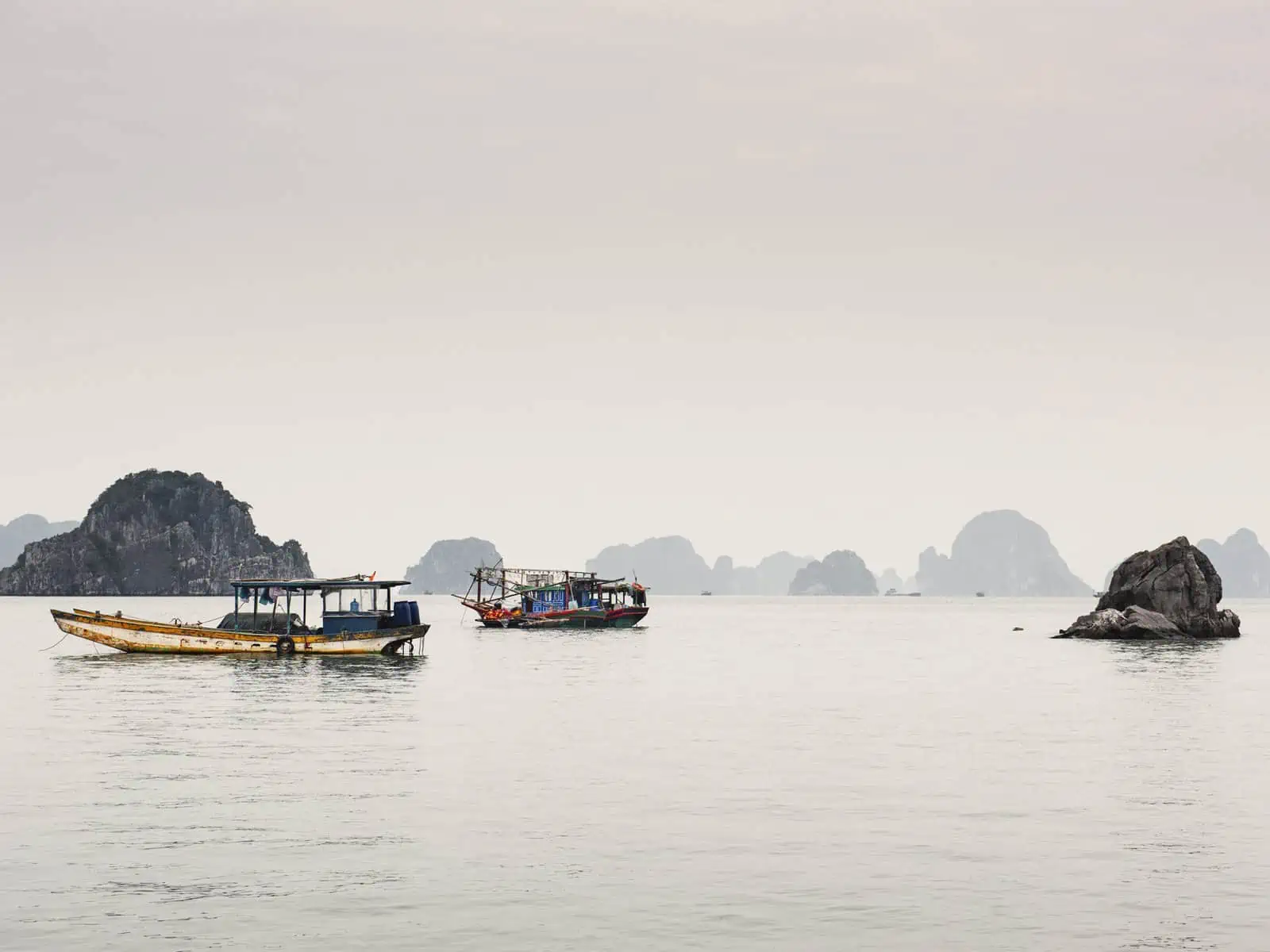
December in Vietnam
- Temperatures are hot across the country, but cooling to more manageable temperatures
- Christmas makes Vietnam busy, with it being a popular destination for Christmas holidays so prices can go up
- Rain calms down in Central Vietnam
Much like January, December is a great time to visit Vietnam as you have the opportunity to visit many locations in Vietnam from North to South and experience the best of all. There is still a good chance of rain in central Vietnam in December, however through the month, this becomes less and less as January gets closer. Both Northern and Southern Vietnam have great opportunities for adventure trips and treks at this time as the mountains are dry and warm but becoming cooler at night (and sometimes cooler in the day). However, because Christmas falls in December, it is advisable to book early to secure at a reasonable price as it does become busier and more expensive at this time.
As you can see, there really is no best time to visit Vietnam as this depends completely on what you want from your trip. Whilst November – April are some of the best times to visit Vietnam if you’re looking to explore as much of the country as you can. It’s also possible to find great deals at some of the quieter times of year if you’re on a tight budget and want to devote time to one particular area only. We hope this guide makes it easier for you to find the best time to travel to Vietnam for your plans and what you have in mind. For more Vietnam travel guides and information such as the key cities in Vietnam to visit and other resources, check out our Vietnam travel hub .
Discover more about Vietnam:
6 Key Cities in Vietnam to Visit and Why
14 Unforgettable Things to do in Hanoi, Vietnam
These Are the Best Times to Visit Vietnam

Vietnam has over 2,000 miles of coastline, densely forested mountains, rapidly growing cities and surrounding limestone islands, and its popularity as a travel destination has grown immensely in recent years — from five million visitors in 2010 to 15 million in 2018.
Ho Chi Minh City and Hanoi bustle with mopeds and motorcycles, while street vendors offer a culinary display of the country's deeply-rooted history and culture. Vietnam's location in Southeast Asia, along with its ecological and cultural diversity, draws travelers from around the world, from budget-conscious backpackers to leisure travelers searching for a slice of paradise at its white sand beaches.
While the natural, cultural and historical wonders of Vietnam can be enjoyed throughout the year, the best times to go depend on where you intend to travel and what you'd like to do. Extreme weather is not uncommon in Vietnam, but this doesn't mean you can't visit during the rainy season. Simply put, make sure you're prepared for whatever a specific region and season may throw your way.
The Best Weather in Vietnam
The weather in Vietnam can vary greatly between the northern, central and southern parts of the country. Due to the country's topographical and ecological diversity, the weather can even differ within one region — for instance, the weather on one side of a mountain range may be significantly different from the opposite side.
North Vietnam
In the north, winter — which occurs between December and March — can bring cooler temperatures even at lower elevations. In the mountainous northwest, it sometimes gets cold enough to snow. The dry season in the north is from October to April, but shifts later in the season as you head south (it doesn't start until November around Hanoi). With summer (May through September) comes warmer temperatures and higher rainfall. Some of the best weather occurs in the spring and fall, which tend to remain dry.
Central Vietnam
Central Vietnam is hot and dry from mid-January through late August. Typhoons are not uncommon between October and December, with most of the rain occurring in November and early December. January through September is the best time to visit this region if you're hoping to stay dry.
South Vietnam
The temperature in the southern part of the country remains fairly consistent, often reaching the mid- to upper 90s regardless of season. The dry season takes place from November through April, and the wet season dominates the remainder of the year. During the wet season (May through October), the rain often comes in high-intensity afternoon downpours, leaving the rest of the day dry and sunny.
When to Visit Vietnam for Events
Tet Nguyen Dan, or Tet, is usually celebrated nationwide beginning on the first day of the Lunar New Year, which occurs in January or February. Tet is traditionally a time for people to spend with their families and welcome the arrival of spring. Because of this, busier cities like Hanoi tend to be less crowded, but there are no shortage of celebratory events.
Every year, hundreds of thousands of Buddhists from around the country make the pilgrimage to the Perfume Pagoda — a series of sacred caves — near Hanoi. Many arrive on the 15th of the first month (which often occurs in February or March) of the Vietnamese Lunar Calendar, which is when the Perfume Pagoda Festival takes place. While travelers can visit the Perfume Pagoda year-round, visiting during the Festival offers a glimpse into this long-lived tradition.
National Day, which takes place on September 2 each year, celebrates the day Ho Chi Minh declared Vietnam's independence. This patriotic day is a great time to be in one of Vietnam's major cities — specifically Ho Chi Minh, Da Nang or Hanoi — to experience the marches, fireworks, parades and other festivities.
Also known as Tết Trung Thu or the Full Moon Festival, the Mid-autumn Festival takes place during the eighth lunar month (usually mid- to late September). While this originated in China as a celebration of agriculture and harvests, Vietnam has its own unique traditions and ways to celebrate. Dancers and colorful costumes can be found in city streets, and illuminated lanterns accompany children as they sing songs while walking through neighborhoods.
When to Explore Vietnam's Cities
Hanoi and Ho Chi Minh City are two of Vietnam's most popular cities to visit. While an argument can be made for visiting both cities any time of year, some seasons have more of a benefit over others.
Hanoi, Vietnam's capital, is located in northern Vietnam and consequently experiences significantly different weather than south Vietnam's Ho Chi Minh City. In the fall and spring, the weather in Hanoi tends to be mild and dry, while the weather in Ho Chi Minh City is most favorable during the winter. During the rainiest seasons, which occur from May to September in Hanoi and May to October in Ho Chi Minh City, travel plans can be disrupted, so travel to cities during this time may require flexibility — and plenty of rain gear.
When to Avoid the Crowds
Peak season in Vietnam generally occurs in the spring and fall throughout the country. Southern Vietnam can also get busy during the winter when the temperatures are cooler.
If avoiding crowds of other tourists is a priority, visiting during the summer is a safe bet throughout the country. In August (especially late August), daily temperatures may be slightly lower than in July but the fall crowds have not yet arrived. The colder temperatures in the north discourage many tourists from visiting the region during the winter as well, despite the fact that it is the dry season.
The Cheapest Time to Visit Vietnam
Affordable airfare.
Most trips to Vietnam either begin in Ho Chi Minh City in the south or Hanoi in the north. While the two regions offer unique experiences (which isn't to say you can't experience both), flying into Ho Chi Minh City is often cheaper.
Historical data collected by travel booking platform Skycanner.com suggests flying to Ho Chi Minh City from New York is cheapest in November. Flights from Seattle, Chicago, San Francisco, Dallas and Los Angeles all tend to be the cheapest around September. With the exception of Chicago and Dallas, which are around $576 and $731 round-trip, respectively, the lowest prices usually fall in the mid- $400 range.
If flying to Hanoi from New York or San Francisco, the cheapest month to travel is October ($531 from New York and $446 from San Francisco). If you are coming from Seattle, Chicago or Dallas, August and September are likely your best bet, with airfare from Seattle and Dallas dropping to the upper- $700 range and mid- $500 range from Chicago. Flights from Los Angeles can be found as low as $501 in November.
Affordable Lodging
An analysis of monthly data collected by hotel booking platform Priceline.com, looking at hotels 2.5 stars and above from 2017 to the present, shows average accommodation pricing across the country does not fluctuate much on a month-to-month basis.
"Priceline data reveals that hotel prices in Vietnam tend to remain close to the overall average daily rate of $85 per night, irrespective of the time of year," Kevin O'Leary, Senior Analyst at Priceline, told TPG in an email. "While they do fluctuate, they rarely stray far away from the midpoint."
According to historical data collected by Kayak.com , however, if you are headed for one of Vietnam's major cities, you likely will experience both more price fluctuation and higher prices overall.
In Ho Chi Minh City, which recently ranked as Kayak.com's top three trending destination , hotels run between $102 and $131 per night, with July being the cheapest and December being the priciest months. Hotel prices in Hanoi are similar, with the cheapest prices found in February and July and the most expensive in October and March. Da Nang, which is located in central Vietnam, is one of the more expensive cities to spend the night in. Prices drop to around $152 in January and February, but frequently exceed $200, hitting a high of $238 in May.
Bottom Line
While there isn't really a "bad" time to visit Vietnam, the season will depict which region will have the best weather. Regardless of when you decide to travel, there will always be moderate temperatures and sunshine to be found somewhere in the country. And for those lucky enough to have a flexible schedule and a specific travel goal in mind, be sure to choose the appropriate season for the area you'd like to visit.
Vietnam tips: a first-timer's guide

Aug 12, 2019 • 6 min read
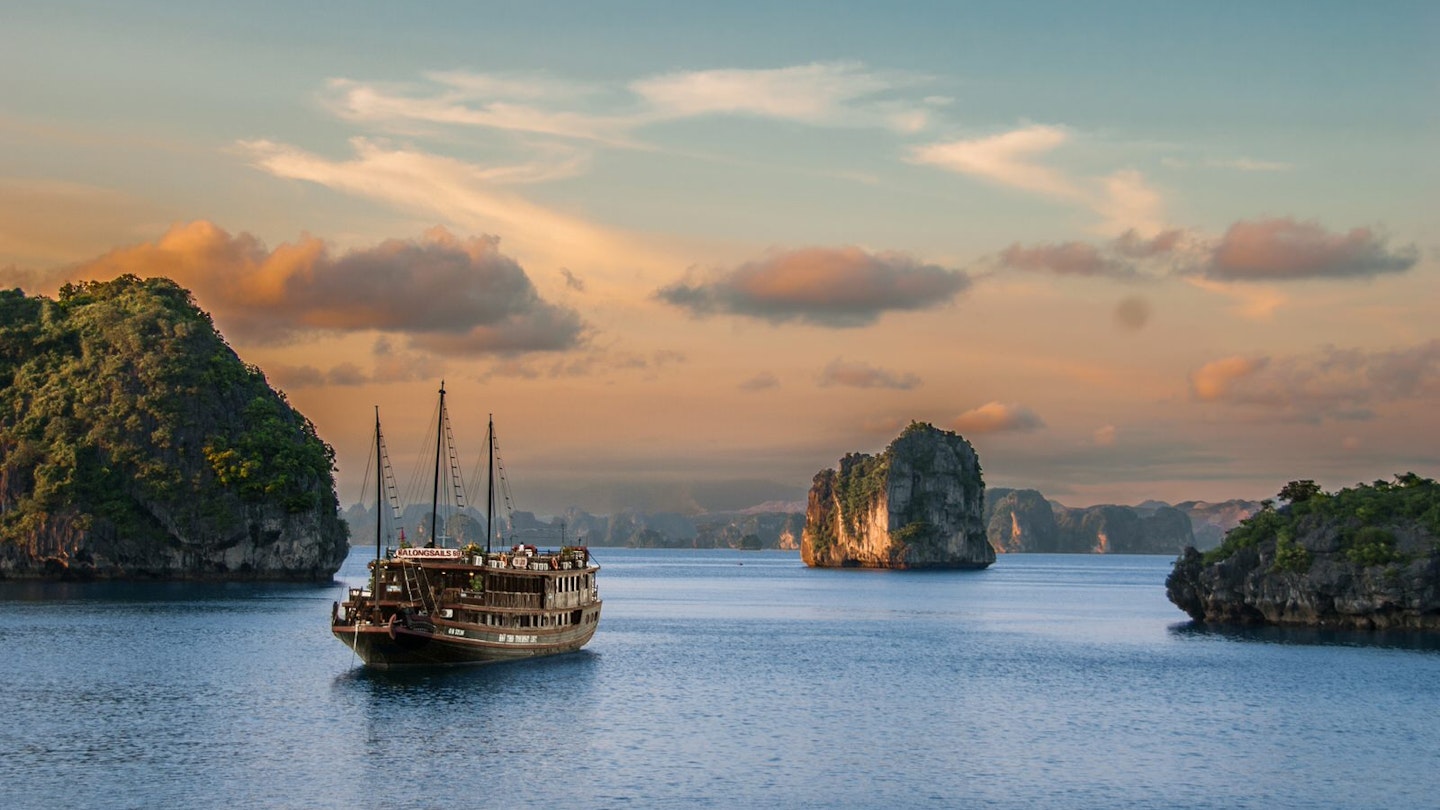
Halong Bay is a World Heritage Sight and a highlight for many visitors to Vietnam © ©César Asensio / 500px
There's a lot to love about travelling in Vietnam , which stretches from the soaring mountains and fascinating ethnic groups of the north to the endless rice paddies and vibrant waterways of the Mekong Delta in the south, with more than 3000km of glorious coastline in between.
Throw in a good transport infrastructure of buses, trains and flights and an abundance of cheap but excellent street food and it's no surprise Vietnam graces countless bucket lists. But, like any country, it has its challenges, and some visitors come home with tales of scams, hectic roads and pushy vendors. Following these top tips will help you avoid the major pitfalls, and ensure you come away from your first visit to Vietnam with happy memories, as well as your souvenir conical hat.
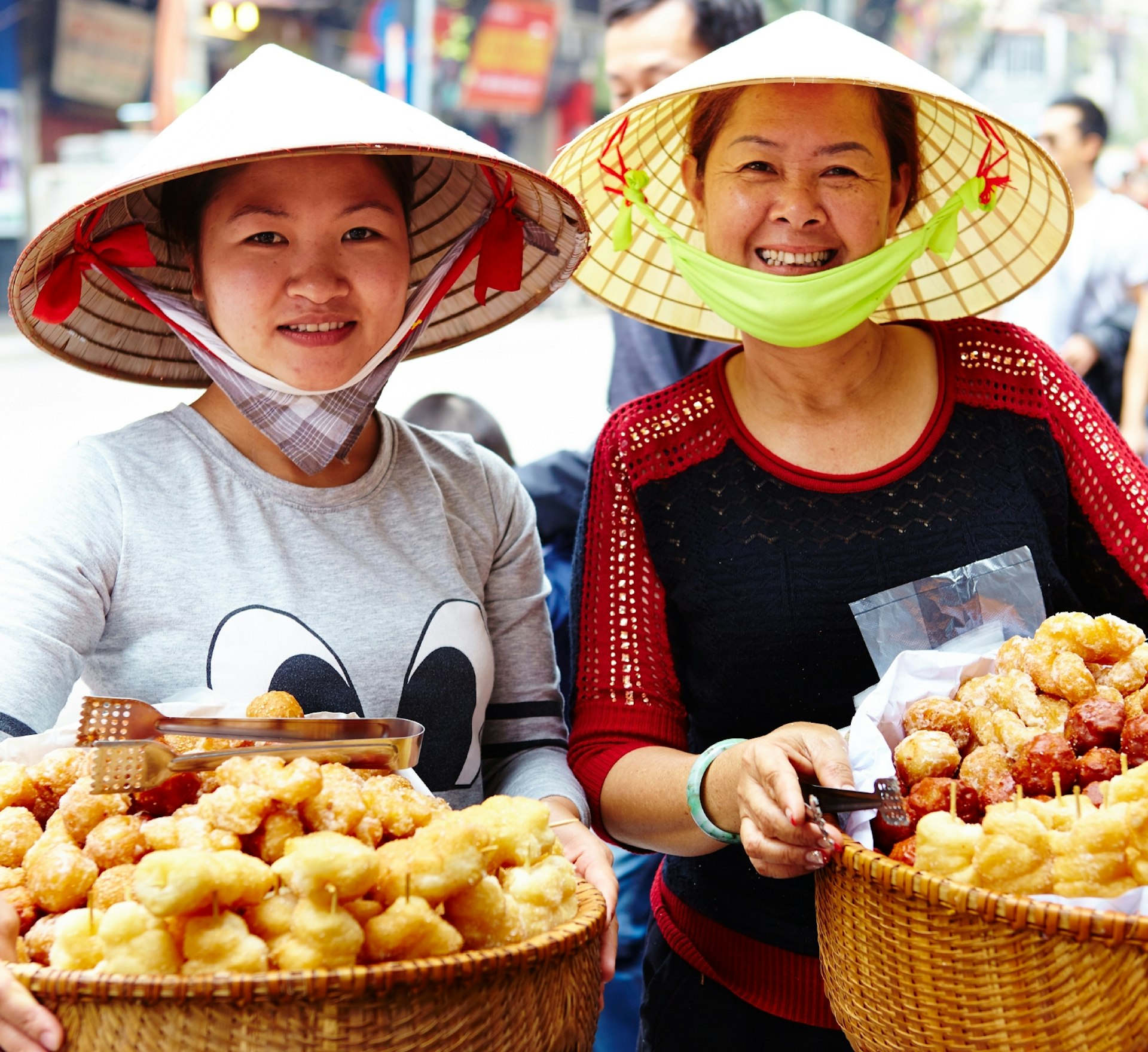
Vietnam 's long exposure to foreigners means that many local residents aren’t as overtly curious about visitors as some of their counterparts in Cambodia , Myanmar and Laos . Also, because most Vietnamese are not confident with spoken English despite learning it in school, people tend to ignore lost-looking foreigners unless you actually ask for help. But be assured that the Vietnamese really are friendly people. If you ask someone a question with a smile and in slow, clear English, you’ll almost certainly have it answered and the smile returned. Simple phrases such as xin chào ('hello', pronounced 'seen chow') and cám ơn ('thank you', pronounced 'kaam uhn') go a long way.
Get connected
While most hotels , cafes and restaurants have wi-fi, you can easily buy a SIM card and get connected to the internet for as little as US$3. Vietnamese street names are notoriously long (most are named after people), so digital maps trump paper ones for many travellers. You’ll also find having a local phone number handy for meeting up with tour guides and making last-minute bookings on the road. SIM cards are widely sold in corner shops and are easy to top up. Once you have a card, the process to register for internet can be tricky, so ask the shopkeeper or your hotel to do it for you. Lonely Planet's Guides app covers Hanoi and Ho Chi Minh City .

Know your dong from your dollar
The Vietnamese dong is the currency of Vietnam and comes in denominations ranging from 200 to 500,000 (about US$22 at the time of writing). While it’s thrilling to become a Vietnamese millionaire, dealing with that many zeros can become frustrating, especially since some of the currency is very similar in colour. For example, the 10,000d note and the 200,000d note are both tan while the 20,000d and 500,000d notes are both blue. It’s very easy to hand over the wrong bill to a taxi driver while in a rush. Spend a minute in your room before going out to sort your bills to avoid overpaying. Even if you do end up overpaying a small amount for certain things, take it in stride. In the grand scheme of things, it’ll likely not be worth the aggravation.
While international credit and debit cards are accepted at most larger hotels, restaurants and travel agencies (sometimes with an added fee), cash is still king in Vietnam for day-to-day transactions. ATMs are widely available, and currency can be exchanged at banks (and some gold shops, although this practice is frowned upon by the government).
Note that the official system of separate prices for Vietnamese and foreigners – which applied to everything from train tickets to entrance fees – is a thing of the past.

Be wary of taxi scams
For many, motorcycle taxis are the best way see the thronging streets of Hanoi and Ho Chi Minh City. However, scams can happen, and your best protection is a decent knowledge of where you are going and points along the way. Always agree on a price beforehand and be prepared to be quoted a higher price than the locals. For regular taxis, stick to the two major companies of Mai Linh and Vinasun (both have apps). Smaller, independent taxis are known for fast meters and aggressive drivers. If you’re in one of the larger cities, ride-sharing apps like Uber and Grab are good, offering both car and motorcycle taxis. Sometimes the driver will call to confirm, so having a Vietnamese-speaking friend nearby will come in handy.

Know your transport options
Overnight buses are a good way to cover long distances and save on accommodation costs. However, the layback seats don’t offer much legroom, so tallish passengers (anyone over 1.6m) will find it impossible to stretch out fully. While the top bunk offers slightly more privacy, they can be right at the height of street lights. Sleep masks, ear plugs and noise-cancelling headphones (especially if the bus is playing music or movies) are recommended.
That said, sometimes you can pay a few more dollars and fly – the more convenient but less sustainable option . Vietnam has several budget airlines, which offer cheap fares but are notorious for being late and strictly enforcing carry-on limits. The national carrier, Vietnam Airlines, has better service and comparable pricing if booked in advance.
More comfortable than buses and cheaper than flights, train travel is another option for getting around Vietnam. A railway line spans the length of the country, following the coastline from HCMC all the way to Hanoi and beyond. It's a must for rail enthusiasts, with the ride considered amongst the most amazing train journeys in the world .
Be aware of your surroundings
Violent crime is extremely rare in Vietnam, and firearms are heavily regulated. But snatch-and-grabs and, to a lesser extent, pickpocketing, do happen. It pays to be vigilant. Use your phone and other electronics sparingly when outside (even while sitting at a sidewalk cafe or on the back of a motorbike). Leave your passport at the hotel; there’s rarely a reason to have the original on you.
Also, while Vietnam has some of the cheapest beer in the world, be careful about overdoing it. Inebriated tourists wandering back to their hotel in the morning hours when there is little traffic around can be seen as easy targets. If you come home late at night, go with a friend and splurge the extra dollar or two on an automobile taxi instead of a motorcycle taxi.

Be safe on the roads
Traffic in Hanoi and Ho Chi Minh City can seem terrifying at first glance. Just walking across the street during rush hour can feel like an impossible task! But there is method to the madness and, like a school of fish, the traffic will inevitably glide around you as long as you keep moving at a slow and steady pace. If unsure, do as the locals do and raise one hand high to be seen above the sea of helmets.
If you’re looking to drive a motorbike yourself, it’s best to save it for one of the quieter destinations like Hoi An , Dalat or Phu Quoc . Always wear a helmet, and be aware of the exhaust pipe, which has caused many a leg burn. As motorbikes tend to drive closely to each other, keep your feet pointed inwards and think of wearing closed shoes which offer extra protection for your feet.
For more tips on planning a trip to Vietnam, including what to wear and what to book in advance, see our planning tips .
This article was originally published in July 2012 and most recently updated in August 2019.
https://shop.lonelyplanet.com/products/vietnam-travel-guide-14
Explore related stories

Feb 29, 2024 • 12 min read
Vietnam is a dream destination for travelers but what to do when you finally get there? Here are 15 can't-miss experiences in 2024.

Feb 19, 2024 • 7 min read

Jan 31, 2024 • 6 min read

Jan 3, 2024 • 7 min read

Jan 3, 2024 • 5 min read

Jan 2, 2024 • 11 min read

Dec 27, 2023 • 8 min read
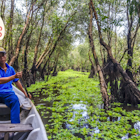
Nov 17, 2023 • 5 min read

Nov 16, 2023 • 7 min read
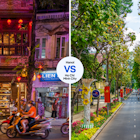
- Work With Us
- Blogging Bootcamp

- Van Conversion Academy
- Campervan Shop
- Campervan Rentals
- Plan a Trip
- Itineraries
- Destinations
- Responsible Travel
- Family Travel
- Budget Travel
- Scuba Diving
- Travel Credit Cards
- Digital Nomad
- Teach English Abroad
- Blogging Resources
- Income Reports
- Travel Shop
- Meet Katie & Ben
- About Two Wandering Soles
- Personal Stuff
- Portfolio & Press
Best Time to Visit Vietnam: When to Go & When to Avoid!
Home » Blog » Travel Tips » Best Time to Visit Vietnam: When to Go & When to Avoid!
Spanning more than 1,000 miles from north to south, the climate and weather of Vietnam can vary drastically depending on when and where you’re traveling. We’re going to walk you through the best times to visit Vietnam, and which times of year to avoid (if possible!).
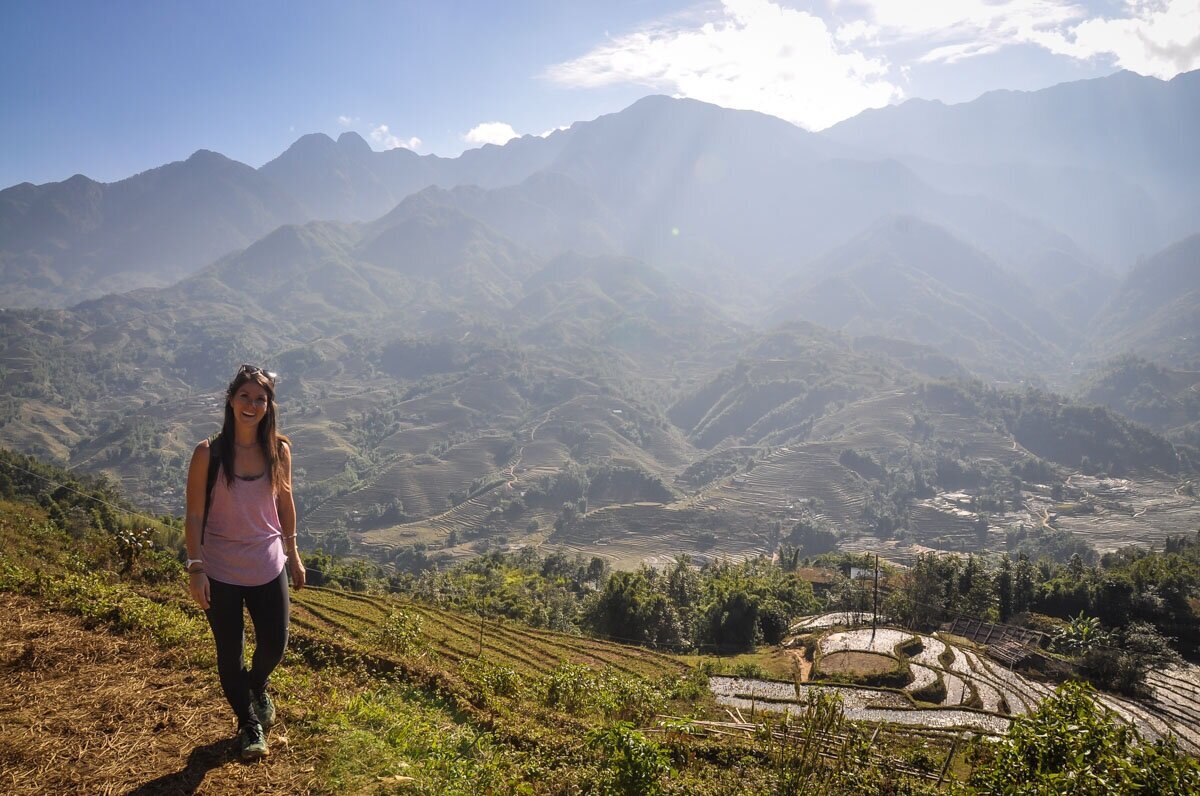
Planning a trip to Vietnam can be downright overwhelming. There are just so many places to visit (and things to eat!). When you start to factor in the best time of year to visit, it can make your head spin.
We know the feeling.
Here’s why it can be so complicated: Vietnam is a long and narrow country , spanning 1,025 miles (1,650 km) north to south. That’s roughly the same distance from Vancouver to San Fransisco, and means that the climate and weather varies drastically from north to south.
If you’re trying to figure out the best time to visit Vietnam, you’ll find it can be a little tricky to find a definitive answer especially if you plan to visit both the north and south of the country.
So this begs the question…
When is the best time to visit Vietnam?
In general, visiting during March – April gives you the best chance at dry weather throughout the country and temperatures won’t be quite as hot as they tend to get during the summer months (which is also peak dry season).
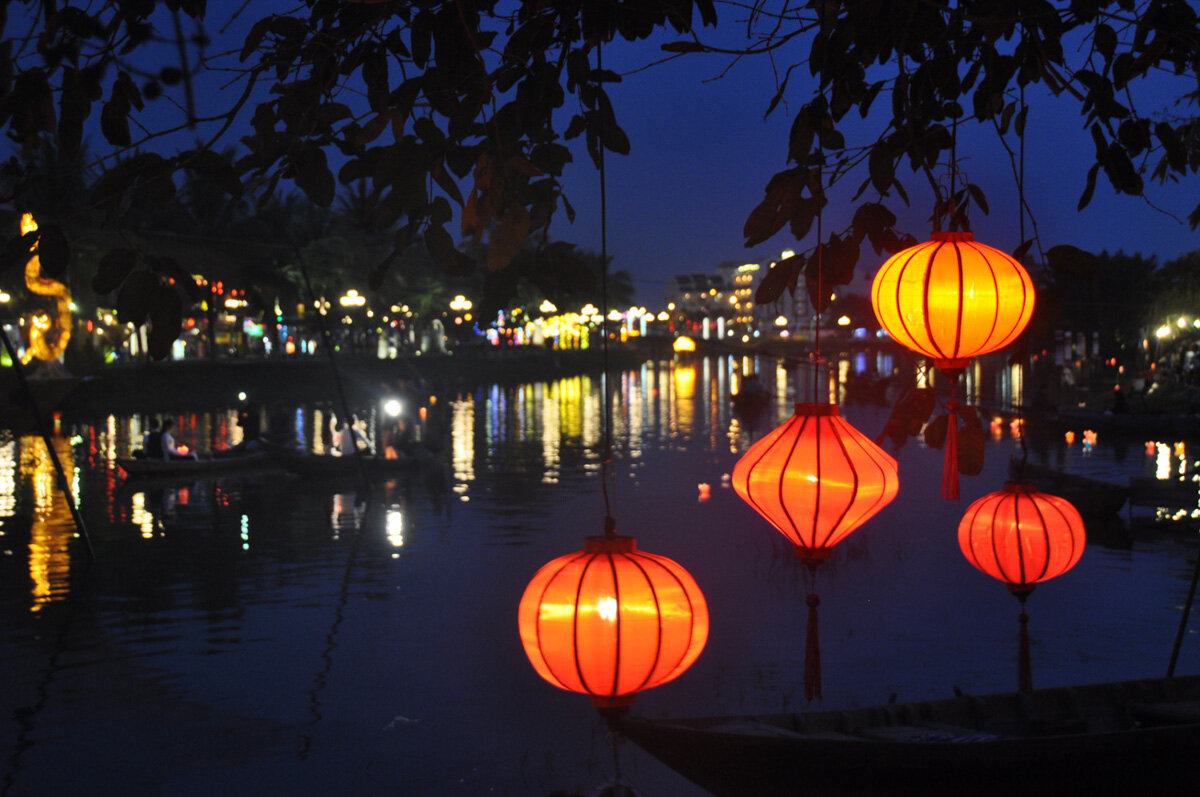
Of course, if you’ve read any of our other “Best Time to Visit” articles , you probably already know that this answer is a bit more complicated than that. As with most destinations, there are pros and cons to visiting during any season.
The best time to visit northern Vietnam is going to be different than the best time to visit the southern part of the country.
In northern cities like Hanoi and the mountainous area around Sapa, you’ll find the temperatures can get very cool, whereas Saigon (HCMC) and the Mekong Delta in the south tend to pretty much always be hot and can get quite humid.
But don’t worry, we’re going to go over exactly what to expect so you can plan your Vietnam trip based on your personal preferences.
Best time to visit Vietnam guide
- Our experience
Vietnam geography overview
Weather in vietnam, winter in vietnam, spring in vietnam, summer in vietnam, fall in vietnam.
Overall BEST time to visit Vietnam
Want a quick recommendation? Jump down to see our personal advice for the best time to visit Vietnam. Plus, we’ll share what times of year we’d avoid visiting!
- Our Recommendation…
Be sure to download our complete packing list for Southeast Asia ! It’s packed with good suggestions and insider tips to help plan your Mexico vacation. And it’s completely FREE , so why not!?
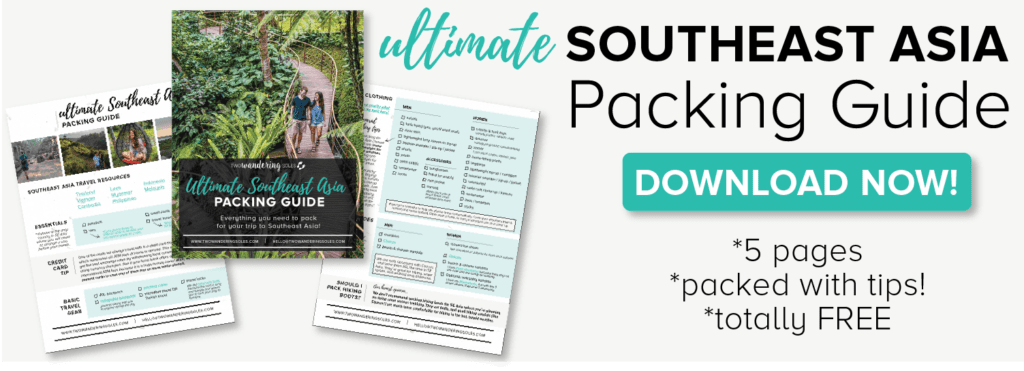
Our experience in Vietnam
We visited Vietnam in December – January
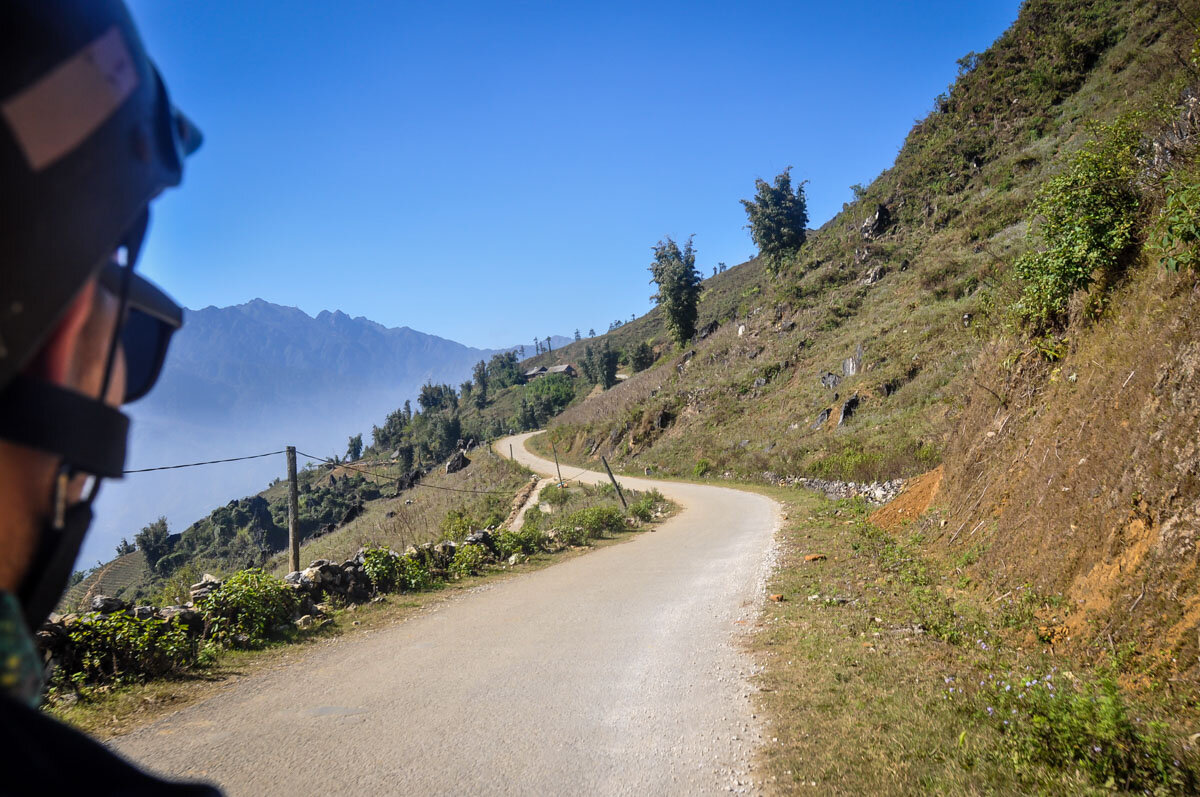
When: December – January (2016)
Our experience:
- We traveled from north to south and were surprised by how chilly it was in the north of the country in December .
- We had a lot of overcast days in Sapa, Hanoi, and Halong Bay.
- The middle of the country (around Hoi An) was sunnier with warmer weather.
Story time…
We spent about 6 weeks in Vietnam during December and January. Honestly, the weather in the north of the country wasn’t ideal — temperatures were cool (we wore light jackets on many days). But hey, we’re from Minnesota where it gets incredibly cold, so the temperatures weren’t what bothered us.
The main issue was that there were many overcast days, especially in the mountains, so spots like Sapa were shrouded in clouds for much of our stay. We had a lot of flexibility in our travel plans, so we were able to stay a few extra days until we got nice weather. (We lucked out!) And our time in Halong Bay was less of a tropical destination and more of a cloudy (yet incredibly fun!) cruise.
When we got to central and southern Vietnam, however, the weather was beautiful. Clear skies and warmer temperatures, but not too humid.
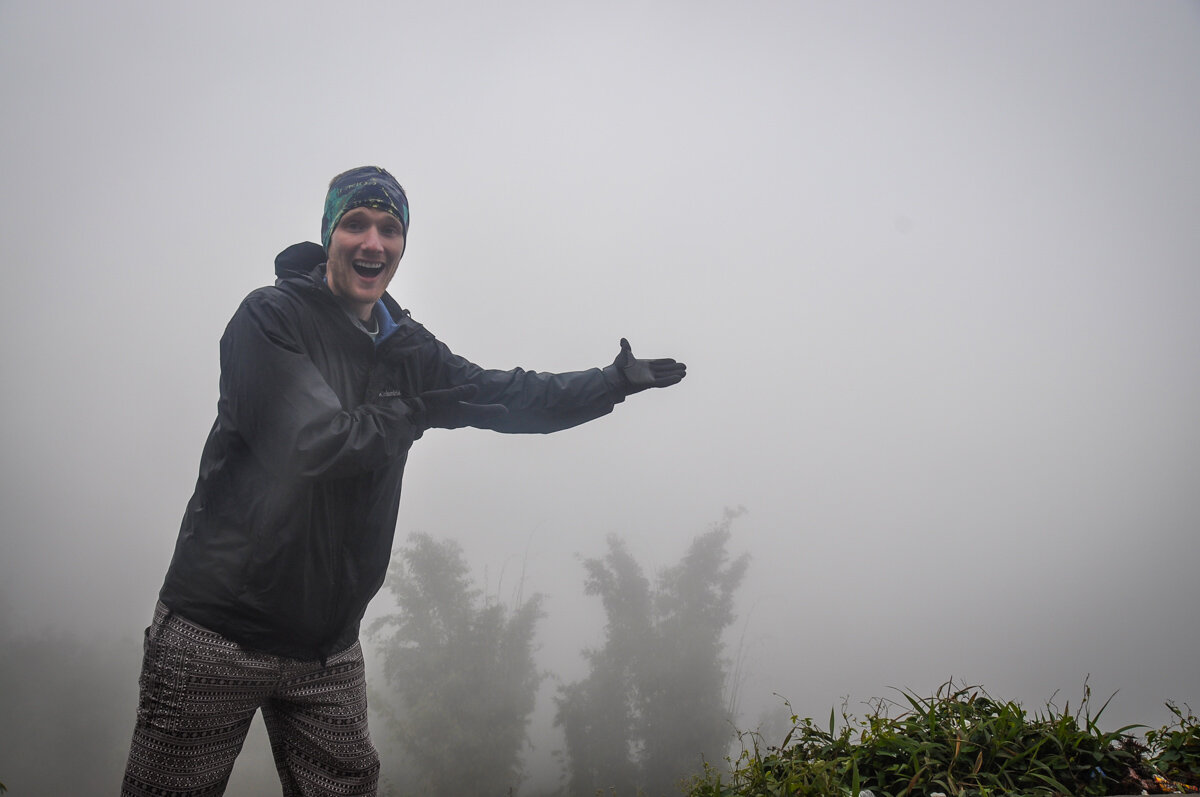
Overall, we had a fantastic trip, and since we were able to extend our stay in a few places where we had less than ideal weather, it wasn’t too big of a problem for us. However, if your travel plans have less flexibility, you might want to make sure you’re visiting Vietnam during a time of year where the weather tends to be more ideal.
Would we recommend visiting Vietnam in December – January?
Mostly, yes. The weather in the far north wasn’t ideal and Halong Bay wasn’t nearly as “tropical” as we were expecting at that time of the year. However, I’d take cooler weather over hot and humid!
From the middle of the country to the south, the weather was much better during that time of the year.
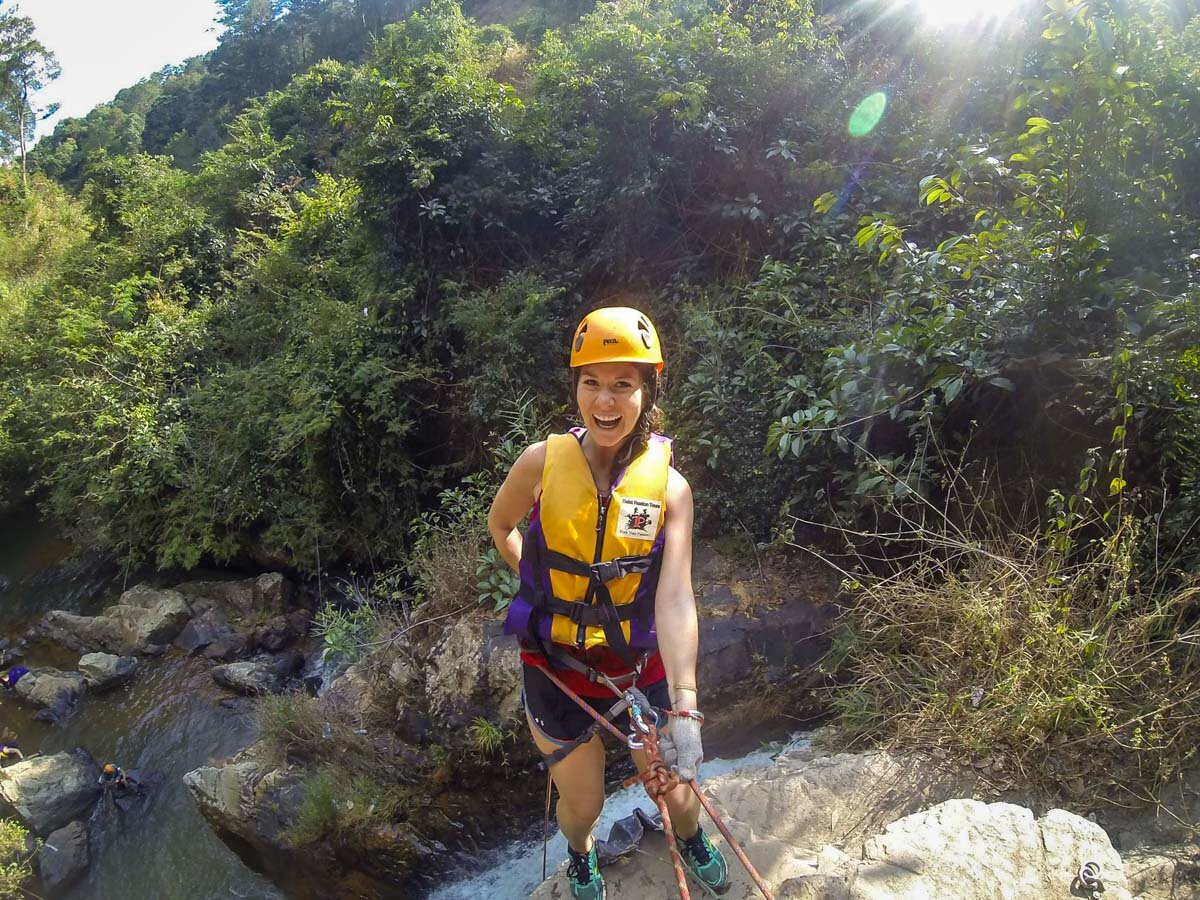
But don’t think we’re just gonna leave you hanging there!
Whether you’re wondering what time of year is best to plan your trip to Vietnam, or you have your dates set and are wondering what regions will have the best weather, we’ve got you covered.
We’ve organized Vietnam’s seasons by region, and listed some of the best things to do during each season all over the country. We hope reading through these suggestions will help you decide the best time to visit Vietnam for YOU.
Answer the following questions to get started:
- What region of the country do you plan to visit?
- Do you mind a bit of rain?
- Are you easily bothered by crowds?
- Are you negatively affected by high humidity? (I certainly am!)
- Do you prefer to spend your time outdoors hiking/trekking?
- Are you planning to hit the beach and soak in the rays?
Thinking about your answers to these questions is going to help you start to determine when to visit Vietnam.
Psst! Planning a trip to Vietnam? You’ll want to check out this rundown of the best Vietnamese street food to try before you get there!
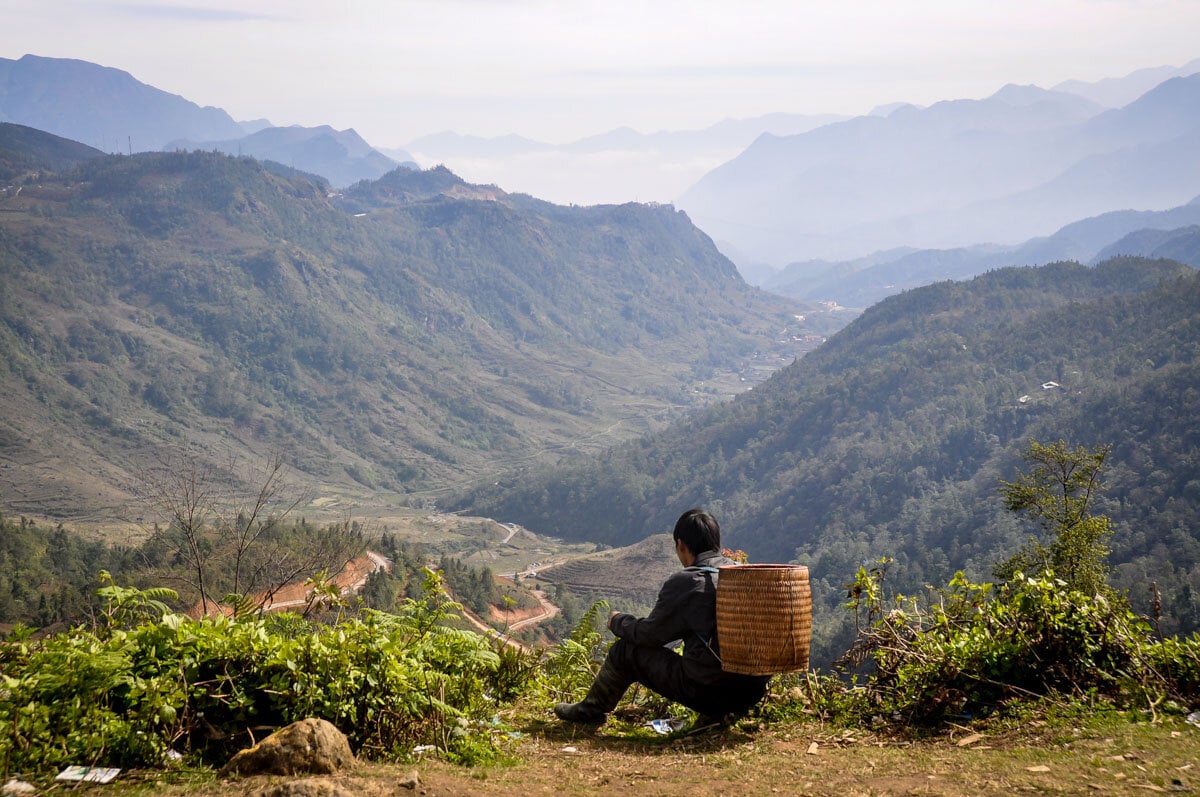
Alright, let’s get technical for a moment… This “S” shaped country occupies the majority of the eastern coast on the Indochina peninsula. The north-to-south distance of Vietnam is about 1,025 miles (1,650 km), with more than 2,000 miles of coastline (including islands). Level land covers no more than 20% of the country. You know what that means… MOUNTAINS!
The country can be divided into 3 regions: the highlands and the Red River Delta in the north, the Giai Truong Son (Central mountains) and coastal lowlands in the central region, and the Mekong River Delta in the south. The central highlands plateau spans from the south to the central part of the country as well.
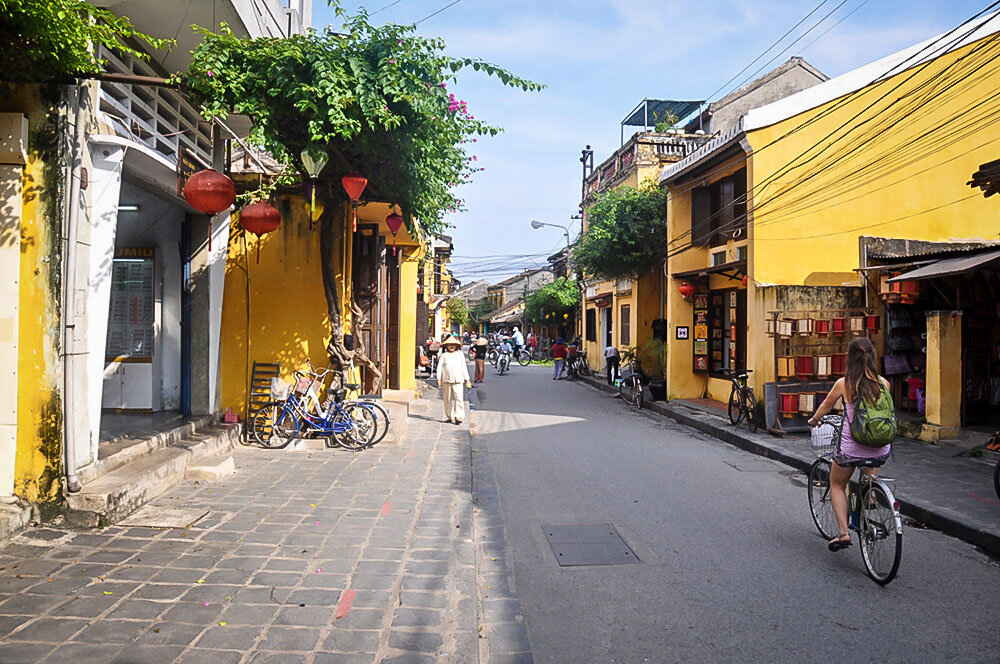
Vietnam has a tropical monsoon climate, with high humidity throughout the year.However, because of differences in latitude and the variety of topography, there are actually 3 different major weather systems affecting the country. The climate tends to vary considerably from region to region.
Below you’ll find a break down of the wet & dry season months in each region:
Northern Vietnam
- November – April: Dry season; cooler temperatures and sunny skies
- May – October: Rainy season; hot, humid & high rainfall
Central Vietnam
- January – August: Dry season; very hot
- September – November: Rainy season; daily showers
Southern Vietnam
- November – April: Dry season; sunny skies and very hot
- May – October: Rainy season; heaviest rainfall between June – August
Seasons in Vietnam
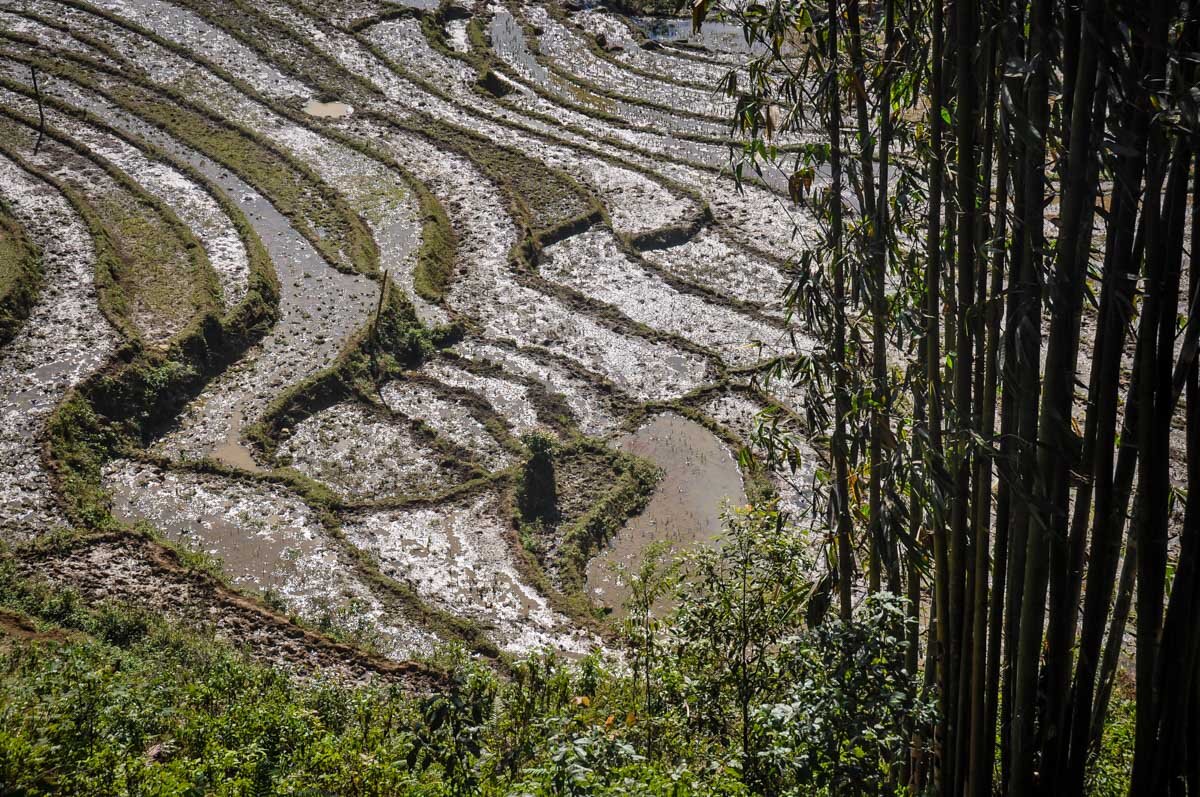
The country of Vietnam spans a very long distance from north to south. As you can imagine, the weather and climate in the north of the county varies significantly from the south.
For example, when it is winter in the northern hemisphere, cities in northern Vietnam like Hanoi and Sapa can get very cold. But during that same time, the southern part of the country will stay rather warm and not feel at all “winter-like”.
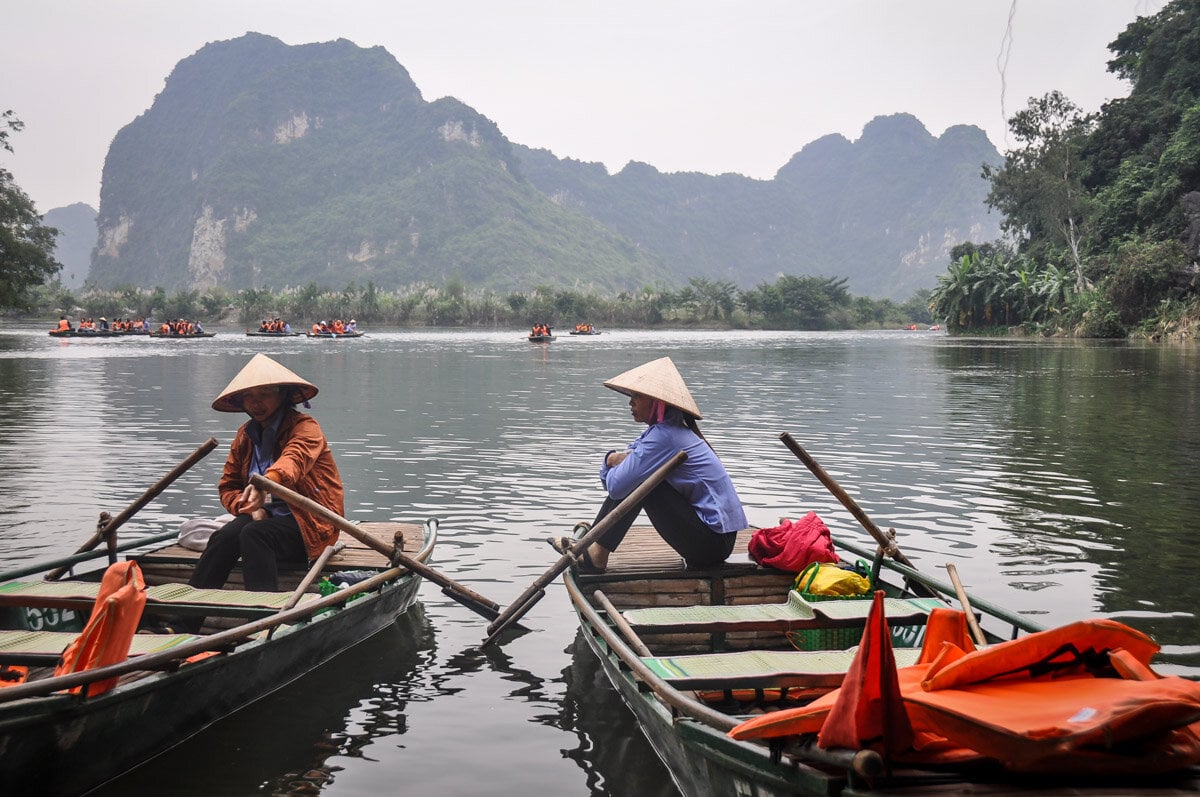
December: Most of Vietnam is dry this month, with exception of central Vietnam, with is just emerging from it’s rainy season. You’ll find comfortable temperatures in Ho Chi Minh and the southern beaches are particularly wonderful this time of year. The mountains in the north can get a bit chilly.
January: You’ll find cold winter weather in the far north during January with a misty rain all month, although Hanoi has comfortable temperatures. The south is in it’s peak of dry season and the central coast is emerging from it’s rainy season while places like Da Nang and Nha Trang being to see sunny skies once more.
Best places to visit during winter in Vietnam
- Southern coast/beaches (particularly Mui Ne and Phu Quoc island)
- Ho Chi Minh
Best things to do in Vietnam during wintertime
- Head to the beach in the south
- Water sports
- Scuba diving, particularly around Phu Quoc island
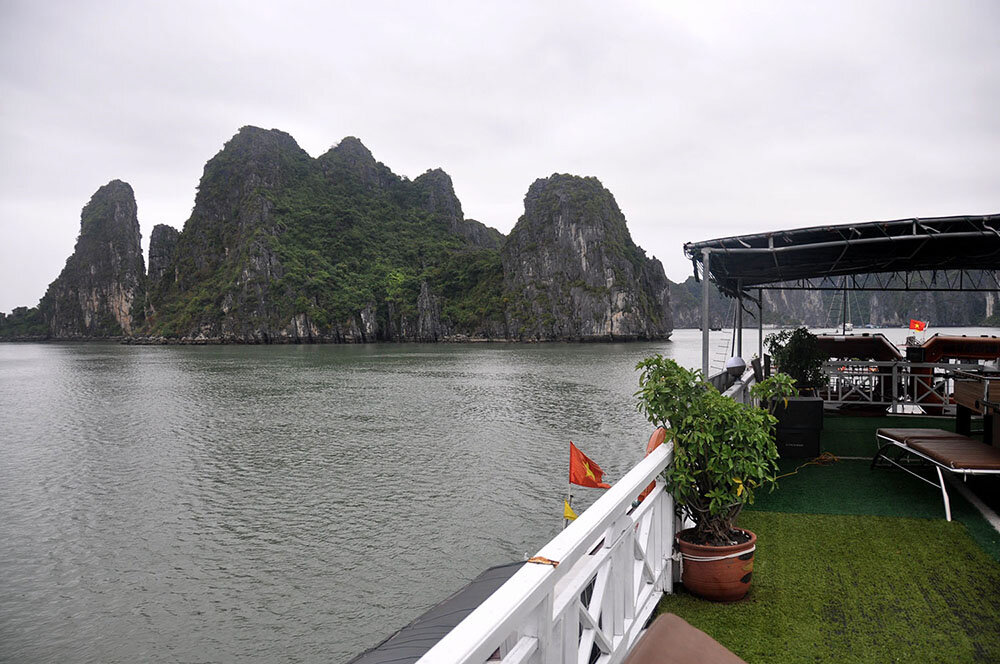
February: You’ll find the most optimal weather conditionals throughout the country in February. The south & central coasts are warm and dry. Though you may still get a touch of rain between Hoi An and Da Nang. Clear, warm days in the north make for good hiking weather. Let, the Vietnamese (Lunar) New Year and biggest festival of the year usually falls in February.
March: Perhaps the best month to see the whole country is during March. The skies over Halong Bay clear up and the central highlands are warm and dry along with the central and south coasts.
April: Temperatures are beginning to rise in the north, but spring flowers are in bloom. The central coast will have clear skies and warm days, perfect for beach weather, and the central highlands as well. There is a small chance of rain in southern Vietnam our April.
May: The south is moving into monsoon season with daily afternoon downpours, while the north is getting very hot. You may run into some rain in the north, but you’ll still see mostly clear skies. The central coast has the best weather in May with warm temperatures and sunny skies.
Best places to visit during the spring in Vietnam
- Halong Bay
- Hoi An , Da Nang, Nha Trang and Hue
Best things to do in Vietnam during springtime
- Hiking/trekking in the north & central highlands
- Celebrate Tet (the Lunar New Year and biggest festival in Vietnam). Most of the country shuts down during this period while Vietnamese take their holidays (and accommodation is hard to come by).
- Take an overnight junk boat cruise on Halong bay
- Visit Phong Nha Caves in Phong Nha-ke Bang National Park
- Hit up the south & central coast beaches
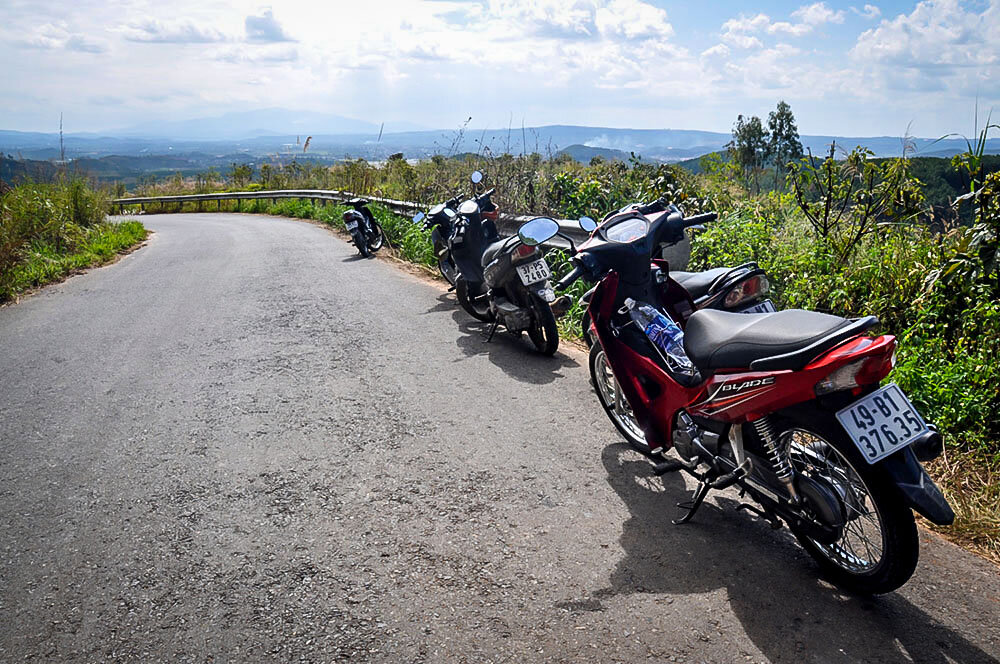
June: The south is in the middle of wet season and floods are increasingly common. Rain is increasing in the central highlands as well. The north is beginning to get wet and trekking can become challenging, although Hanoi and Mai Chau Valley are still mostly dry during June. Central Vietnam still sees pretty decent weather.
July: Brings with it heavy rain fall in both the north and south of the country. Flooding and washed out roads makes transportation a bit more of a challenge, even in major cities like Hanoi and Ho Chi Minh. The north and central coast is hot this month. Rain in the central highlands means it’s not a good month for trekking.
August: August means peak rainfall in the north and central highlands, so it’s definitely not a good time for hiking and trekking in Vietnam. You’ll see lots of rainfall at Halong Bay as well. Central Vietnam is still pretty clear, but that is coming to an end as rainy season is just around the corner.
Best places to visit during the summer in Vietnam
Best things to do in vietnam during summer.
- Visit central Vietnam beaches such as Lang Co Bay in Hue, Non Nuoc Beach in Da Nang, and Ha My Beach in Hoi An.
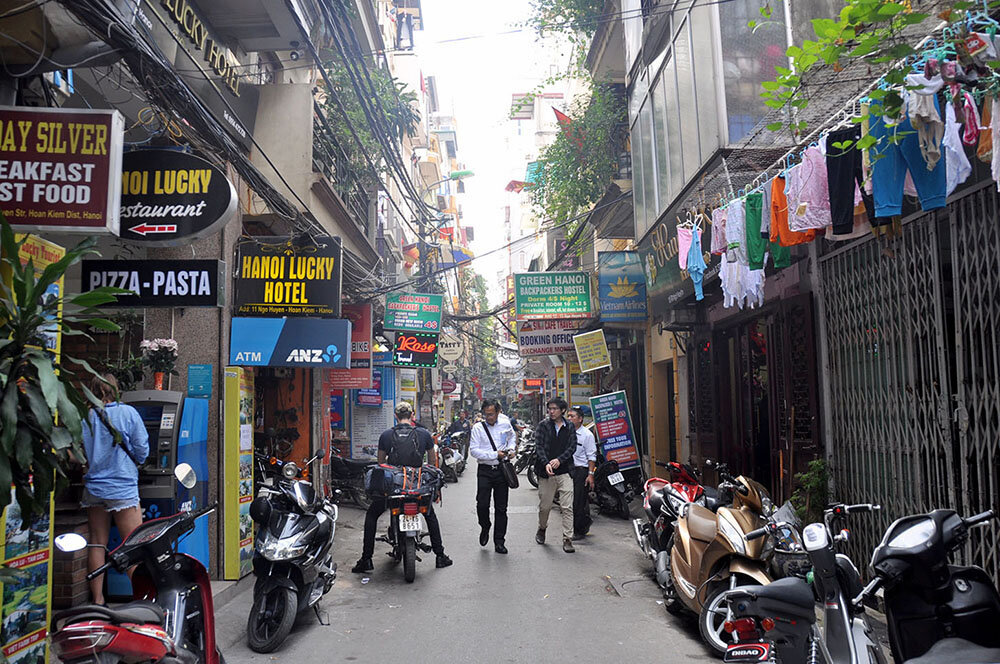
September: Temperatures are still high but rain is clearing up in the north and south of the country. Just in time for central Vietnam to begin it’s rainy season.
October: October is the best month for trekking in Vietnam. You’ll see ideal conditions in Sa Pa and the Dong Van Karst Plateau Geopark in Ha Giang province. Meanwhile, rain is dumping in central Vietnam and beach days are a thing of the past.
November: The north will have favorable weather conditions this month, while the south is seeing some balmy temperatures. It is still wet season in central Vietnam, and rip tides can get dangerously strong between Da Nang and Hoi An due to the northeasterly winter monsoon.
Best places to visit during autumn in Vietnam
- Sa Pa and the Dong Van Karst Plateau Geopark in Ha Giang province
- Mai Chau Valley (especially during harvest season in October)
- The North & South of the country
Best things to do in Vietnam during autumn
- Hiking/trekking in the North
- Hit up beaches in the South
- Visit the floating markets in the Mekong Delta
- Take a junk boat cruise on Halong bay (best time in November)
Best time to visit Vietnam in our opinion…
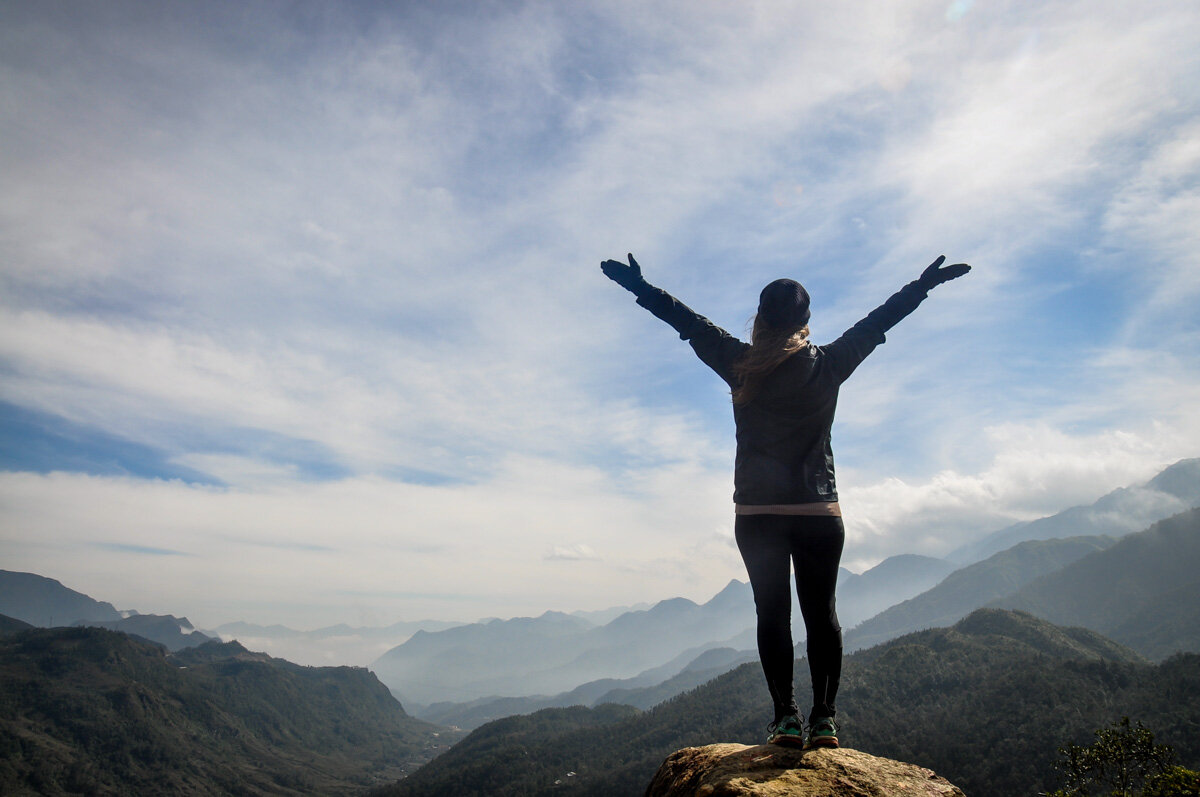
If you are looking to get the most out of your time in Vietnam and explore more than one region of the country, it’s a good idea to have the seasons in mind when planning your Vietnam itinerary and activities you’d like to experience during your trip.
Visiting during the springtime, February – April, will give you the most flexibility in your itinerary in terms of enjoying the best weather all around.
When to avoid visiting Vietnam
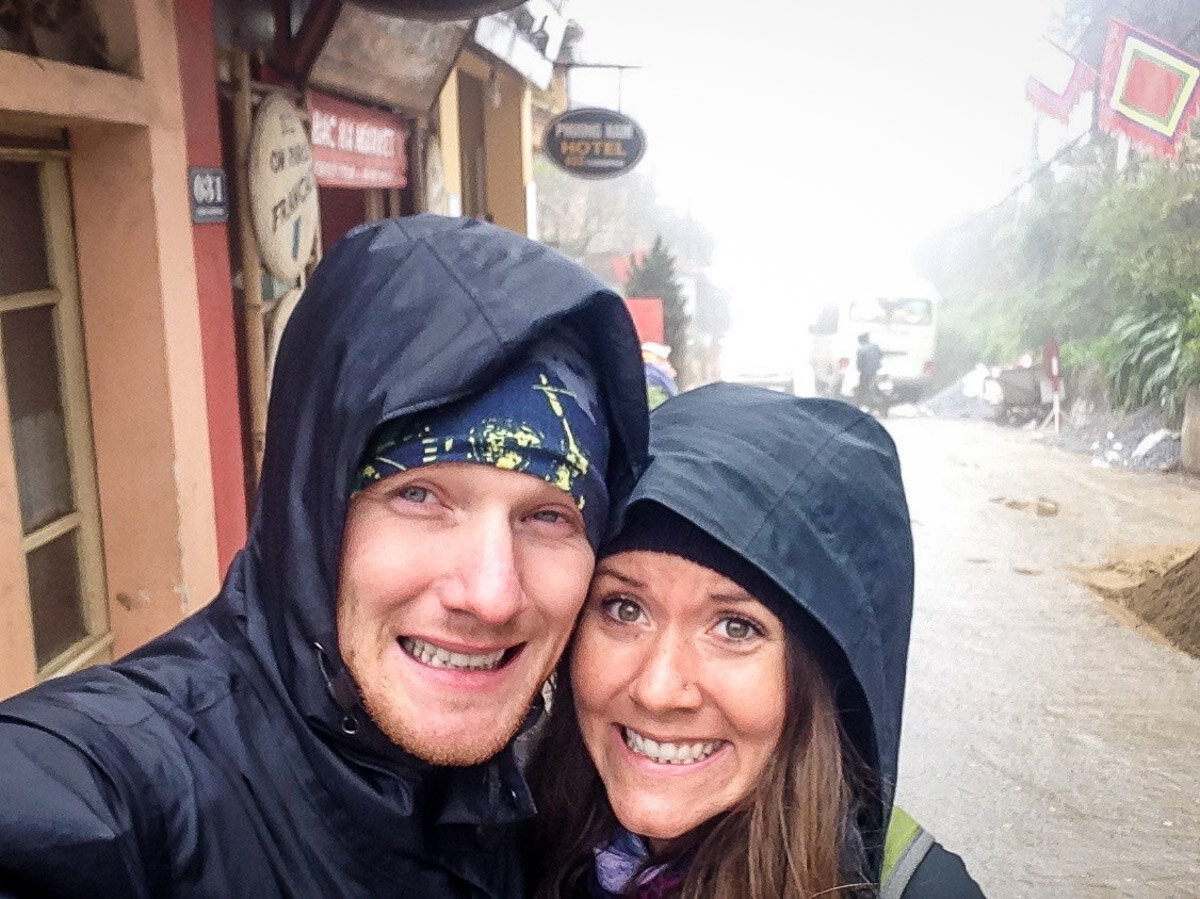
- Personal note: This was the only time that worked for us to visit Halong Bay. We actually rang in the New Year on a private island. While the weather wasn’t tropical like most of the pictures we had seen, we still had a fantastic experience meeting new friends (that we still keep in touch with!), seeing beautiful sights and learning more about Vietnamese culture. But if you think cooler and possibly overcast weather will ruin your time, opt for a different time of year.
- Hoi An: Avoid visiting in October due to heavy rainfall and possible flooding.
- Da Nang – Hoi An: Avoid swimming at the beaches in this central region during November as the rip tides can be particularly dangerous this month.
- Hanoi: Avoid visiting in July as heavy rainfall causes washed out roads and potential flooding.
- If planning to do some hiking or trekking : avoid visiting Vietnam during August as it will be the peak of rainy season in all the highlands.
- Summer: Unless sunning yourself on the central coast beaches is the only thing on your Vietnam itinerary , we’d suggest avoiding visiting the country during the summer months of June – August as you’ll have a much harder time with the weather.
What to pack for your trip to Vietnam
We know it can be overwhelming packing for a trip to a new destination. That’s why we spent hours creating this super helpful PDF just for you.
In this free SE Asia packing list PDF download , we’ve provided packing checklists for everything from clothing and toiletries (for both women and men!) to what shoes to pack and extra medicines you may want to have on-hand just in case.
Plus, we’re sharing tons of packing hacks and tips for traveling in SE Asia that you won’t find anywhere else!
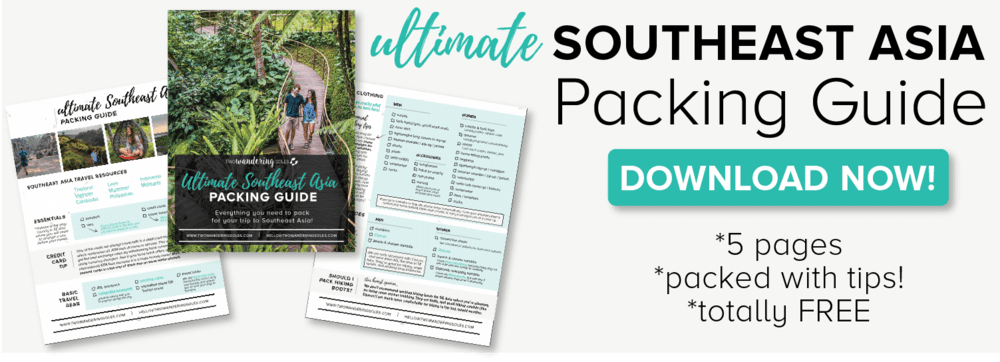
Are you planning a trip to Vietnam?
We have TONS of resources on travel in Vietnam and destinations throughout the country. Check out our Ultimate Vietnam Travel Guide for all the answers to your most burning questions, or read some of our favorite articles below.
- Perfect 1 Month Itinerary for Vietnam
- Vietnamese Street Food Guide: Delicious Dishes You Must Try
- Fun Things to Do in Hoi An
- Budget-Friendly Things to Do in Hanoi
Save this article on Pinterest for later!
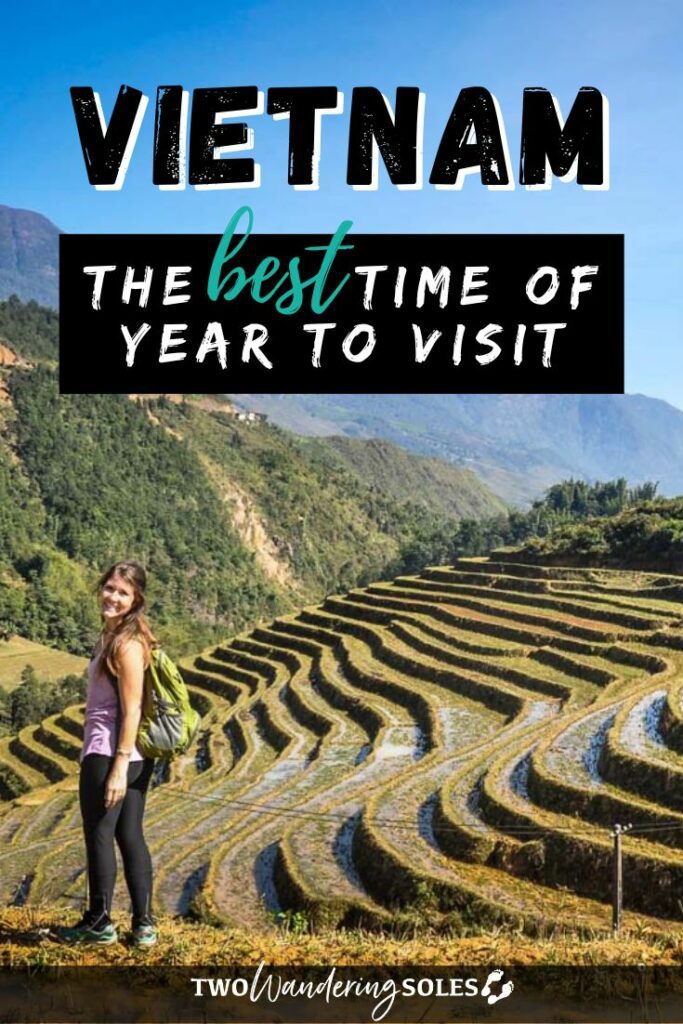
We want to hear from you…
Have you ever been to Vietnam? What time of year did you go and what was your experience there like? Comment below and let us know!
Comments (3) on “ Best Time to Visit Vietnam: When to Go & When to Avoid! ”
A very informative article. Information that will shed light on our path in our travels. Thank you for your effort.
Than you so much for all this great advice! I am enjoying your website! I can’t wait to visit Vietnam with my daughter, but once the pandemic ends we will still be limited by school schedules. Would two weeks over Christmas be preferable to 3 weeks over June/July? We want to see as many sights as possible, but don’t require warm weather or beach days. Thanks!
Your writing is great and very useful. It also guides me. I follow your website regularly. Thanks for the suggestions.
Leave a Reply Cancel reply
Your email address will not be published. Required fields are marked *
Save my name, email, and website in this browser for the next time I comment.

- Culture & Arts
- Ho Chi Minh City
- Attractions
- Phu Quoc Island
- Mekong Delta
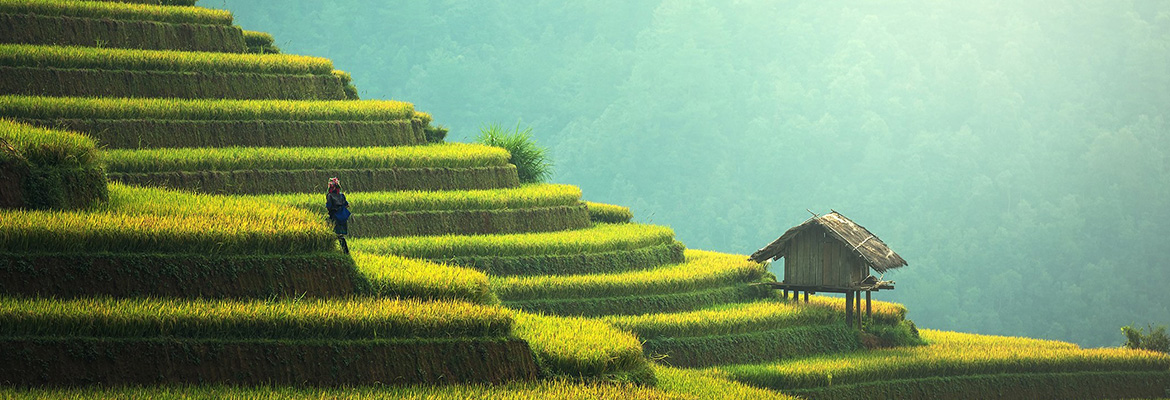
Best Time of the Year to Visit Vietnam
Vietnam Weather & When to Go to Vietnam
Are you a beach bum or an adventure lover? It does not matter that you are interested in a relaxing trip, a cultural trip or an adventurous one, Vietnam has it all.
Owing to gorgeous natural landscapes, paradise beaches, dynamic cities and unique culture, Vietnam can offer you a vacation with various possibilities.
Now, if you are attracted to the thought of traveling to Vietnam, you may wonder: What is the best time of the year to visit Vietnam ?
The answer is: your best time to go to Vietnam exactly depends on where you will go and what type of vacation you want to enjoy. Other factors attributing the decision when to visit Vietnam include holidays and festivals.
Choosing when to travel to Vietnam is crucial, both for packing purposes and personal comfort. Below we introduce a seasonal guide highlighting useful information about Vietnam climate, weather by month, and seasons in different regions of the country. Also, you will find an idea of when to visit northern, central and southern Vietnam in VietnamDiscovery ’s quick guide.
1. Vietnam Weather Overview
Due to the narrow and long shape, Vietnam has three primary regions, including north, central and south. Each one experiences different season features and weather events. At times, there can be white snow in the mountainous far north but sunshine and wind at the beaches in the south.
Vietnam climate varies throughout the country at different times of the year, so it is essential to distinguish between the featured weather and climate of each region in Vietnam.
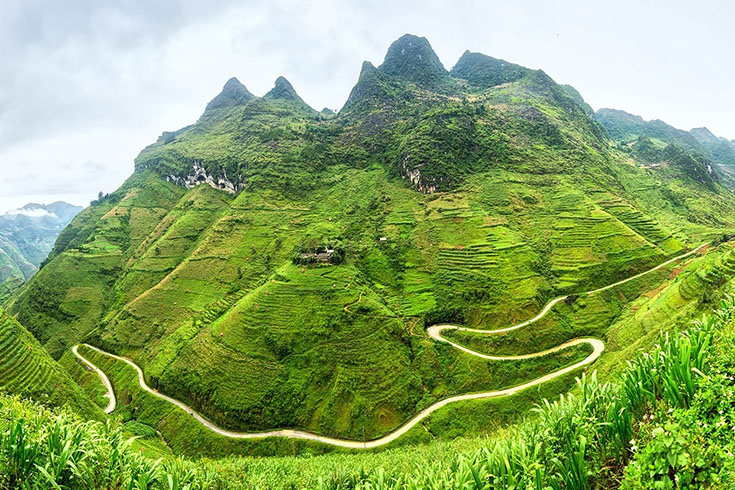
Vietnam weather highlights:
- The north of Vietnam: the climate includes 4 seasons, which are Spring, Summer, Autumn, and Winter. In northern provinces like Hanoi, the weather from May to October is hot and humid with rainfall, and cooler and dry from November to April. But in the far north, it can be very cold from December to January.
- Central Vietnam: The typical climate of central Vietnam is tropical monsoon, also known as tropical wet climate. This region experiences dry, hot weather from January to August with temperatures of up to mid-30°C; while the highest rainfall often happens in September, October, and November.
- The south of Vietnam : there are only two seasons, dry and rainy season in the south. It is dry and hot from November to April, gets wet and warm from May to October, and has the highest rainfall from June to August.
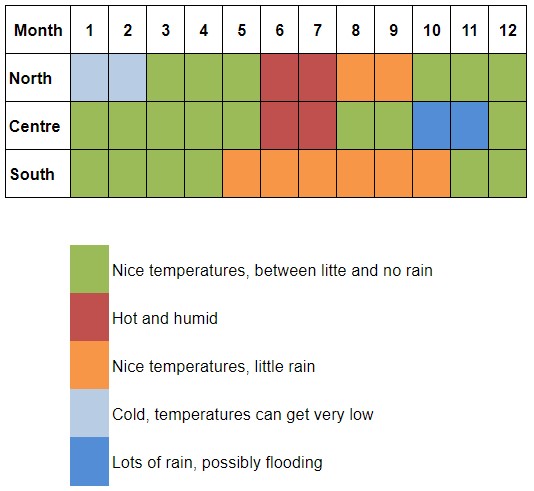
2. Vietnam Destinations By Region
A brief table of the best time of the year to visit Vietnam by region:
Now, let’s start to get to know more about the best time of the year to visit Vietnam by region:
2.1. The North of Vietnam + Mountainous Far North
2.1.1. mountainous far north: ha giang, sapa, bac ha, mu cang chai.
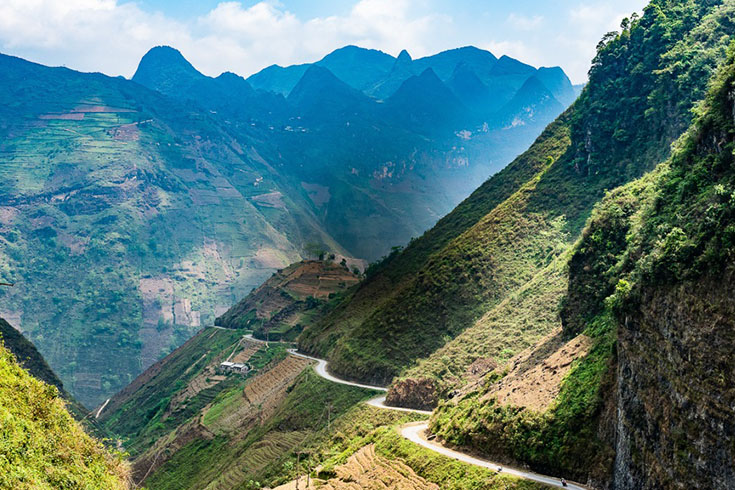
The climate in mountainous far north Vietnam (like Ha Giang, Sapa) and north-west region (like Mu Cang Chai) is split into two separate seasons: dry season running from October to late March and the wet season running from April to September. It becomes frosty and cold from December to January, particularly at night.
So the best time to visit this region is from October to April (during the dry season), despite it gets very cold from December to January. You should avoid traveling to mountainous far north Vietnam during the rainy season from May to September.
For those who love adventure and trekking, the best conditions for these activities in Mu Cang Chai and Sapa is from September to November and March to May.
In fact, cycling and trekking are practical all year round, but the winter months could be pretty chilly and the summer months are rather wet, so you had better consider these features before setting a plan for any activity in Vietnam.
2.1.2. Northern Vietnam: Hanoi, Hai Phong, Halong Bay, Mai Chau, Ninh Binh, Cuc Phuong,…
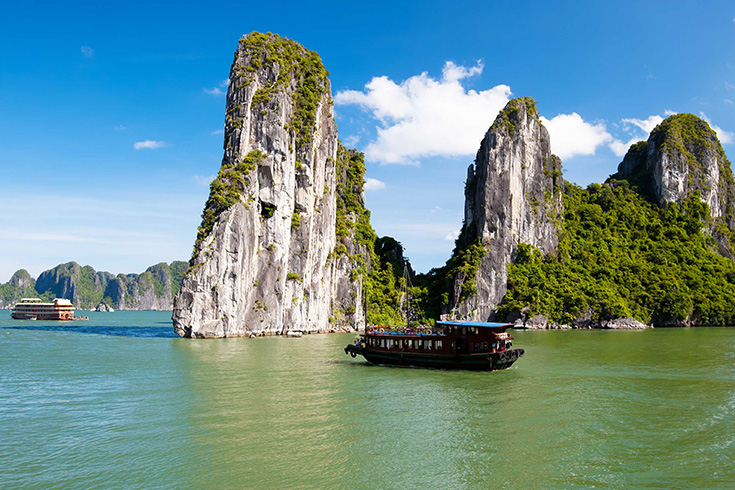
Generally featured by the tropical climate, the north of Vietnam has four distinct seasons, namely spring, autumn, summer and winter.
The best time to visit northern Vietnam is spring (from March to April) and autumn (from September to November).
The worst time to visit the north of Vietnam is from May to early September. This is the rainy season in full swing and the air is humid and hot, which is particularly out of comfort zone for most European tourists.
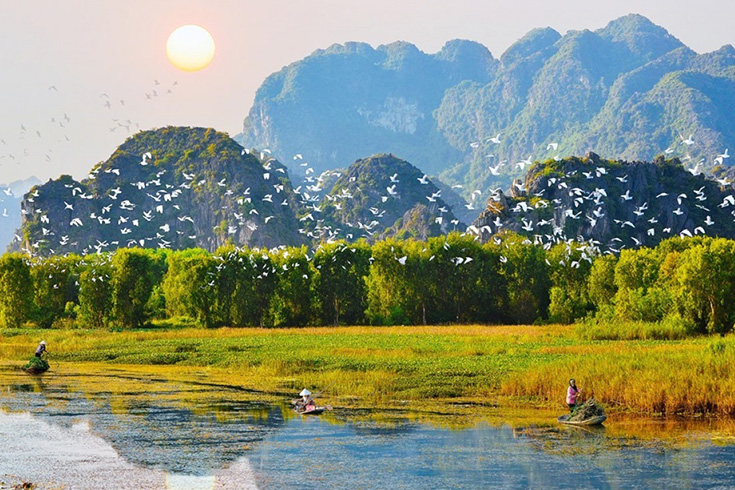
2.1.3. Northern Vietnam Weather Highlights
Northern topography is complex and various with plains, mountains, coasts and continental shelves, but the climate here is basically continental climate, as affected by the Chinese mainland weather.
Northern provinces of Vietnam experience cold dry winters from December to February, with a minimum temperature of 15°C. The coldest months of the year are December and January, with a maximum temperature of around 20°C.
The summer lasts from May to September, with hot and humid weather and the highest rainfall. If you do not have any problem with hefty rainfall, then you can still explore North Vietnam during these months. Nevertheless, keep an eye on weather forecasts to avoid the typhoon.
The high level of humidity could be somehow grueling at times, but local natural flora is incredibly lush owing to the rain.
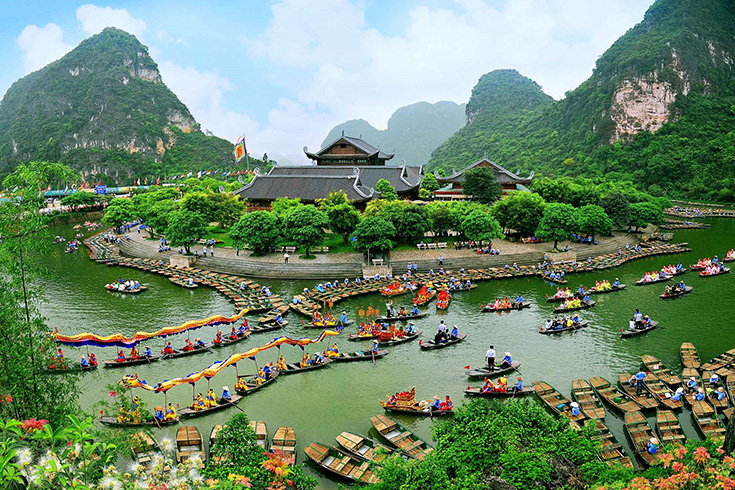
The best time to visit North Vietnam includes:
- November: about 26°C, with 5 sunshine hours, 5 rainy days, 25°C water temperature
- December: about 22°C, with 4 sunshine hours, 3 rainy days, 22°C water temperature
- January: about 20°C, with 3 sunshine hours, 5 rainy days, 20°C water temperature
- February: about 21°C, with 2 sunshine hours, 7 rainy days, 19°C water temperature
- March: about 23°C, with 2 sunshine hours, 11 rainy days, 20°C water temperature
- April: about 27°C, with 3 sunshine hours, 9 rainy days, 23°C water temperature
Best places to visit in the North of Vietnam in each season:
What to pack:
- Light cotton clothes (summer)
- Warm duffle jacket and boots (winter)
- Good walking shoes
- Rain jacket
2.2. Central Vietnam
2.2.1. hoi an, danang, hue, nha trang, quy nhon, dalat.
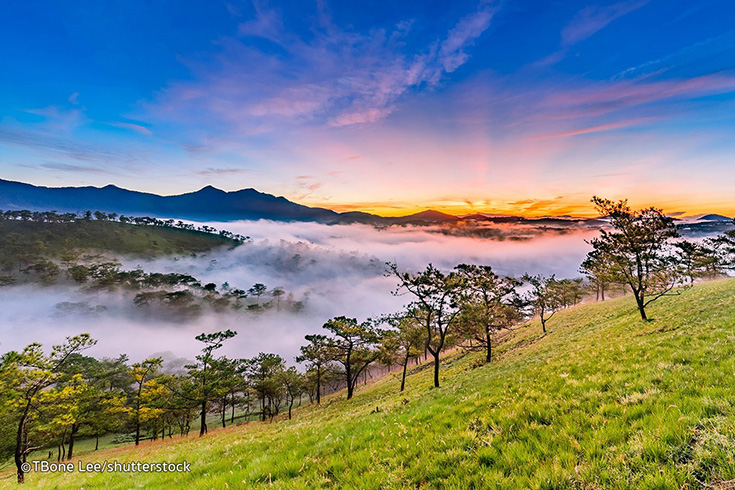
In general, the climate and weather in central Vietnam is a combination of that of the north and the south, which is a tropical, semi-humid climate. The difference between the climate in Central Vietnam and South Vietnam is that there will be more rain in the South.
Hoi An, Danang, and Hue are located in the center of Vietnam and feature hot and dry weather from January to August. During this time, the temperature reaches about the mid-30’°C, especially from May onwards, so it gets rather uncomfortable. From June to July, temperatures will not drop down below 24°C at night. Temperatures begin to decrease again after September, but precipitation increases until October and November.
The rainfall increases during winter months, with the peak levels in October and November. There are also occasionally typhoons with strong winds and heavy downpours in the winter, but fortunately, flooding is not heard during this time.

2.2.2. Central Vietnam Weather Highlights
The best time to visit Central Vietnam includes:
- February: about 26°C, with 5 sunshine hours and 6 rainy days
- March: about 27°C, with 5 sunshine hours and rainy days
- April: about 30°C, with 6 sunshine hours and rainy days
- May: about 32°C, with 7 sunshine hours and rainy days
Best places to visit in Central Vietnam in each season:
- Light cotton clothing
- Enough money to have a piece of tailor-made clothing made (Vietnam Dong/ US Dollars)
2.3. The South of Vietnam
2.3.1. Ho Chi Minh City (Saigon), Mekong Delta, Nha Trang, Phu Quoc island, Con Dao, Phan Thiet – Mui Ne, …
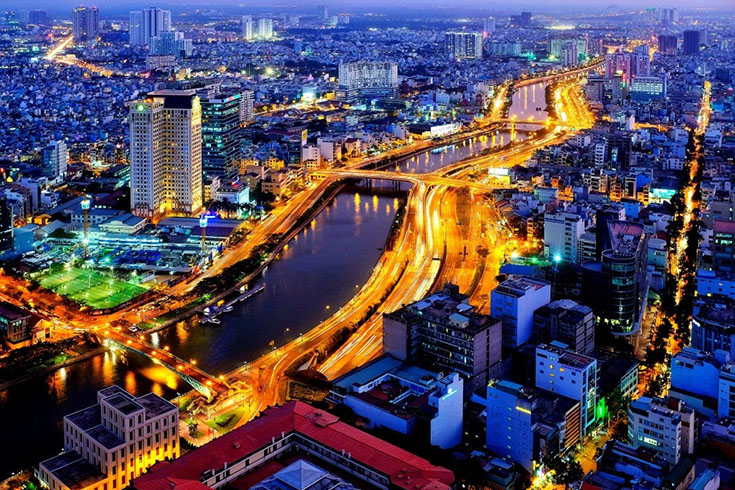
If you are fed up with the cold, grey weather in your hometown, Southern Vietnam is really an ideal place to take a break from it.
The best time to visit Southern Vietnam is months from December to April or May.
December, January, and February have maximal temperatures of 30-32°C with 2-7 rainy days while March and April are the hottest months of the dry season.
The rainy season in South Vietnam lasts from May to October. The months from June to September witness a particularly high level of rain while the least rainfall level is in February. But it does not get rain all day long, but happens accidentally and stops quickly.
In the South of Vietnam, the temperatures rarely drop below 20°C and high temperatures maintain across the year in both dry and rainy season. The climate of central highlands also follows the same pattern, despite temperatures are cooler, particularly at night.
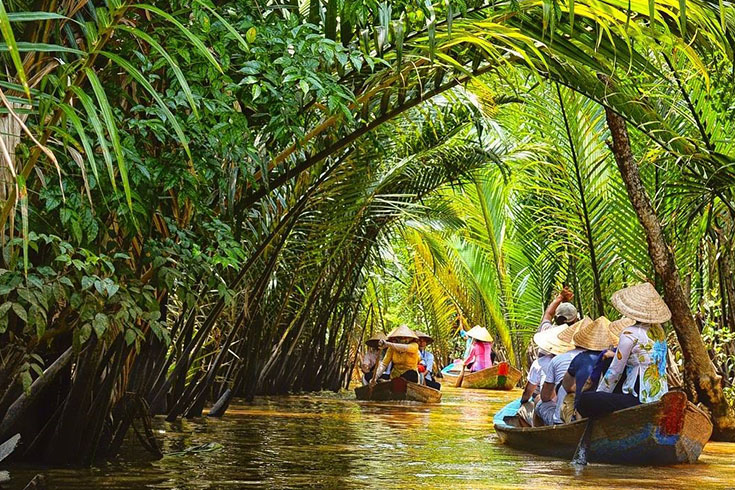
2.3.2. South Vietnam Weather Highlights
The best time to visit South Vietnam includes:
- December : about 30°C, with 5 sunshine hours, 7 rainy days, 28°C water temperature
- January: about 30°C, with 5 sunshine hours, 3 rainy days, 27°C water temperature
- February : about 32°C, with 6 sunshine hours, 2 rainy days, 27°C water temperature
- March: about 33°C, with 6 sunshine hours, 3 rainy days, 27°C water temperature
- April: about 34°C, with 7 sunshine hours, 4 rainy days, 28°C water temperature
Best places to visit Southern Vietnam:
- Light cotton clothes
- Quality walking shoes
3. Vietnam Destinations By Month
Best places to visit Vietnam each month:
4. Vietnam During Annual Festivals
Wondering about the best time of the year to visit Vietnam? Consider planning your trip to Vietnam during annual festivals to experience the culture and vibrancy of local Vietnamese.
4.1. Tet Nguyen Dan (Lunar New Year):
Among festivals, the most crucial and meaningful is “Tet”, also known as Lunar New Year, lasting for about 7 days from the last week of January and the third week of February. During Tet, most Vietnamese families gather to celebrate the festival and party-like atmosphere seems to cover every street corner of Vietnam, especially in the cities.
There are colorful decorations adorning streets (mainly red and gold), the incense’s scent in the air and splendid fireworks displays booming on the skies, and temples bursting with visitors at this time of the year.
4.2. Danang International Fireworks Festival (DIFF):
Celebrated in April annually, this festival is a dazzling performance of fireworks displays with the participation of both local and international teams.
In the festival, Danang city is lightened up in creativity and spectacular colors There is a different theme in annual festivals and each team uses their fireworks performances and music to relate a story about that theme in their own manners.
It is said that there is no better time to visit Danang than this time of the year. Besides enjoying the fireworks performances along the eastern side of the Han River, tourists can also contemplate natural landscapes and take part in fun-filled activities in Danang.
4.3. Hue Festival:
Taking place from April to May every two years, this 6-day festival boasts a spectacular range of shows, performances, art exhibits, and cultural activities that celebrate the history and cultures of Vietnam from 19 different countries around the world.
Ao Dai fashion show, echoes from Perfume River , Hue Citadel, Hue royal inspiration, international art troupes are among noticeable highlights of the festive that you can enjoy if you find yourself in Hue at this time.
Indeed, recommending exactly the best time of the year to visit Vietnam could be a little bit hard because of the difference in geographical circumstances in each region. Nonetheless, one rule of thumb is to visit this Southeast Asian country during the dry season to avoid possible storms or typhoons.
Hope that after reading this brief guide on the best time of the year to visit Vietnam, you to better plan your trip to Vietnam.
Most Popular

Vietnamese Silk Painting

Vietnamese Wedding Ceremony Tradition

Hoi An Old Town – an Ancient City in Quang Nam, Vietnam

Empty Your Pockets with 12 Best Vietnamese Foods That Rock!

Hoan Kiem Lake Hanoi – What to See & Do
Destinations, tours by style.
- Shore Excursions
Travel Guide
- Best Time to Visit
- Getting around
- Transportation
- Best Beaches
- Vietnam Honeymoon
- Travel esim to Vietnam
Our Company
- Responsible travel
- Terms of use
- Privacy Policy
- Recruitment
Connect with us:
- Email: [email protected]
- Hanoi, Vietnam: 23rd Floor, TASCO Building, Pham Hung road, Me Tri, Tu Liem, Hanoi.
- Ho Chi Minh City, Vietnam: 2nd Floor, VIPD Building, No. 4 Nguyen Thi Minh Khai, Da Kao Ward, District 1, HCMC
- Hong Kong: Vietnam discovery Travel Limited Room 1D, 2/F, Fu Tao Building,98 Argyle Street, Mongkok, Kowloon, Hong Kong

Where Do You Want to Go?
- Tell us details of your holiday plan.
- Get multiple quotes from our expert agents, compare, then customize further.
- Select & book the best deal.

The Best and Worst Time to Visit Vietnam in 2024
What is the best and worst time to visit Vietnam ? Does it make a difference when you go? Vietnam is a magical country to visit in Southeast Asia, best known for its delicious food, beautiful beaches, colourful markets, and UNESCO world heritage sites like Halong Bay, and the Old Town of Hoi An and Hue.
Vietnam stretches for around 1650 kilometres (1025 miles) from one end to the other and the weather varies a huge amount from the north to the south of the country. When it’s warm and sunny in Ho Chi Minh City it can be very wet on the beaches of Danang and freezing cold with snow in the mountains in Sapa.
South Vietnam has a wet and a dry season and North Vietnam has four seasons, spring, summer, autumn and winter. Although you can’t always predict the weather, some months are better than others for a holiday.
But the best time to visit Vietnam may depend on which part of the country you want to go to and what activities you plan to do when you’re there.
So, what is the best and worst time to Visit Vietnam ?
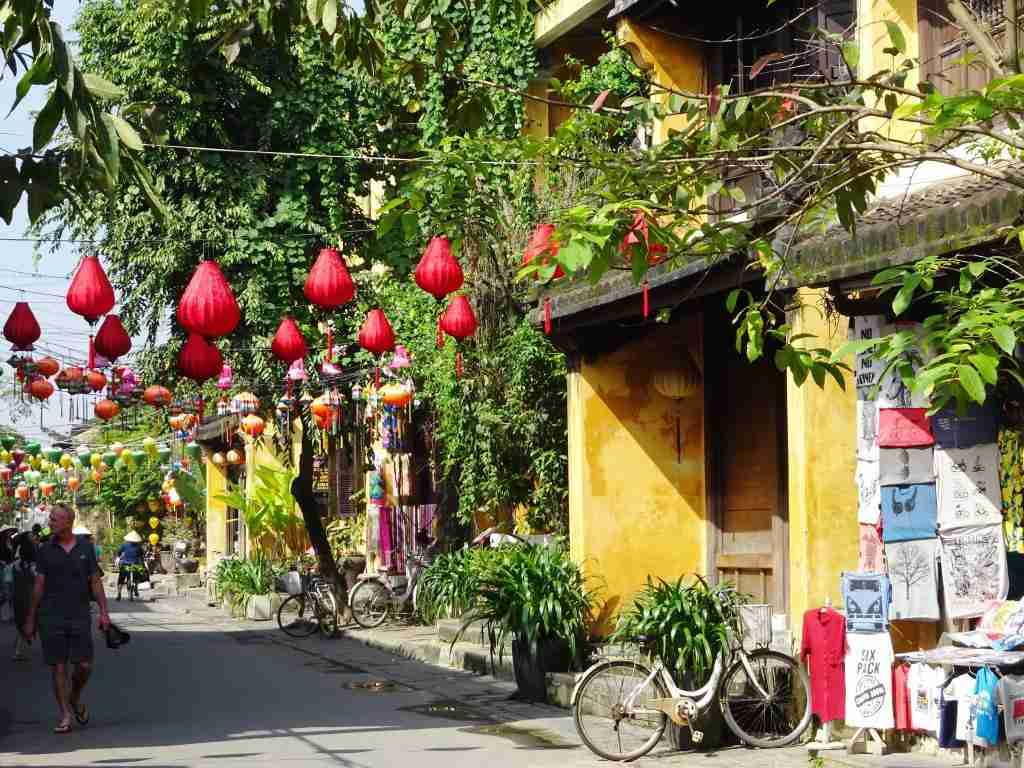
This page may contain affiliate links and, if you purchase through one of those links I may receive a small commission. This does not cost you any extra and helps to keep this website running . Thank you for your support!
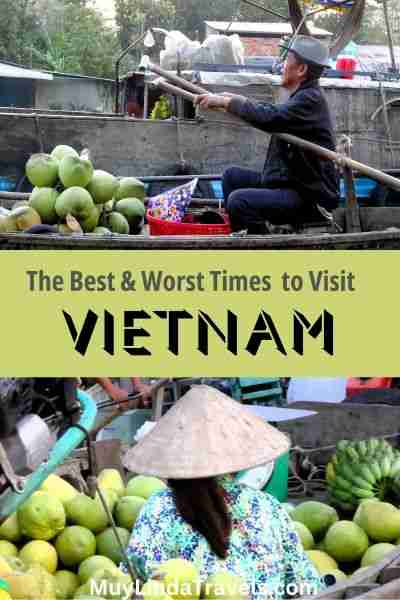
Table of Contents
The Best Time to Visit Vietnam
Broadly speaking, the best time to go to Vietnam is from November to April for good, all-round weather across the country. If you plan to visit Ho Chi Minh City, Hoi An and Hanoi, you’ll have the best chance of good weather during these months.
With a 3-week Vietnam itinerary , you can travel the length of the country and see the highlights of north, south and central Vietnam. Find out what it’s like to visit Vietnam in January.
- In North Vietnam , the best time to travel to Hanoi, Halong Bay and Sapa is in March / April or September / November .
- In South Vietnam, December to May has the best weather in Ho Chi Minh City, the Mekong Delta and Phu Quoc Island and you can explore the south with a 10-day Vietnam itinerary.
- In Central Vietnam , the best time for travel to Hoi An, Hue and Phong Nha-Ke Bang is from February to August. And you can see the highlights of Central and North Vietnam in 2 weeks.
But the best time to go to Vietnam depends on what you want to do when you’re there. For a beach holiday in Central Vietnam, the best months are February to June.
For hiking through the rice fields in the north, October to March are the dryest months of the year, and for relaxing on Phu Quoc Island, October to April are the best months to visit Vietnam’s tropical south .
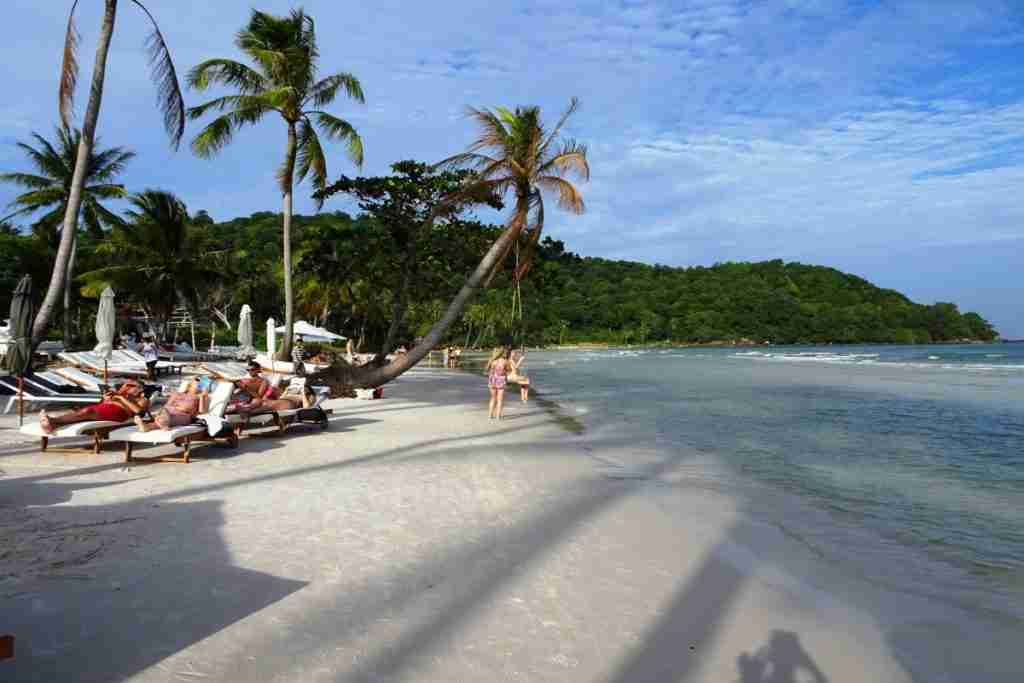
The Worst Time to Visit Vietnam
The worst time to travel to Vietnam is during the rainy season from May to October. Stormy weather and downpours are common during the wet season. Rainy weather is unpleasant for sightseeing and can wash out a beach holiday.
The Typhoon season, from June to September in the North and from September to November in the Central region, is the worst time to go to Vietnam. Around 4-6 typhoons hit Vietnam each year. These tropical storms cause flash flooding and landslides and can be very disruptive to travel.
In North Vietnam, May to October is hot and humid with high rainfall in Hanoi and Halong Bay. December and January can be quite cold in the north, especially in the mountains around Sapa where it sometimes snows.
If you don’t like the heat, the worst time to go to Vietnam is from March to May . South Vietnam is very hot with temperatures soaring to over 40°C (104°F) in Ho Chi Minh City and the Mekong Delta. If you plan to be in Ho Chi Minh City during these months, book a hotel with air conditioning and a pool.
If you don’t like crowds, July, August and December are the worst months to go to Vietnam. These are the busiest months for tourists and coincide with holiday periods in the USA, Europe and Australia. Popular venues and attractions can be crowded at this time. Hanoi, Halong Bay, Ho Chi Minh City and the beach resorts are at their busiest. It’s a more expensive time to visit and the worst time to travel to Vietnam if you’re on a budget.
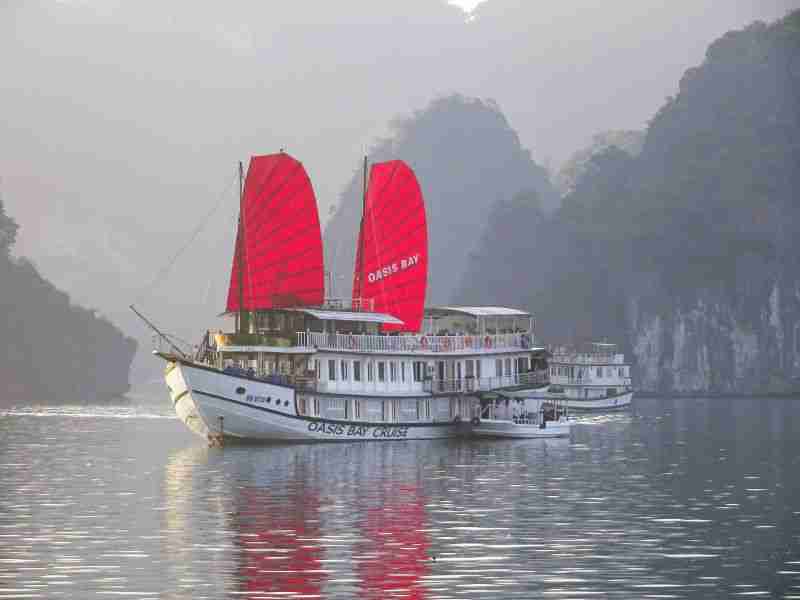
Tet or the Lunar New Year is one of the worst times to visit Vietnam and usually falls in late January or early February . In the days before the celebrations, markets and streets are packed full. People are travelling to reunite with their families and buses, trains and planes are booked out.
During Tet , everything stops and shops and markets are closed. The Lunar New Year can be a very frustrating and difficult time to be travelling in Vietnam.
September to November are the worst months to visit Vietnam for a caving expedition. During these months, the spectacular caves of Phong Nha Ke Bang National Park experience seasonal flooding . When the water rises the caves are closed for safety reasons.
The Cheapest Time to Visit Vietnam
The best time to visit Vietnam for cheaper prices is during the wet season from May to October . It’s the low season and there are fewer visitors, there’s less demand for flights, hotels and tours and prices fall. If you’re a budget traveller or you like a bargain, then May to October is the best time to visit Vietnam.
Least Busy Time to Visit Vietnam
April to June and September to November are the least busy months . It’s the low season and the best time to visit Vietnam to avoid the crowds of the peak season. These shoulder season months fall during the transition from the cool dry winter to the hot humid summer.
Although the weather can be unsettled with some rain, the shoulder season is the best time to travel to Vietnam alone , escape the crowds and minimise the extra costs of solo travel.
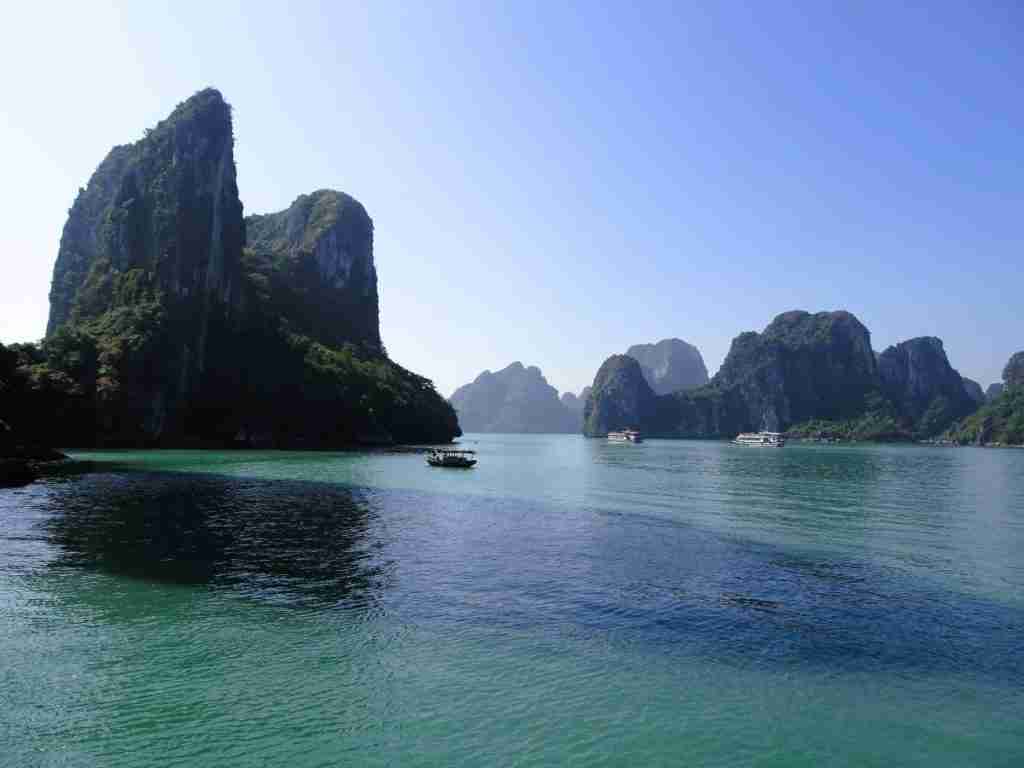
Vietnam Weather by month
Weather in january in vietnam.
North: Expect clear skies and cool dry weather in Hanoi and Halong Bay with average temperatures of 17°C (63°F) in January. Winter in Sapa can be very cold with lows of 5°C (42°F) and highs of 11°C (52°F).
Central: In central Vietnam it’s the end of the wet season. The days are hot with less rain and average temperatures between 19°C (66°F) and 25°C (77°F). Dalat and the Central Highlands are dry and cold at night.
South: January has the best weather conditions of the year in South Vietnam. In Ho Chi Minh City and the Mekong Delta expect hot, sunny and dry days with average temperatures ranging from 23°C (73°F) to 32°C (90°F).
Weather in February in Vietnam
North: Hanoi and Halong Bay are cool and dry with an average temperature range of 16°C (61°F) – 21°C (70°F).
Central: In February, there’s little rain in Danang and Hoi An and temperatures are slightly warmer this month with lows of 20°C (68°F) and highs of 26°C (80°F).
South: Ho Chi Minh City and the Mekong Delta are hot and dry with temperatures ranging from 22°C (72°F) – 36°C (97°F)
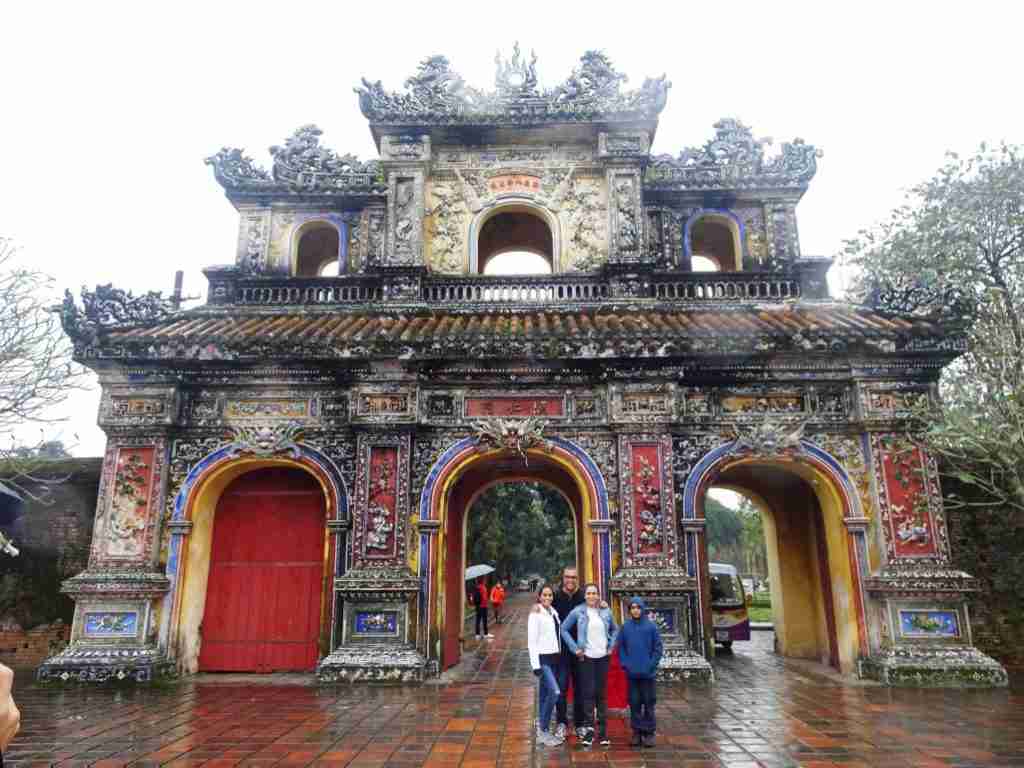
Weather in March in Vietnam
Dry season and a good time for a beach holiday
North: Hanoi and Halong Bay are cool and dry in March with slightly more chance of showers and temperatures ranging from 18°C (64°F) to 23°C (73°F).
Central: Conditions in Danang and Hoi An are dry and a bit warmer in March with highs of 28°C (82°F) and lows of 22°C (72°F). It’s good beach weather .
South : The weather in Ho Chi Minh City is dry and hot with highs of 30°C (86°F) and lows of 25°C (77°F).
Weather in April in Vietnam
Dry season and one of the best months to visit Vietnam but Typhoon season begins in South Vietnam.
North : Hanoi and Halong Bay are dry and warmer in April with a temperature range of 22°C (72°F) – 28°C (82°F).
Central: Danang and Hoi An are typically hot and dry in April with a temperature range from 24°C (75°F) to 31°C (88°F).
South: In Ho Chi Minh City, April weather is very hot and dry soaring temperatures from 26°C (79°F) – 37°C (99°F).
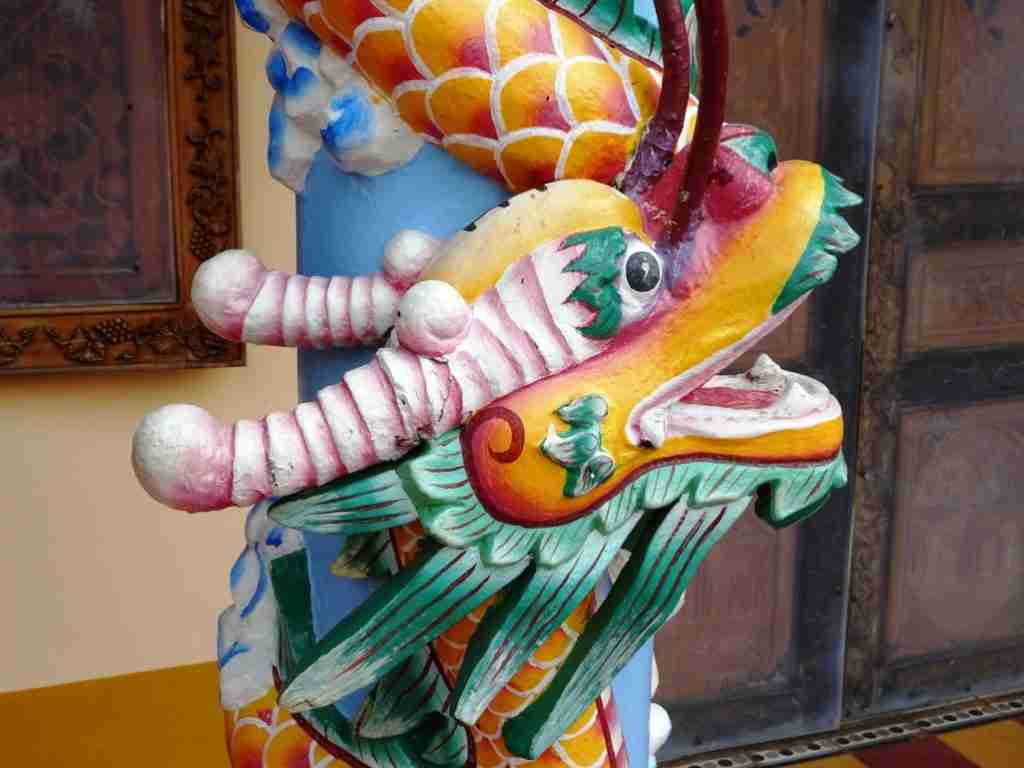
Weather in May in Vietnam
North: Hanoi is hot with more rain in May and temperatures range from highs of 32°C (90°F) to lows of 24°C (75°F).
Central : May weather is hot and dry in Hoi An and Hue with low temperatures of 25°C (77°F) and highs of 33°C (91°F). While the north and South of Vietnam are wet in May, it’s still good beach weather in Central Vietnam.
South: Expect very hot temperatures and some wet weather in Ho Chi Minh City in May with highs of 35°C (95°F) and lows of 26°C (79°F). Typhoon season begins in the south.
Weather in June in Vietnam
North: June in Hanoi is hotter with temperatures ranging from 26°C (79°F) to 34°C (93°F) and there’s more wet weather. The typhoon season begins in North Vietnam.
Central: June is even hotter with little rain and average temperatures ranging from 26°C (79°F) to 35°C (95°F).
South : Ho Chi Minh City is hot, very wet and humid in June with lows of 25°C (77°F) and highs of 32°C (90°F). It’s typhoon season in South Vietnam.
Weather in July in Vietnam
Peak season
North: July weather in Hanoi is still hot, very wet and humid with lows of 26°C (79°F) and highs of 33°C (91°F). It’s typhoon season in North Vietnam.
Central : July brings wetter weather and there’s more rain and humidity is higher. Temperatures are still hot and typically range from 26°C (79°F) to 34°C (93°F).
South: In July it’s marginally cooler in the south with hot, very wet weather and temperatures ranging from 25°C (77°F) and 31°C (88°F). It’s typhoon season in South Vietnam.
Weather in August in Vietnam
North: The weather in Hanoi and Halong Bay remains hot, very wet and humid in August with temperatures from 26°C (79°F) to 33°C (91°F). It’s typhoon season in North Vietnam.
Central: In Danang and Hoi An, the weather is a little bit cooler but still hot, wet and humid with temperatures from 25°C (77°F) to 34°C (93°F). It’s typhoon season in Central Vietnam.
South: August brings hot, wet and slightly cooler days to Ho Chi Minh City and the Mekong with average temperatures from 24°C (75°F) to 30°C (86°F). It’s typhoon season in South Vietnam.
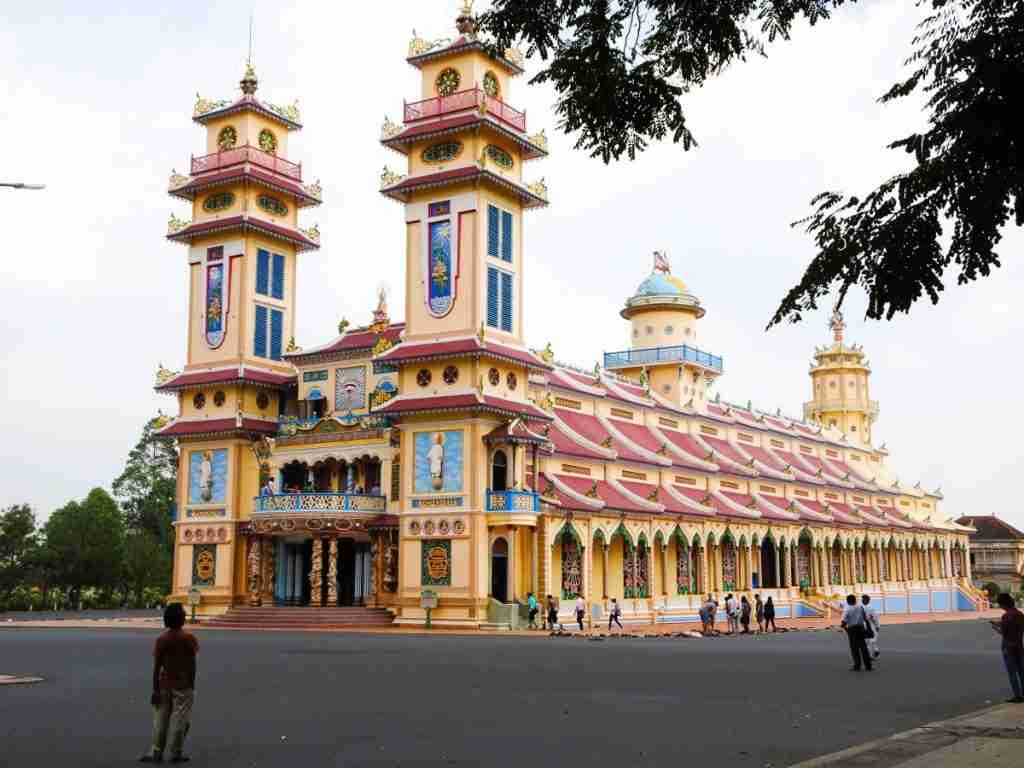
Weather in September in Vietnam
Shoulder season
North: Hanoi is slightly cooler in October but still very hot, wet and humid with temperatures from 25°C (77°F) to 32°C (90°F). It’s the end of the typhoon season in North Vietnam.
Central: September in Danang and Hoi An typically brings hot weather. Temperatures are a bit cooler, from 24°C to 32°C, but there’s more rain and humidity is high. It’s typhoon season in Central Vietnam.
South: In Ho Chi Minh City the weather is warm and wet in September and average temperatures are similar to August and range from 24°C (75°F) to 30°C (86°F). It’s typhoon season in South Vietnam.
Weather in October in Vietnam
North: Hanoi in October brings less rain and cooler temperatures from 22°C (72°F) to 29°C (84°F). It’s the end of the wet season in North and South Vietnam.
Central: In October, the weather is typically cooler but still hot, very wet and humid in Hoi An with temperatures ranging from 22°C (72°F) to 27°C (81°F). It’s typhoon season in Central Vietnam.
South: October is still hot in Ho Chi Minh City and there’s less rain. Temperatures are slightly warmer ranging from 24°C (75°F) to 31°C (88°F). It’s the end of the typhoon season in South Vietnam.
Weather in November in Vietnam
Dry Season
North : The weather in Hanoi in November is dry and it’s cooling down with temperatures ranging from 19°C (66°F) to 26°C (79°F).
Central: Danang and Hoi An are very wet and humid in November but temperatures are similar to October and still warm, ranging from 22°C(72°F) to 27°C (81°F). It’s the end of the typhoon season in Central Vietnam.
South : November temperatures are slightly cooler than in September but are still hot and humid with little rain. Temperatures range from 23°C (73°F) to 31°C (88°F).
Weather in December in Vietnam
North: December in Hanoi is dry with cooler winter temperatures of 15°C (59°F) to 22°C (72°F).
Central : It’s still very wet and humid in December in Central Vietnam and temperatures are marginally cooler, from 20°C (68°F) to 25°C (77°F).
South : In December, South Vietnam is hot and humid with a temperature range from 22°C (72°F) to 31°C (88°F).
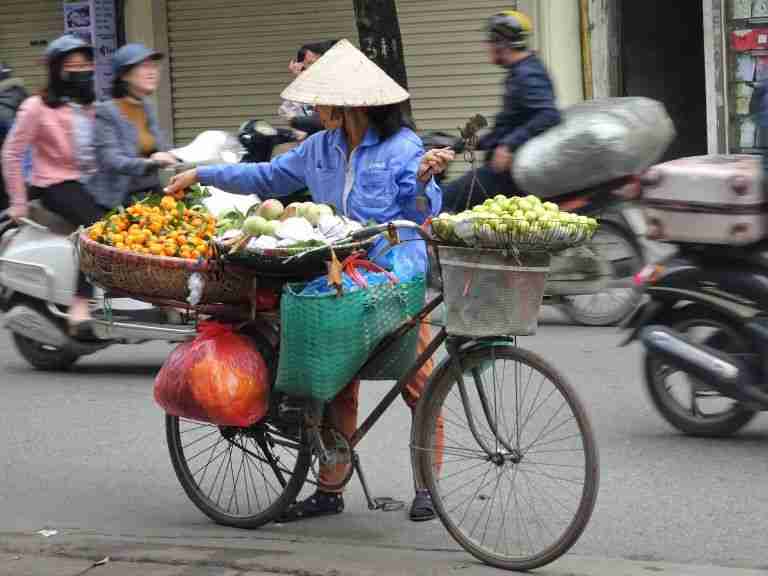
Vietnam in the Dry Season
The dry season is generally considered to be the best time to visit Vietnam. Warm and sunny weather with less rainfall is perfect for travelling, sightseeing and outdoor activities.
The dry season is the best time for a beach holiday, riding a motorbike, hiking and caving, but it’s the worst time to visit Vietnam if you’re on a budget or you want to avoid crowds of tourists.
But in Vietnam, the dry season falls in different months across the country.
In North Vietnam, the dry season falls in winter from November to April. From October to December the weather is warm and sunny. But December and January can be cold and dry in Hanoi and Halong Bay with freezing temperatures and snow in Sapa and the mountains.
In South Vietnam, November to April are the months of the dry season. The weather in Ho Chi Minh City and the Mekong Delta is dry and warm with average daytime temperatures of around 22°C (72°F) – 25°C (77°F). But April can be very hot in the south with temperatures reaching 38°C (100°F).
In Central Vietnam, the dry season falls from January to August. The weather in Hoi An, Hue and Danang is warm and sunny and it’s the perfect time to explore the Old Town of Hoi An, go sightseeing in Hue, enjoy a beach holiday in Danang or ride a motorbike over the Hai Van Pass.
Dry Season Pros
- The weather is at its best during the dry season, and it’s perfect beach weather. There’s little rain, temperatures are slightly cooler with less humidity.
- Seas are calmer and water visibility is good for snorkelling and diving .
- Dry weather is ideal for hiking and outdoor activities . It’s the perfect time to explore Vietnam on a motorbike.
- The dry season is the best time to enjoy Vietnam’s spectacular limestone caves at Phong Nha Ke Bang National Park.
Dry Season Cons
- July and August are the high season and crowds of visitors flock to Vietnam’s cities and beaches. Popular destinations like Halong Bay are crowded with tourists and it’s one of the worst months to visit Vietnam if you don’t like crowds.
- Accommodation, flights and tours are often more expensive at this time of year and it’s the worst time to visit Vietnam if you’re on a budget.
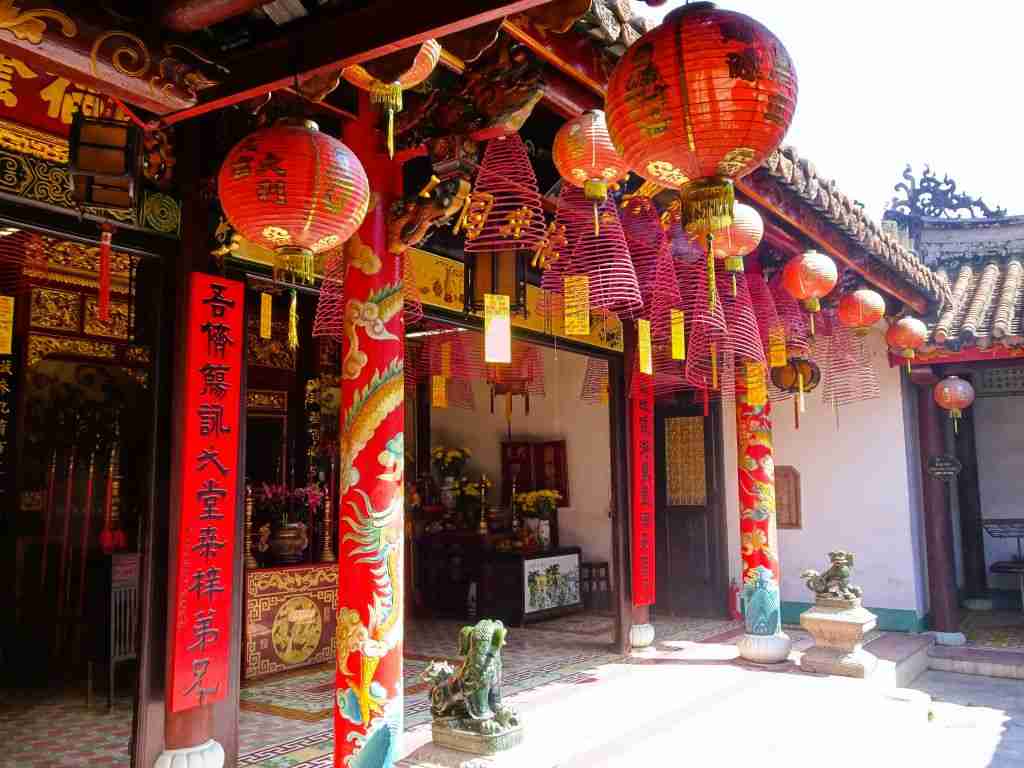
Places to Go in the Dry Season
The dry season is the best time to visit Vietnam for clear weather and for outdoor activities.
In South Vietnam , visit Ho Chi Minh City, explore the rivers of the Mekong Delta, visit the bustling floating markets in Can Tho and catch the Superdong ferry to Pho Quoc Island for a tropical beach holiday in the sun.
Go to Central Vietnam to visit the beautiful beaches of Nha Trang and Danang for swimming, surfing, and relaxing on the sand. Then travel inland to spectacular Phong Nha Ke-Bang National Park to explore the amazing UNESCO world heritage limestone caves or enjoy the charming lakes and waterfalls of Da Lat.
In North Vietnam, explore the country’s capital, Hanoi, a nd visit stunning Halong Bay. Discover the history, and beautiful landscapes of Ninh Binh or trek through the rice fields of Sapa and enjoy the green, misty mountain scenery and cooler temperatures.
TIP: Book your overnight Cruise to Halong Bay in a traditional junk boat. Spend the night on Halong Bay and wake up to watch the sunrise over the stunning landscape.
Things to do in the Dry Season
The dry season is the best time to visit Vietnam’s beaches and for outdoor activities like swimming , and surfing. The waters are calmer for taking ferry trips to offshore islands and water visibility is good for snorkelling and diving.
The dry weather is a good time for hiking in the mountains , trekking with gibbons in Cat Thien National Park , riding a motorbike, and exploring the Mekong Delta by boat . It’s also the best time to visit Vietnam for an expedition into the spectacular limestone caves at Phong Nha-Ke Bang National Park.
TIP: Immerse yourself in the local culture of the Mekong Delta on a tour from Ho Chi Minh City. Experience sampan riding along scenic waterways, tour a coconut farm and visit Vinh Trang pagoda.
What to Pack for the Dry Season
For visiting Vietnam during the dry season pack lightweight clothes, some long and short-sleeved shirts and trousers. A cool cotton dress or skirt and sandals will also be useful. Vietnamese people dress modestly and to fit in you will want to cover your knees and shoulders, especially when visiting temples. Take a sunhat, sunscreen and sunglasses and your swimmers.
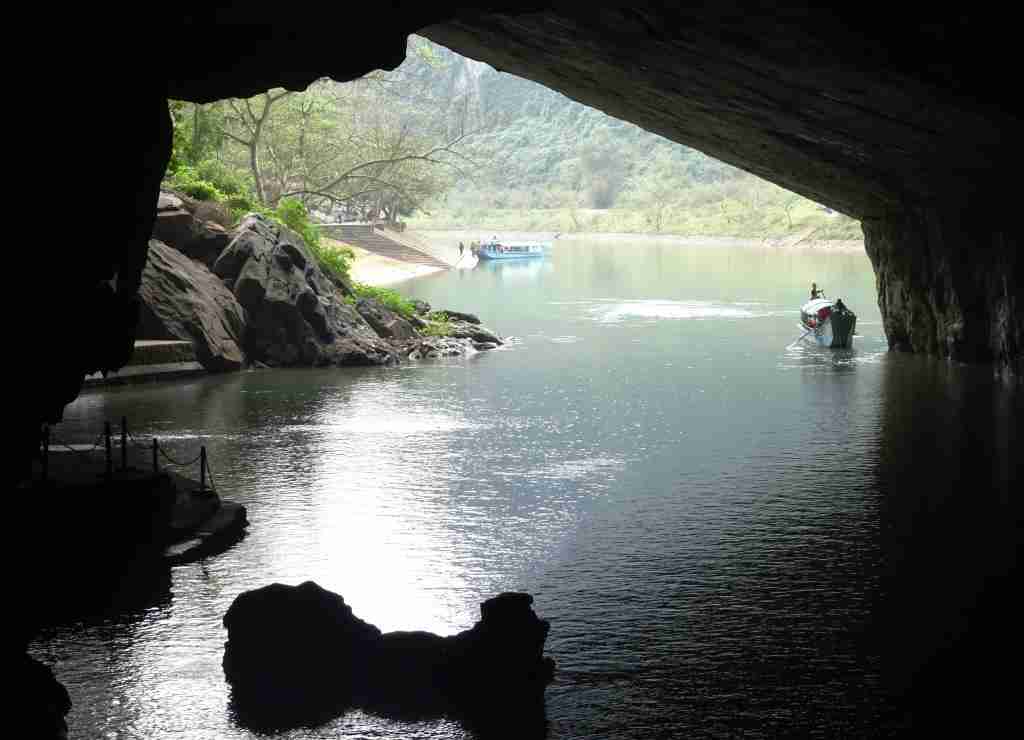
Vietnam in the Wet Season
The wet season is considered the worst time to visit Vietnam but you can enjoy a vacation in Vietnam at any time of the year. There’s no bad time to visit but some months are better than others.
During the wet season, the rain tends to come in afternoon downpours that clear after a few hours. Mornings are often clear but sightseeing and outdoor activities are less enjoyable if it’s raining and beach holidays can be washed out with persistent wet weather. Storms and typhoons can also cause flooding and landslides that disrupt travel plans.
But there are some advantages to travelling to Vietnam in the wettest months of the year. If you don’t mind some rain and you can be flexible with your travel plans, the rainy season can be the best time to visit Vietnam for some travellers.
Wet Season Pros
- There are fewer tourists in the wet season . It’s quieter on the beaches and popular destinations like Halong Bay and Hoi An are less crowded with tourists.
- Accommodation is cheaper . Some of the larger hotels and resorts offer discounted rates in the low season.
- Airfares are cheaper during the low season.
- Vietnam is lush and green at this time of year and the rice terraces are beautiful in the monsoon season.
- Vietnam’s waterfalls are at their best in the rainy season.
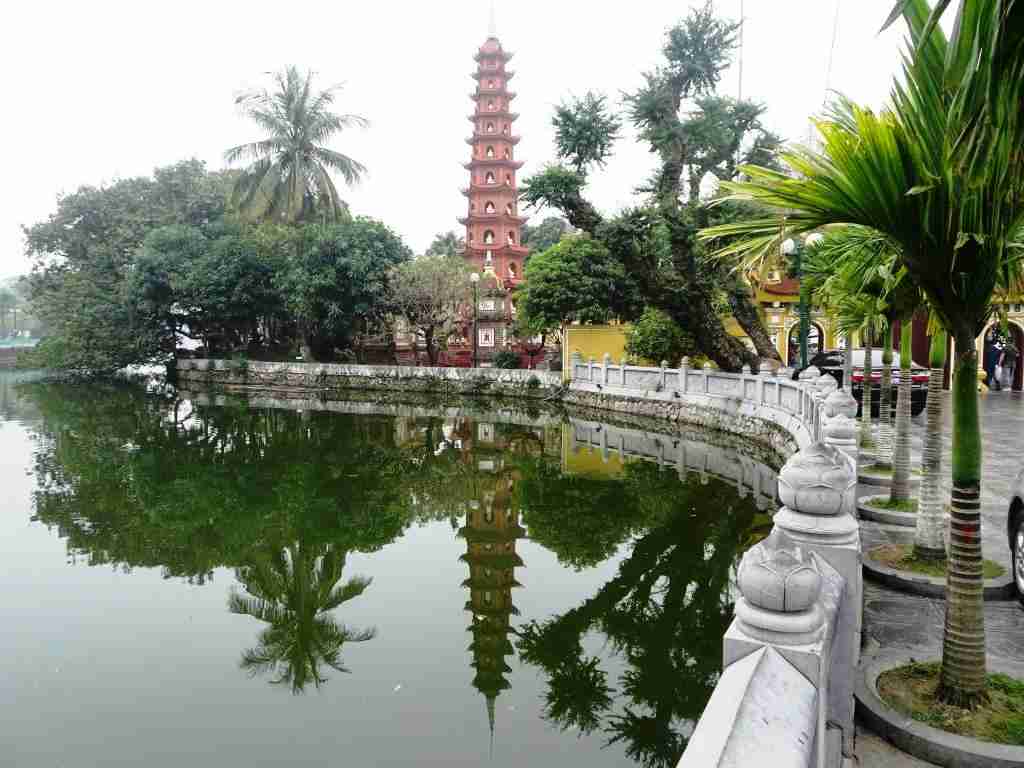
Wet Season Cons
- There’s more rain, afternoon showers and storms and typhoons can cause flooding and disruption to travel. Typhoon season is the worst time to visit Vietnam.
- The weather is hot, and humidity is high in the wet season.
- The rainy season is the worst time to visit Vietnam for outdoor activities like hiking or an easy-rider motorbike tour. It’s no fun being caught in a storm if you’re riding a motorbike.
- Seas are choppy and long ferry trips to the islands are best avoided.
- There’s the possibility of a beach holiday being washed out in the wet season and it’s the worst time to visit Vietnam for a beach holiday.
- Stormy weather causes poorer water visibility for snorkelling & diving.
Places to Go in the Wet Season
There are lots of places to visit during the wet season and it’s not necessarily the worst time to travel to Vietnam. If it’s raining, the big cities offer diverse cultural attractions and activities. Both Ho Chi Minh City and Hanoi have a wealth of history, art and culture to discover with many museums and temples, restaurants and indoor shops and markets.
In Central Vietnam, the Old Town of Hoi An has much to offer in wet weather with lantern-filled laneways, beautiful architecture, restaurants and galleries. In nearby Hue, the Imperial Citadel and the Royal Tombs offer insight into the fascinating history and culture of royal Vietnam.
Things to do in the Wet Season
For people who love culture, there are so many interesting things to do, the rainy season is one of the best times to visit Vietnam.
In Ho Chi Minh City, the War Remnants Museum and the Cu Chi Tunnels document Vietnam’s World War II history and the impressive Notre Dame Cathedral, the Central Post Office and the Cao Dai Temple are fascinating to visit.
The Ben Thanh Market is a place where you can shop for souvenirs and enjoy a delicious street food meal of Pho or Ban Mi at any time of the year.
In the capital Hanoi , the stately Temple of Literature and the oldest Buddhist temple in Hanoi, the Tran Quoc Pagoda are captivating places to visit. Enjoying a performance at the Hanoi Opera House , discovering Hanoi’s art scene , or visiting one of Hanoi’s many museums will keep you entertained on a rainy day.
One of the most interesting things to do in Hanoi is to join the long queue at the entrance to the Ho Chi Minh Mausoleum and view the embalmed body of the country’s much-revered leader.
And a Vietnamese cooking class or learning how to make colourful Vietnamese lanterns is a delicious way to immerse yourself in the local culture.

What to Pack for the Rainy Season
Pack a raincoat and clothes that dry quickly for the rainy season in Vietnam. The weather tends to be hot and humid so take lightweight shirts and trousers, sandals and covered shoes for wet days. Pack a rain poncho and a fleece or a warm jacket if you plan to ride a motorbike in rainy weather.
FAQ’s
What is the best month to visit ho chi minh.
January is the best month to visit Ho Chi Minh City with the best weather conditions of the year in South Vietnam. In January, Ho Chi Minh City and the Mekong Delta enjoy hot, sunny and dry days with average temperatures ranging from 23°C (73°F) to 32°C (90°F).
What is the hottest month in Vietnam?
April is the hottest month of the year and South Vietnam is very hot with temperatures soaring to over 40°C (104°F) in Ho Chi Minh City and the Mekong Delta. It’s the worst time to visit Vietnam if you don’t like the heat.
What is the main tourist season in Vietnam?
The main tourist season in Vietnam is in July and August. These months coincide with holiday periods in Europe, the UK, the USA and Australia. Overseas tourists flock to the beaches of Central Vietnam during these months when the weather is hot across the country.
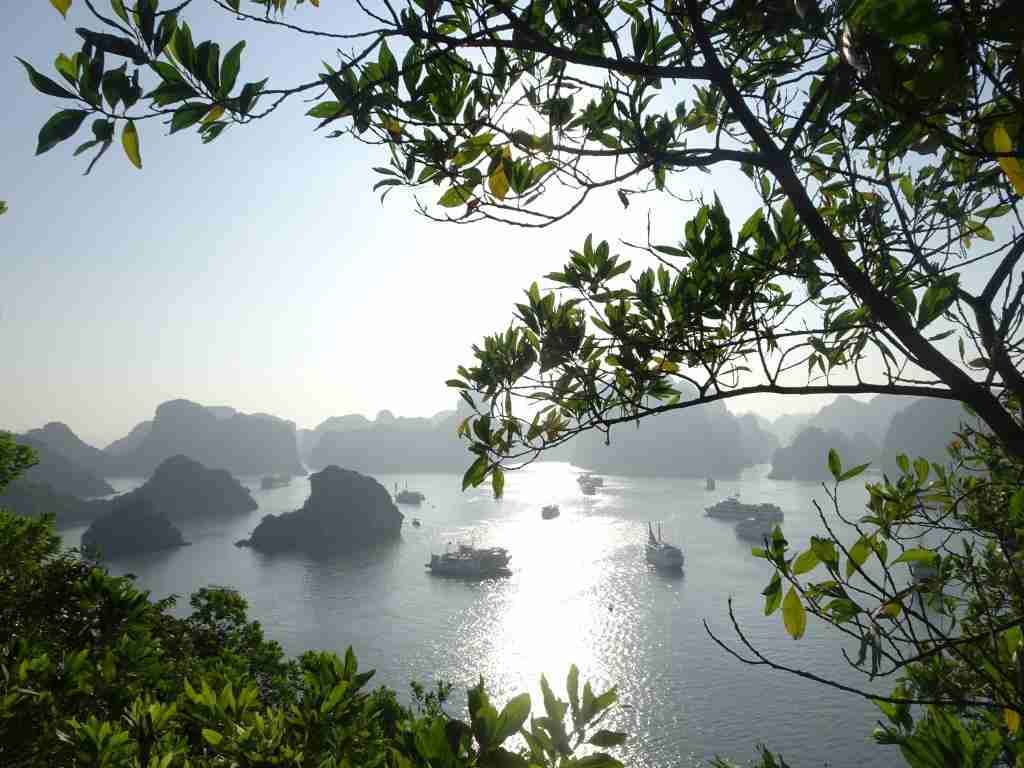
Final Thoughts -The Best and Worst Time to Visit Vietnam
The best time to visit Vietnam is during the dry season from November to April. During these months you’ll have the best chance of good weather if you plan to travel all over the country. The worst time to go to Vietnam is during the wet season from May to October when rain and storms can spoil a beach holiday and interfere with travel plans.
Although the weather can be a bit unpredictable, the shoulder season months of April to June and September to November offer cheaper prices and fewer tourists. For many people, the shoulder season is the best time to go to Vietnam.
But there’s really no bad time to go. The best time to visit Vietnam is simply whenever you can. If the weather is bad in one part of the country, it’s often quite good somewhere else. So, with a bit of flexibility, and good planning, any time is a good time to go to Vietnam.
You Might Also Enjoy
Beautiful Vietnam in 3 weeks from Top to Toe
North Vietnam in 2 weeks – A Trip You’ll Love
An Exciting 10-Day Itinerary in Vietnam’s Tropical South
20 Best Things to Do in Hoi An Vietnam
How to Visit Stunning Ha Long Bay in Vietnam
Solo Travel in Vietnam – What You Need to Know
Why You’ll Love Spectacular Phong Nha-Ke Bang in Vietnam
Is July a Good Time to Go to Bali?
Is January a Good Time to go to Bali?
Is Thailand or Bali Better for a Holiday?
Pin this post & save it for later!
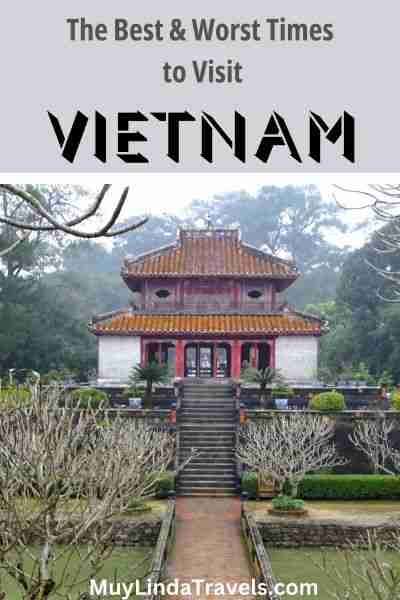
Sharing is caring!
Linda is a travel blogger and teacher from Australia. She loves to travel solo and over the years she’s visited around 50 countries on 5 different continents. Her recent trips include volunteer teaching in an orphanage in Uganda, swimming with sea turtles on the stunning islands of the Great Barrier Reef and a jaunt to Java and Bali climbing volcanos, visiting ancient sacred places and zipping around on the back of a motorbike.
Similar Posts

Visiting the Delightful Daintree Rainforest from Cairns
The Australian Daintree Rainforest is a special place, but is it possible to visit from Cairns? Is it safe and how can you get there? Well, the short answer is…

Is January a good time to go to Bali?
If you’re asking, “Is January a good time to go to Bali?” you’ll be pleased to hear that Bali is a year-round destination and that any time of year is…
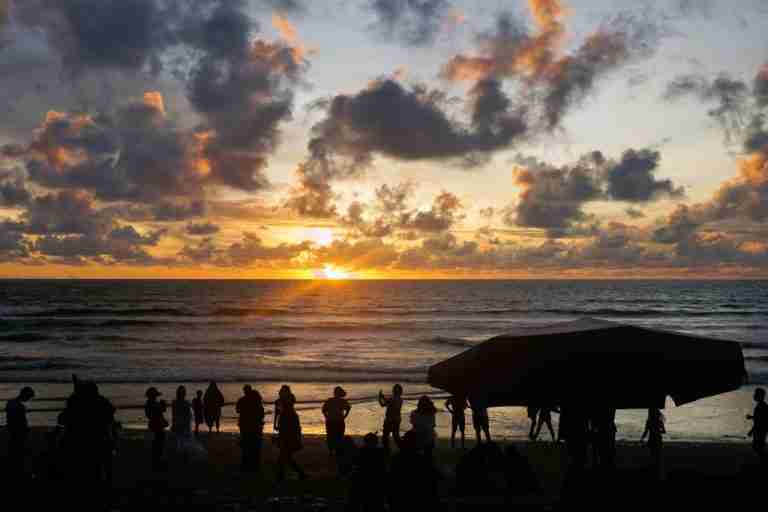
Ubud vs Kuta in Bali – Which is Best in 2024?
Ubud vs Kuta? Which is best for a holiday in Bali? If you’re trying to decide whether to stay in Ubud or Kuta then this article is for you. Both…
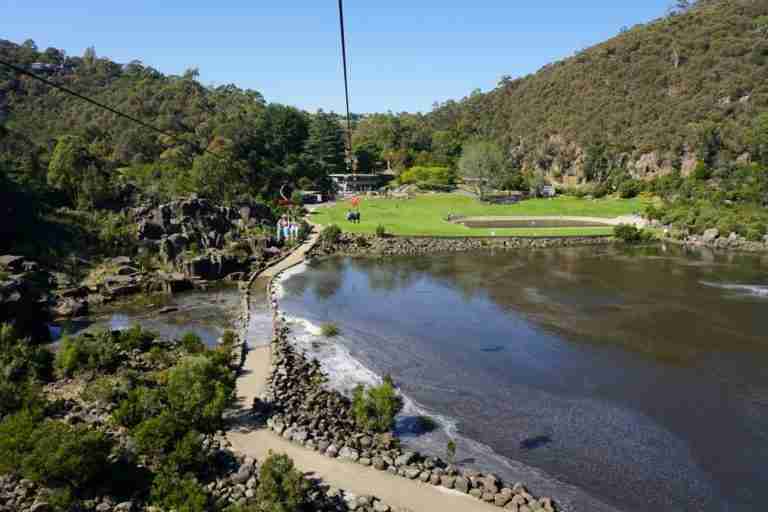
15 Things You’ll LOVE To Do In & Around Launceston in 2024
Discover the best Launceston attractions and find great things to do in Tasmania’s north-west. When you’ve explored the impressive Cataract Gorge and sampled the delicious local produce it’s time to venture further west to the UNESCO world heritage Cradle Mountain National Park, to quaint Stanley and the wilderness of the Tarkine.
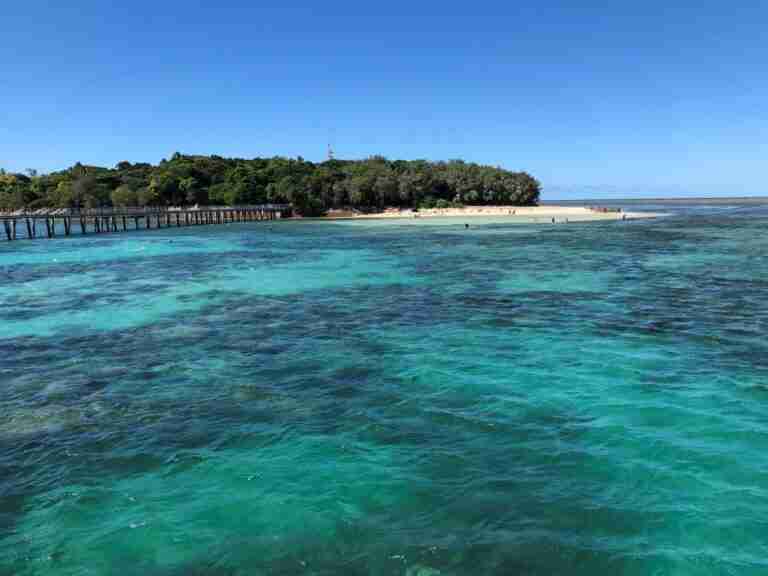
Green Island or Fitzroy Island – Which is Better?
If you’re asking “Is Green Island or Fitzroy Island better” you’ll be dreaming of a tropical island escape with gorgeous scenery, great snorkelling, and a relaxed island vibe. You can…
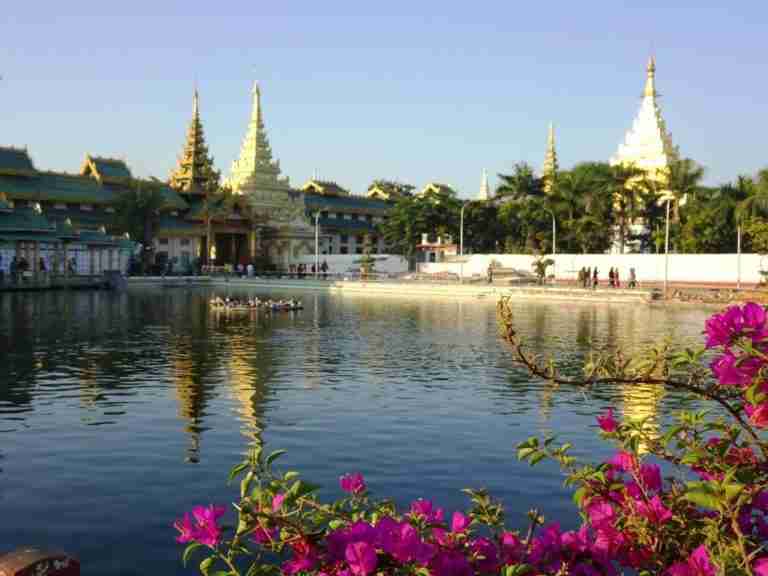
20 Amazing Temples in Myanmar – A Myanmar Temple Guide
Discover 20 beautiful Buddhist Temples in Myanmar that should not be missed from the famous Shwedagon Pagoda in Yangon to Golden Rock and the Mahamuni Paya in Mandalay. People make…
Leave a Reply Cancel reply
Your email address will not be published. Required fields are marked *
Celebrity Blog
- Choosing a Cruise
- Planning / Booking A Cruise
- Preparing For Your Cruise
- Special Occasions
- What To Expect On A Cruise
- Australia, New Zealand & the Pacific
- Central America
- East Coast & Bermuda
- Mexican Riviera
- South America & Antarctica
- Destinations
When Is the Best Time to Visit Vietnam?
By Daniel James Clarke
Last updated: December 22nd, 2022
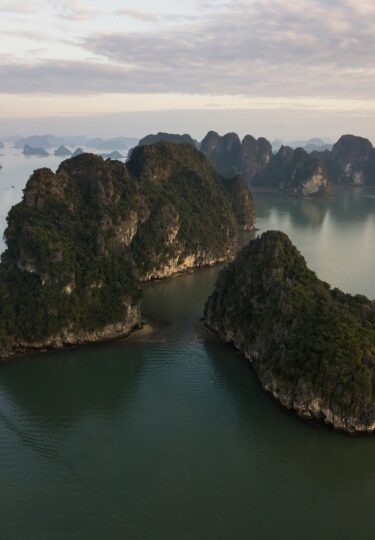
- Find a Cruise
The best time to visit Vietnam is between November and April when most of the country is experiencing its dry season. During this period, the temperatures are warm and pleasant without extreme humidity, and you’ll avoid the summer monsoon rains.
When planning for your visit, it’s essential to consider the country’s three distinct climate areas. Spanning over 1,000 miles from top to bottom, each region—north, central, and south—witnesses different periods of showers.
These latitude-defining climates lead Vietnam’s weather to usually be categorized into two seasons—dry and wet—especially in the south, which doesn’t see the more clearly defined four seasons of the north.
Visiting Vietnam By Season
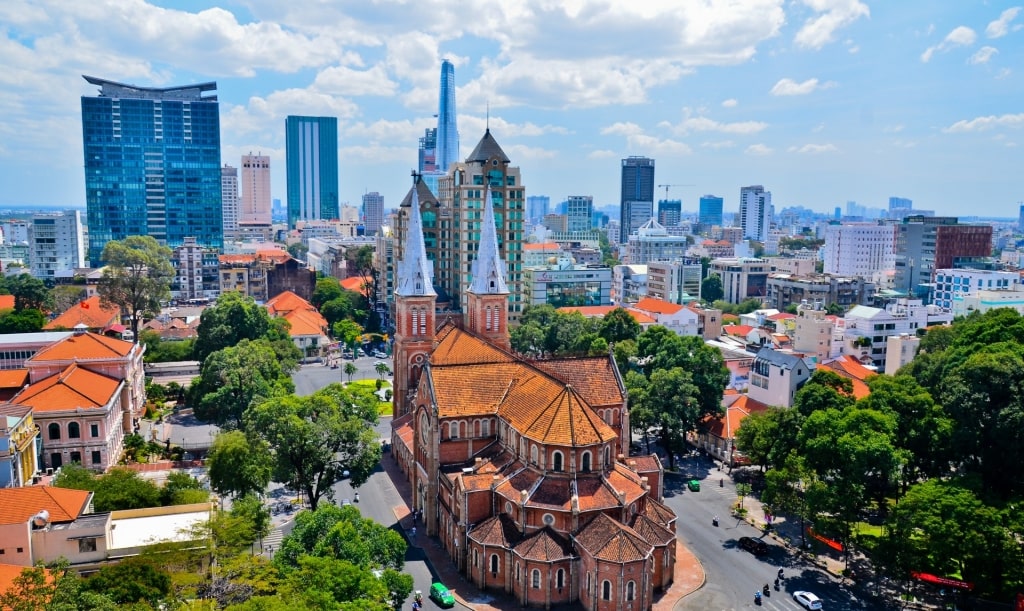
Ho Chi Minh
During Vietnam’s long, hot and humid summers—which can last from May until September—temperatures soar, hitting highs of 84°F (29°C) in Hanoi and 91°F (33°C) further south in Ho Chi Minh .
While this is an excellent time to head to the dry and sun-kissed (albeit crowded) central beaches, the rest of the country is experiencing the wet season, especially in the south where afternoon thunderstorms are common.
Fall (generally regarded as September until November) is perhaps the best time to go to Vietnam if you want to hike around Sapa, as the recently passed showers have reinvigorated the lush landscapes.
In the central and southern regions, however, the wet season is in full swing, often with typhoons in the center of the country and steamy storms in the south, where humid monsoon temperatures peak around 89°F (32°C).
Although winter, from November to January, is when the north experiences its coldest days—with temperatures peaking around 63°F (17°C) in Hanoi—the dry weather across most of the country makes it the most popular and best time to visit Vietnam for many international travelers.
In the south of the country, the dry season has also begun, and temperatures around Ho Chi Minh peak at a manageable 90°F (32°C).
In the center, the wet season continues until December, although sunnier days become much more common than showers, and typhoons aren’t a concern as in fall. With daytime temperatures of around 77°F (25°C) in Da Nang , the less harsh heat makes beach days in the central region tempting, yet without the crowds seen in summer.
Vietnam’s spring is considered to be from February until April, especially in the north of the country, where the dry weather and rising temperatures—61°F to 82°F (16°C to 28°C) in Hanoi—make for an enjoyable visit, especially to take boat trips around Hạ Long Bay.
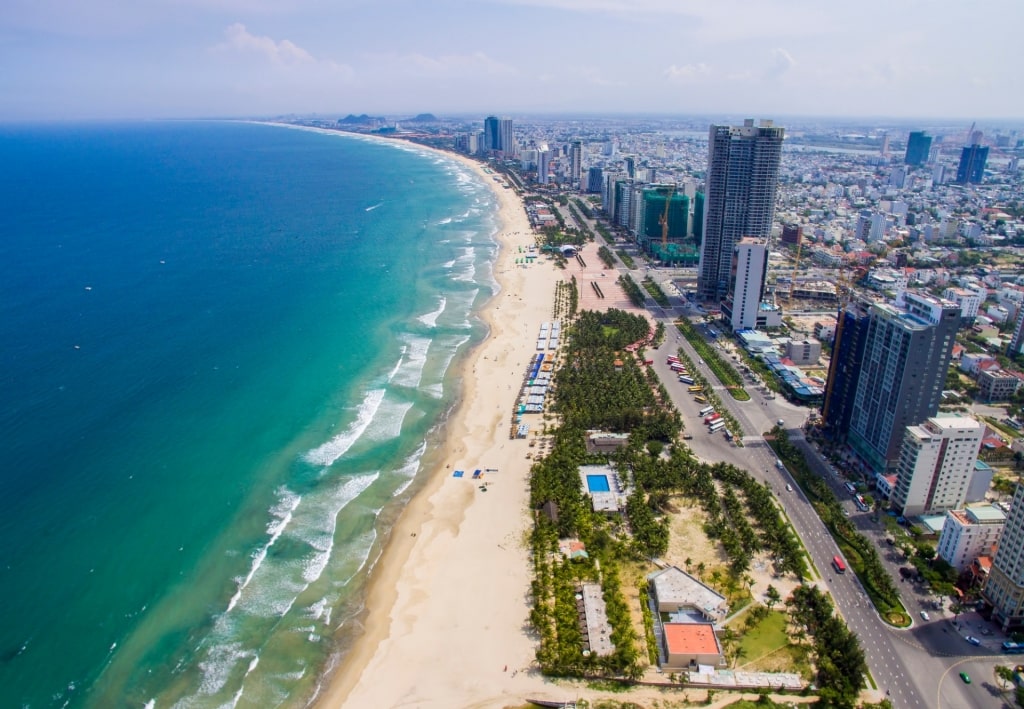
My Khe Beach, Da Nang
This is also the best time to visit Vietnam as a whole for rounded temperatures across the country, as the central region experiences its dry season with temperatures ranging between 70°F to 88°F (20°C to 31°C) in Da Nang, making beach visits far more alluring.
In the south, the dry season continues, and temperatures start to rise, ranging between 73°F to 94°F (23°C to 34°C), with April often being the hottest month of the year. After this, though, temperatures can feel just too intense, and with lower water levels on the Mekong Delta’s tributaries, the southern region is less lush and navigable by boat.
When Is Rainy Season?
Vietnam’s rainy season varies between the three regions, with showers ranging from brief and intense downpours to more extreme and extended storms, particularly at the height of the typhoon season.
In the north, the rainy months are from May until September, while the central region usually sees showers and typhoons between September and December. In the south, the monsoon period generally lasts between June and November, with dramatic afternoon thunderstorms to be expected in the first few months of the season.
When Is High Season?
Vietnam is busy year-round, especially in the densely populated urban areas. Still, there are some clearly defined high seasons for travelers during the year.
For the majority of international visitors, the most popular and best time to visit Vietnam is from November to April, when there is reliable—and not extreme—weather across the whole country.
However, many domestic tourists often vacation in what we would describe as shoulder and low season, meaning Vietnam will be busy no matter which time of year you visit.
Of particular note is Tết, the Vietnamese New Year in late January or February when everyone is on the move, and the peak central beach season in July and August. Over these two months, crowds flock to the coast to escape the extreme summer heat, leading this part of the country to have its own peak season.
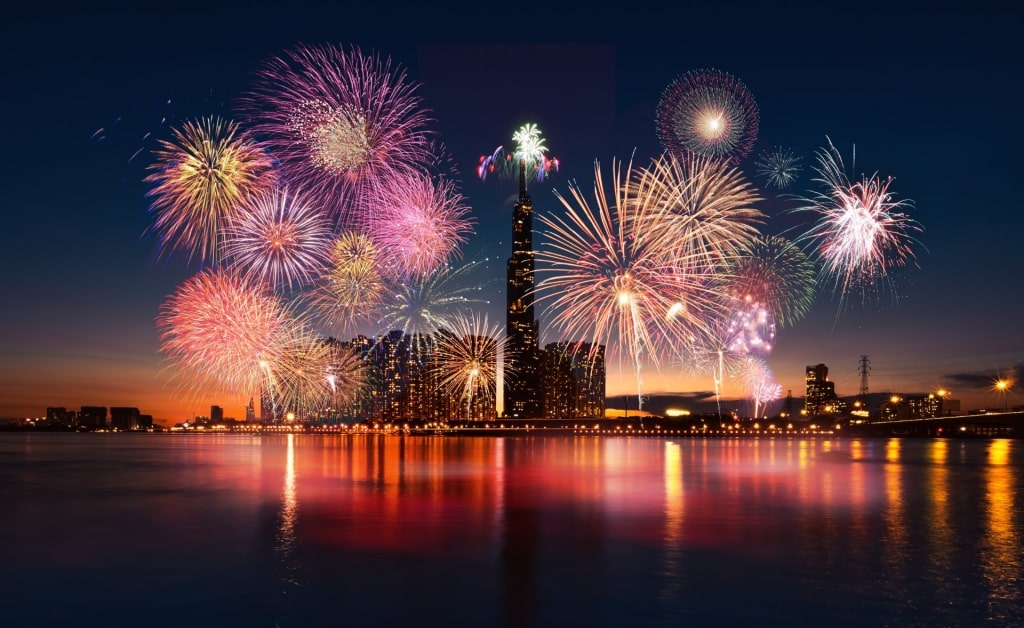
New Year’s Day in Ho Chi Minh
When Is Shoulder Season?
Shoulder season in Vietnam tends to be more of an overlap between high and low seasons, and also the balmy months of June and July.
During these two months, many travelers visit Vietnam for the beaches , which can have a spillover effect on the rest of the country’s main sights. With domestic travel very popular during either side of the international peak season, the most famous attractions remain busy regardless.
When Is Low Season?
Vietnam’s low season, especially for international visitors, is between late April and June and September to early November.
The hot, humid, and stormy weather in the south and the fall typhoon season in the central region is not conducive to sightseeing and activities, unless you’re an avid hiker, in which case you may find this is the best time to visit Vietnam for trekking in the northern mountains.
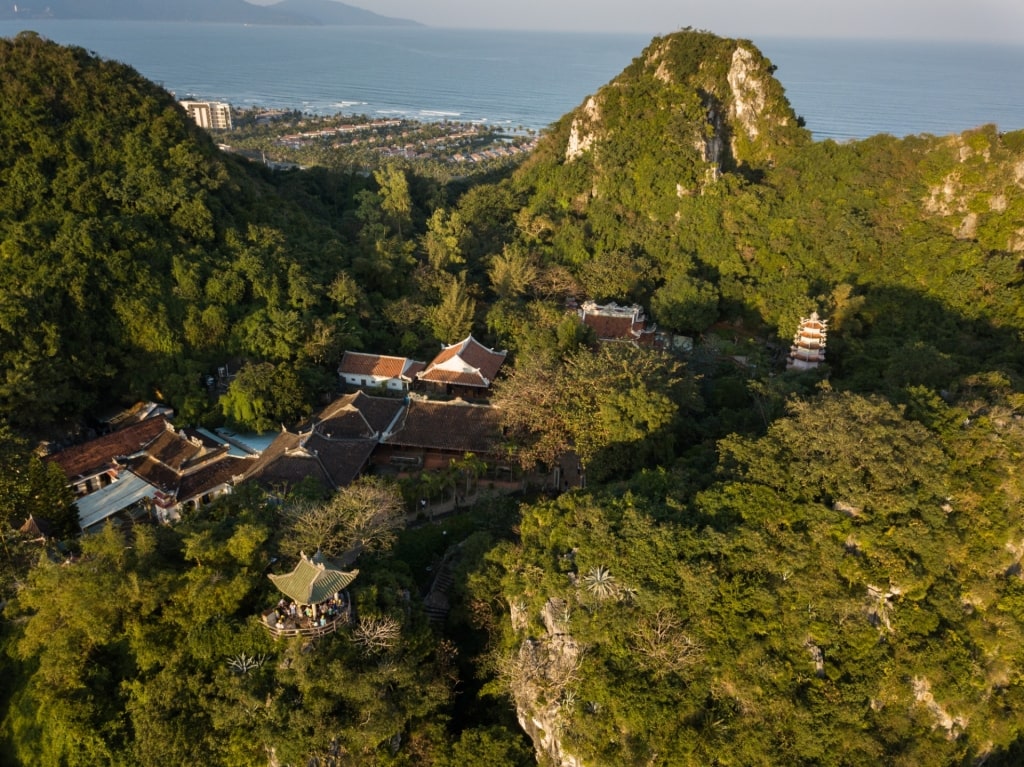
Marble Mountains, Hoi An
Eager to explore all of Vietnam’s dynamic cities and dreamy landscapes? Browse Celebrity’s luxury cruises to Vietnam to find your perfect vacation.
Daniel James Clarke
Daniel James Clarke is a British-born travel writer and photographer, now calling Portugal home—and yes, eating far too many pastéis de nata . His writing has appeared in publications including Lonely Planet and The Times, and he is happiest exploring a new destination, from indulgent local restaurants to scuba diving adventures.
Related Itineraries
Vietnam & Thailand
- 11 nights ON CELEBRITY SOLSTICE
- DEPARTING FROM HONG KONG, CHINA
- Starting from $1073 USD
Thailand & Vietnam
- 12 nights ON CELEBRITY SOLSTICE
- DEPARTING FROM SINGAPORE, SINGAPORE
- Starting from $1262 USD
- Starting from $1294 USD
Thailand & Vietnam Holiday
- Starting from $1984 USD
- Starting from $2072 USD
- Starting from $13004 USD
Related Articles
14 Best Places to Visit in Asia
14 Best Things to Do in Colombo
18 Best Things to Eat in Kyoto
26 Beautiful Places in Japan
12 Best Beaches in Japan
12 Stunning Islands in Asia to Visit
12 Best Things to Do in Anchorage, Alaska
The 10 Best Places to Go Snorkeling in Curaçao
7 Best Countries in South America to Visit
When Is the Best Time to Visit the Caribbean?
Gdansk’s Old Town: Best Things to See & Do
The Best Time to Cruise Alaska
Free Vacation Planning Services

CALL US 888-751-7804
Sign Up for Special Offers
- First Name *
- Last Name *
- Email Address *
- Country * Country Afghanistan Albania Algeria American Samoa Andorra Angola Antigua and Barbuda Argentina Armenia Australia Austria Azerbaijan Bahamas Bahrain Bangladesh Barbados Belarus Belgium Belize Benin Bermuda Bhutan Bolivia Bosnia and Herzegovina Botswana Brazil Brunei Bulgaria Burkina Faso Burundi Cambodia Cameroon Canada Cape Verde Cayman Islands Central African Republic Chad Chile China Colombia Comoros Congo, Democratic Republic of the Congo, Republic of the Costa Rica Côte d'Ivoire Croatia Cuba Curaçao Cyprus Czech Republic Denmark Djibouti Dominica Dominican Republic East Timor Ecuador Egypt El Salvador Equatorial Guinea Eritrea Estonia Ethiopia Faroe Islands Fiji Finland France French Polynesia Gabon Gambia Georgia Germany Ghana Greece Greenland Grenada Guam Guatemala Guinea Guinea-Bissau Guyana Haiti Honduras Hong Kong Hungary Iceland India Indonesia Iran Iraq Ireland Israel Italy Jamaica Japan Jordan Kazakhstan Kenya Kiribati North Korea South Korea Kosovo Kuwait Kyrgyzstan Laos Latvia Lebanon Lesotho Liberia Libya Liechtenstein Lithuania Luxembourg Macedonia Madagascar Malawi Malaysia Maldives Mali Malta Marshall Islands Mauritania Mauritius Mexico Micronesia Moldova Monaco Mongolia Montenegro Morocco Mozambique Myanmar Namibia Nauru Nepal Netherlands New Zealand Nicaragua Niger Nigeria Northern Mariana Islands Norway Oman Pakistan Palau Palestine, State of Panama Papua New Guinea Paraguay Peru Philippines Poland Portugal Puerto Rico Qatar Romania Russia Rwanda Saint Kitts and Nevis Saint Lucia Saint Vincent and the Grenadines Samoa San Marino Sao Tome and Principe Saudi Arabia Senegal Serbia Seychelles Sierra Leone Singapore Sint Maarten Slovakia Slovenia Solomon Islands Somalia South Africa Spain Sri Lanka Sudan Sudan, South Suriname Swaziland Sweden Switzerland Syria Taiwan Tajikistan Tanzania Thailand Togo Tonga Trinidad and Tobago Tunisia Turkey Turkmenistan Tuvalu Uganda Ukraine United Arab Emirates United Kingdom United States Uruguay Uzbekistan Vanuatu Vatican City Venezuela Vietnam Virgin Islands, British Virgin Islands, U.S. Yemen Zambia Zimbabwe

STAY IN THE KNOW
Thank you for subscribing.
See you on board soon.

- 2 Weeks for Couple
- 2 Weeks for Family
- Thailand Lantern Festival
- Indonesia(Bali)
- South Korea
- China (HK, Taiwan)
- Itinerary Ideas
- Asia Highlights Travel Reviews
- Thailand Travel Reviews
- Vietnam Travel Reviews
- Cambodia Travel Reviews
- Japan Travel Reviews
- Myanmar Travel Reviews
- China Travel Reviews

Best (and Worst) Times to Visit Vietnam and Cambodia 2024
Vietnam and Cambodia are a popular combo for first Southeast Asia trips, known for Ha Long Bay, Hoi An, the Mekong Delta, and Angkor Wat, as well as their large cities and several other attractions.
Bordering each other, they share similar climate patterns: a dry season (November to April) and rainy season (May to October). Weather-wise, the dry season from November to April is undoubtedly the best time with most sunny days and cool/warm weather.
Best Weather Times for Vietnam and Cambodia
Best times for a family trip to vietnam and cambodia, the worst and cheapest times to visit vietnam and cambodia.
- Monthly Weather in Vietnam and Cambodia
For most of Vietnam and Cambodia, November to April is the best time with mostly dry and clear days. The dry season is divided into the cool season (November to February) and the hot season (March to April).
If you're sensitive to heat, you're suggested to take your trip during November–February for cool/mild temperatures.
While temperatures rise to 30+°C (86+°F) in the hot season, beach vacations and Mekong River and Halong Bay cruises are more pleasant. If you travel with us , we'll keep you refreshed and beating the heat with cold drinks from our cool box and private, air-conditioned transport for your daily private touring.
Read more ideas about planning your trip to Vietnam and Cambodia >>>
Best Times Outside the Dry Season
If your available time is outside November-to-April, you could still discover some cities of Vietnam and Cambodia with comfortable or non-rain-affected experiences.
Home to Angkor Wat, Cambodia never loses its charm even in the height of the rainy season (June to October). If possible, visit in May or late October for less rainfall.
Owing to Vietnam's elongated shape, its best times differ regionally:
- Southern Vietnam (Ho Chi Minh City, Phu Quoc Island, and the Mekong Delta) : Although November to April is its best time, Mekong River cruises are still good options in the rainy season.
- Central Vietnam (Hoi An, Hue, and Danang) : With its unusual short, sharp, September–December wet season, you could enjoy mostly dry weather from January through to August , which makes it ideal for summer-holiday family trips.
- Northern Vietnam (Ha Long Bay, Sapa, and Hanoi) : You would have warm/mild weather from October to April. October is a good month to discover Hanoi and Sapa, with only-moderate rainfall and warm temperatures.
Check the well-selected itineraries for 2 weeks in Vietnam and Cambodia >>>
When planning a family trip to Vietnam and Cambodia, December and January are the best time for mild/warm, dry weather and atmospheric Christmas and New Year celebrations . But with those benefits come the highest crowds and costs. So, ideally, prepare for it at least 3 months in advance to secure the best deals. More ideas on Planning a Family Holiday to Southeast Asia? 20 Expert Tips for Christmas >>>
For a summer getaway, June is a better time to go . Lower rainfall and smaller crowds are rewards compared with July and August. More ideas on how to plan a multi-generational family trip to Southeast Asia or how to plan a family trip to Southeast Asia >>>
Weather-wise, the rainy season (May to October) is seen as the worst time to travel around Vietnam and Cambodia. However, you could enjoy 30–50% savings during this cheapest time.
If crowds particularly bother you, then the peak season (November to April) may actually be the worst time for you, especially around the Christmas and New Year holidays. A well-organized private tour could help to avoid many crowded situations though.
An insider's tip: Travelling just before/after the high season (in May or late October) is advisable as a compromise for lower costs, smaller crowds, and lighter rainfall.
Discover real reviews of Highlights Travel Family 's best-rated service across trusted platforms.
The Rainy Season in Vietnam and Cambodia
The rainy season arrives between May and October in most of Vietnam and Cambodia. The heaviest rainfall hits most areas between July and August, except for central Vietnam (with September–November peak rainfall).
During the rainy season, you might encounter typhoons, which appear more frequently around September and October in central and northern Vietnam. Your Halong Bay cruise might be canceled if a typhoon crosses the bay.
Be aware that the rainy season doesn't mean floods, storms, and consistent rainfall all the time. Instead, most rainfall comes as short afternoon downpours and rarely lasts the whole day. Thus, dry daytrips are still possible if you're flexible and well-prepared, and you would be rewarded with the lowest costs and crowding during this cheapest time to travel around Vietnam and Cambodia.
Find Your Best Month to Visit Vietnam and Cambodia...
January weather in vietnam and cambodia.
- Northern Vietnam (Hanoi, Halong Bay, Sapa): 12°C to 20°C (54°F to 68°F), dry
- Central Vietnam (Hoi An, Hue, Danang): 20°C to 24°C (68°F to 75°F), low rainfall
- Southern Vietnam (Ho Chi Minh City, Mekong Delta, Phu Quoc) and Cambodia: 26°C to 32°C (79°F to 90°F), dry
January is one of the best months to discover all the iconic attractions in Vietnam and Cambodia, with low rainfall and warm/cool temperatures.
Travelling in January, you're suggested to prepare at least 6 months in advance, particularly for New Year holidays. For family trips, early booking is better to avoid skyrocketing prices and to ensure booking family rooms.
Vietnam's New Year (Tet festival) occurs in late January or early February (Jan. 25 in 2024), limiting sightseeing, shopping, and dining access. Big cities like Hanoi and Ho Chi Minh remain visit-worthy, but the Mekong Delta closes for Tet's initial four days. Contact us for expert tips inside a customized private tour.
February Weather in Vietnam and Cambodia
- Northern Vietnam (Hanoi, Halong Bay, Sapa): 13°C to 21°C (55°F to 70°F), dry
- Central Vietnam (Hoi An, Hue, Danang): 20°C to 25°C (68°F to 77°F), dry
- Southern Vietnam (Ho Chi Minh City, Mekong Delta, Phu Quoc) and Cambodia: 26°C to 33°C (79°F to 91°F), very dry
Throughout Vietnam and Cambodia, the best weather continues in February with drier and warmer weather than in January. Your trip shouldn't be affected by the weather, no matter whether you visit the iconic highlights or somewhere off-the-beaten-path.
Similar to January, you should expect larger crowds and costs in February. Early booking, ideally 6 months in advance, is the key to securing your best deals.
Read more about planning a couple's trip to Southeast Asia >>>
March Weather in Vietnam and Cambodia
- Northern Vietnam (Hanoi, Halong Bay, Sapa): 16°C to 23°C (61°F to 73°F), dry
- Central Vietnam (Hoi An, Hue, Danang): 21°C to 27°C (70°F to 81°F), dry
- Southern Vietnam (Ho Chi Minh City, Mekong Delta, Phu Quoc) and Cambodia: 27°C to 34°C (81°F to 93°F), dry
The weather remains dry in March, and temperatures increase. If you're looking for cooler weather, northern and central Vietnam are ideal places to go. Meanwhile, the hot-season weather makes southern Vietnam and Cambodia less crowded.
As March is still the high season, high costs prevail, and long queues are the daily routine . So, a private tour is recommended to help navigate the quieter routes, avoiding crowds, and to make your trip time-smart for a comfortable experience.
April Weather in Vietnam and Cambodia
- Northern Vietnam (Hanoi, Halong Bay, Sapa): 22°C to 27°C (72°F to 81°F), moderate rainfall
- Central Vietnam (Hoi An, Hue, Danang): 23°C to 29°C (73°F to 84°F), low rainfall
- Southern Vietnam (Ho Chi Minh City, Mekong Delta, Phu Quoc) and Cambodia: 28°C to 34°C (82°F to 93°F), low rainfall
Except for in northern Vietnam, where there is a bit more rain than in other areas of Vietnam and Cambodia, April temperatures usually get as hot as 30°C (86°F) or so. But crowds tend to be smaller.
In April, northern Vietnam is a comfortably warm paradise for outdoor adventures, such as hiking in Sapa, biking in Ninh Binh, and kayaking/cruising in Halong Bay.
For a romantic milestone trip , our well-selected small-boat Mekong cruise allows more private time for you, as it has only 12 rooms in total. For life-long memories, you deserve a special sunset balloon ride or helicopter tour over Angkor Wat .
May Weather in Vietnam and Cambodia
- Northern Vietnam (Hanoi, Halong Bay, Sapa): 23°C to 31°C (73°F to 88°F), moderate rainfall
- Central Vietnam (Hoi An, Hue, Danang): 25°C to 32°C (77°F to 90°F), low rainfall
- Southern Vietnam (Ho Chi Minh City, Mekong Delta, Phu Quoc) and Cambodia: 27°C to 34°C (81°F to 93°F), high rainfall
May is a transitional month from dry to wet season in most of Vietnam and Cambodia. Throughout both countries, the daily high temperature averages above 31°C (88°F). Outdoor activities are better scheduled in the early morning and late afternoon for cooler weather.
For drier experiences, you should expect less rainfall in early May than in late May. Central Vietnam is a dry option as well, where the scenery along the DMZ (Hue south via Hai Van Pass to Phan Thiet) never disappoints.
Learn how to travel from Vietnam to Cambodia >>>
June Weather in Vietnam and Cambodia
- Average temperature range in Cambodia and Vietnam: 26°C to 34°C (79°F to 93°F);
- high rainfall in all but low-rainfall central Vietnam (Hoi An, Hue, Danang)
In June, most of Vietnam and Cambodia begin its hot and humid rainy season. You might encounter short intense downpours. However, central Vietnam is still in the "rain shadow".
Due to the heat and rainfall, you'd probably have the attractions mostly to yourselves, which is a particularly nice change at the iconic ones, and you'd enjoy big discounts. For families with school children, June is a better time to take a summer holiday if you can, before the local summer holiday arrives in wetter July and August.
See the itinerary ideas about 2 weeks in Southeast Asia for family trips>>>
July Weather in Vietnam and Cambodia
- Average temperature range in Cambodia and Vietnam: 26°C to 35°C (79°F to 95°F);
- high rainfall in all but low-rainfall central Vietnam
In July, rainfall becomes more frequent and heavier. Keeping your itinerary flexible is necessary to make the best of the weather. As we're experienced in dealing with such conditions, we always prepare a plan B for you when travelling with us .
Your trip would be less affected if you spent time in central Vietnam (Hoi An, Hue, Danang), and the Mekong River cruise is a good option all year round. But book your trip at least 3 months in advance, since local (and other nations') summer holidays start in July.
August Weather in Vietnam and Cambodia
- high rainfall in all but central Vietnam, where it's only moderate
The heaviest rain arrives in August in northern and southern Vietnam, and Cambodia. Central Vietnam is the best option then, with various cultural experiences in Hoi An and abundant beach activities in Danang.
In Cambodia, you'll have green and lush scenery at the height of the wet season, and you'll never need to fight for the best photo spots at Angkor Wat.
Road travel can sometimes be impacted by flooding in August. As locals, our private drivers and guides always get the latest news and deal with it professionally, helping you have the best tour possible in such circumstances. Start planning your trip with our professional consultant >>>
September Weather in Vietnam and Cambodia
- Average temperature in Cambodia and Vietnam: 24°C to 31°C (75°F to 88°F); high rainfall throughout
In September, rainfall and temperature continue high in northern and southern Vietnam, while central Vietnam's rainy season begins. Cambodia suffers its rainiest month. Travelling in September definitely requires more flexibility.
Typhoons or heavy rains are likely to affect coastal trips to Phu Quoc, Da Nang, and Nha Trang this month . If you are a beach lover, you're suggested to visit drier Koh Samui in Thailand , or Bali in Indonesia instead.
October Weather in Vietnam and Cambodia
- Northern and central Vietnam: 22°C to 28°C (72°F to 82°F); low rainfall in the north; extremely high rainfall in the central region
- Cambodia and southern Vietnam: 25°C to 31°C (77°F to 88°F); high rainfall to low late in the month
October is the tail end of the rainy season in most of Vietnam and Cambodia. The temperature cools towards comfortable levels too. So, October is a good month to visit Vietnam and Cambodia, especially towards November.
The only exception is central Vietnam (Hoi An, Hue, Danang), which is suffers its extreme peak of the rainy season (September to November). You are likely to have persistent stormy days there, so be flexible and take advantage of indoor activities, like cooking classes, lantern-making classes, and making ao dai (Vietnamese national costumes) .
November Weather in Vietnam and Cambodia
- Northern Vietnam (Hanoi, Halong Bay, Sapa): 17°C to 24°C (63°F to 75°F); low rainfall
- Central Vietnam (Hoi An, Hue, Danang): 20°C to 25°C (68°F to 77°F), very high rainfall
- Southern Vietnam (Ho Chi Minh City, Mekong Delta, Phu Quoc) and Cambodia: 24°C to 30°C (75°F to 86°F); moderate rainfall
The best months to visit Vietnam and Cambodia begin again in November. The rainy season in central Vietnam continues torrentially, though.
You'll have more sunny days and cooler weather, which is great news, no matter whether you want a romantic sunset tour over Angkor Wat or to enjoy your family time on the beaches.
With the inevitable increase in crowds coming, you could enjoy a quieter time in early November.
December Weather in Vietnam and Cambodia
- Northern Vietnam (Hanoi, Halong Bay, Sapa): 14°C to 21°C (57°F to 70°F); dry
- Central Vietnam (Hoi An, Hue, Danang): 19°C to 24°C (66°F to 75°F); high rainfall
- Southern Vietnam (Ho Chi Minh City, Mekong Delta, Phu Quoc) and Cambodia: 23°C to 29°C (73°F to 84°F); low rainfall
As one of the best months, most of Vietnam and Cambodia is warm/mild in December. If you're looking to escape the cold in your hometown, Vietnam and Cambodia are good options in December. Even central Vietnam's rains finally slacken off in late December, as the whole region enters the dry season.
Being the peak season, making reservations 6 months in advance is the way to get better prices and ensure availability , especially around Christmas.
For more weather details in Southeast Asia, check in Southeast Asia Weather in December >>>
Visit Vietnam and Cambodia with Us
We once created over 10,000+ big trips, mostly for families and couples. So we specialize in creating bespoke milestone trips, whether it's your 25-year anniversary, 60-year birthday, or retirement...
Simply sit back and use our Create My Trip service. Your expert will contact you with a personalized private tour within 24 hours! Take inspiration from the following hand-picked private tours:
- 12-Day Cambodia and Vietnam Highlights
- 12-Day Essential Thailand, Cambodia, and Vietnam Tour
- 15-Day Best of Thailand, Cambodia, and Vietnam Tour
- 19-Day Highlights of Thailand, Cambodia, and Vietnam
Why Asia Highlights (10,000+ reviews & 98.8% 5-star rating)
- Save Your Time:
- Less research, more enjoyment!
- Real-time 1V1 expert planning
- Maximize Your Flexibility:
- Personal local guide and ride
- Explore at your own pace
- Celebrate Your Journeys:
- Specially-crafted family adventures
- Celebrate milestones with style!
- 19-Day Highlights Tour of Southeast Asia: Thailand, Cambodia, and Vietnam
- 14-Day Classic Vietnam and Thailand Tour
- 12-Day Best of Thailand and Cambodia Tour
- How to Visit Thailand, Cambodia, and Vietnam 2024: 10, 14 and 21-Day Itinerary Ideas
- How to Plan a 2024 Trip to Southeast Asia With Itinerary & Cost
- 2 Weeks in Southeast Asia: Top 6 Itineraries for 2024/2025
- Southeast Asia Itinerary for 3 Weeks: Best 5 Ideas in 2024
- Southeast Asia Weather in January, Where to Go
- Southeast Asia Weather in February, Where to Go
- Southeast Asia Weather in March 2024, Where to Go
- Southeast Asia Weather in April 2024, Where to Go
- Southeast Asia Weather in May 2024, Where to Go
- Southeast Asia Weather in June 2024, Where to Go
- The 6 Best Places to Visit in Southeast Asia in July (2024)
- The 6 Best Places to Visit in Southeast Asia in August 2024
- Southeast Asia Weather in November 2024, Where to Go
- Southeast Asia Weather in December 2024 & Best Places to Go
Get Inspired with Some Popular Itineraries
At Asia Highlights, we create your kind of journey — your dates, your destinations, at your pace. You can have any trip tailor made for your travel.
More Travel Ideas and Inspiration
Sign up to our newsletter.
Be the first to receive exciting updates, exclusive promotions, and valuable travel tips from our team of experts.
Why Asia Highlights
Where can we take you today.
- Middle East
- African Safari
- Travel Agents
- Our Differences
- Privacy Policy
Address: Building 6, Chuangyi Business Park, 70 Qilidian Road, Guilin, Guangxi, 541004, China
2044 solar eclipse path: See where in US totality hits in next eclipse
Compared to this year's eclipse, with a path of totality that will cross over 13 states, the 2044 total solar eclipse won't have as quite as broad of a reach. here's what to know:.

Millions of Americans are by now eagerly awaiting the next total solar eclipse , which is only hours away from passing over a large swath of the continent .
But when the celestial event comes and goes, the awe-inspiring impression it leaves on skygazers may leave them with one question: "When can we see that again?"
Unfortunately, we'll have to wait awhile – this sort of spectacular astral phenomenon doesn't happen very often . Here's what we know about the next total solar eclipse that will cross over the contiguous U.S.
Solar eclipse glasses: What to know about glasses, safe viewing before the solar eclipse
When will the next total solar eclipse happen in the U.S?
Only seven years have passed since Americans had the opportunity to view a total solar eclipse, a relatively rare celestial event in which the moon appears to us here on Earth to completely block the sun.
The resulting fleeting moments of darkness can last for minutes or just mere seconds and is known as " totality ," whereby the sun's outermost layer known as the corona makes a rare appearance.
Today's total solar eclipse , the first in North America since 2017, will travel over portions of northern Mexico, thousands of miles of the U.S. and the maritime provinces of Canada, according to NASA . According to astronomers, this eclipse will be brighter, will last longer and will be visible to more people than the last one in North America.
It's also the last one for 20 years in the United States.
After Monday, the next total solar eclipse viewable from the lower 48 states will be on Aug. 23, 2044.
2044 total solar eclipse path of totality
Compared to this year's eclipse, with a path of totality that will cross over 13 states, the 2044 total solar eclipse won't have as quite as broad of a reach .
The Planetary Society, a nonprofit involved in research, public outreach and political space advocacy, says that during the 2044 eclipse, the path of totality will only touch three states.
The eclipse will begin in Greenland, sweep through Canada and end around sunset in Montana, North Dakota and South Dakota.
It's not too early to start thinking about where you want to witness it. According to whenisthenexteclipse.com , Americans may want to make sure their passports up to date.
The place to be will likely be Banff National Park in Alberta and Jasper National Park , with Calgary and Edmonton also within the path of totality.
What to know about the 2033 eclipse in Alaska
Outside of the "lower 48," Alaska is set to experience a total solar eclipse much sooner.
On March 30, 2033, a total solar eclipse will occur in Russia and cross over Alaska, according to nationaleclipse.com . The maximum duration of totality for this eclipse will be 2 minutes and 37 seconds.
Contributing: Mary Walrath-Holdridge and Gabe Hauari
Eric Lagatta covers breaking and trending news for USA TODAY. Reach him at [email protected]
When is the best time to visit Vietnam?

The best time to visit Vietnam is from March to April when rainfall is low and temperatures are milder.
In a country more than 1,600 km long, the weather in Vietnam varies considerably as you go from north to south, from a temperate to a tropical climate. While this variety makes Vietnam a year-round destination, spring (March to April) is typically the best time to visit the entire country, when days are generally pleasant, temperatures are moderate and rainfall is light. Tropical monsoons bring heavy rains and occasional flooding during other parts of the year, while extreme temperatures can make summer days uncomfortably hot and sticky.
Here is our guide for the best time to visit different regions of Vietnam.
The north of Vietnam experiences cold dry winters from December to February, where overnight temperatures can dip to 4°C. The summer months (May to August) are typically very hot and humid. The best time to visit northern Vietnam is during spring (March to April) and autumn (September to November), when days are generally warm and sunny.
The coast of central Vietnam is often battered with typhoons during its wet season. It’s difficult to predict when these heavy rains and hurricane-like winds can hit coastal cities like Hoi An, but generally typhoon seasons runs from August to November. The rainy season usually subsides in February, when you can expect warmer temperatures and more sunshine. While travellers will experience pleasant weather in Central Vietnam any time between February and August, sunny 30°C days are the norm in July and August.
South Vietnam experiences warm, pleasant temperatures year-round, making travel good at any time. The dry season generally runs from December to May and the rainy season runs from June through November. While flooding can occur, rain usually comes in short bursts and rarely impacts travel. In fact, the monsoon season is often the best time for photography as dramatic thunderheads float across the Mekong Delta and rice fields turn a vibrant emerald green. Some, however, might find temperatures unbearable from March to May, when the mercury regularly reaches 40°C.
Best for: exploring Hoi An’s Old Town, swimming and other water-based activities.
While it might be winter, January is considered one of the best times to visit Vietnam as the country experiences warm, sunny and relatively dry weather. Temperatures and weather patterns can differ slightly depending on your location in the north, south or central part of Vietnam but, on average, you can expect highs of around 25°C and low humidity levels.
The atmosphere is also likely to be festive thanks to various Luna New Year (Tet) celebrations happening around the country, so make sure you get involved as much as you can. Popular destinations to visit during January include Hoi An and the southern islands of Phu Quoc and Con Dao for some much-needed beach time.
Best for: bar hopping in Ho Chi Minh City, Mekong Delta day trips and lounging at rooftop pools.
Weather patterns are generally at their best in February, meaning mostly dry and sunny days with temperatures at an average of 23°C. Central and south Vietnam tend to be warmer than the north, so if you’re after a beach holiday, head to the southern islands for ultimate relaxation or to Ho Chi Minh City if you want those rooftop pool vibes.
February is also likely to be busy with Luna New Year (Tet) festivities ongoing, but you can escape all the hustle and bustle on a day trip to the Mekong Delta, where water levels are high enough to see the floating markets in all of their glory.
Best for: exploring national parks, rainforest walks and dining on Vietnamese cuisine.
Temperatures in March are on the rise, especially in central and southern Vietnam, where highs can get to a sweat-inducing 29°C+. Northern Vietnam is still relatively cool with plenty of sunshine during the month, so you can get outside and start exploring some of this country’s beautiful national parks and rainforest areas. There’s also never a bad time to try Vietnamese cuisine, but March is one of the best months for growing star fruit and rambutan, so make sure to taste these sweet snacks during your trip.
Best for: Hue Festival celebrations, learning about ancient traditions and temple visits.
April is still firmly entrenched in Vietnam’s ‘best time to visit’ season and enjoys warm but comfortable temperatures; however, a transitional period (weather-wise) is just around the corner, so expect an increase in rainfall and humidity levels, especially in the south.
The peak season crowds are also starting to thin out in April, so it’s a good time to visit popular temples such as Tran Quoc Pagoda in Hanoi and Thien Mu Pagoda in Hue.
Best for: pottery village visits, exploring historical buildings and wandering through markets.
While May is technically the first month of the wet season, it still remains a popular time to visit Vietnam because of its generally favourable weather. However, you can expect different weather patterns depending on your location due to the varying climates. Rainfall is starting to increase in the northern regions, such as Hanoi and the Sapa Valley, while central Vietnam retains temperatures of around 30°C and enjoys blue skies and relatively dry days.
Best for: museum visits, cycling and trips to Con Dao National Park.
While it boasts the title of ‘hottest month in Vietnam’, June is still a relatively good month to visit the central regions of the country with sunny days that are perfect for cycling and relaxing on the beaches in Danang and Nha Trang. The same can’t be said for the south, where downpours are now a daily occurrence. The slight positive, if you’re visiting Ho Chi Minh City and Can Tho in June, is that while these daily showers are heavy, they’re often short-lived and occur in the afternoon, giving you plenty of time to wander outside in the mornings.
While it’s raining, you might want to spend your time in some of the fascinating museums in Ho Chi Minh City, such as the War Remnants Museum and the Reunification Palace or do some serious shopping while you wait for the rain to ease up. June also marks the start of Green Turtle nesting season on the beaches of Con Dao Island. If you’re in the vicinity, visiting Con Dao National Park to hear about their conservation program will add another layer of awesomeness to your trip.
Best for: beach days, diving and checking out UNESCO World-Heritage-listed sites.
July is considered to be in the middle of the low season in Vietnam, so popular destinations like Ho Chi Minh City and Hanoi are less crowded and accommodation is generally cheaper. However, the weather varies a lot from region to region, so you must plan accordingly to avoid disappointment or disruption to your travel plans.
Central Vietnam’s weather patterns remain relatively the same as in previous months, so spending time in Hue and Hoi An are good options if you’re into plenty of sunshine and rain-free days. The northern regions, such as Halong Bay and Sapa, experience hot, stormy weather with temperatures reaching 30°C+ most days, while the south is still firmly in its wet season, so a mix of rainy days and sunny weather is the norm.
Best for: watching baby Green Turtles hatch, learning how to cook Vietnamese food and beach lounging.
If you’re set on trekking through the mountainous regions of northern Vietnam, then August isn’t the month to travel in, but if you’re more interested in lounging out on beaches in Hoi An and Danang, then start blocking out the dates in your calendar – you’re good to go.
Yes, temperatures in central Vietnam can reach beyond 30°C+, but short bursts of rain are common (especially towards the end of the month), and they’ll give you a slight reprieve from the heat. Watching baby Green Turtles hatch should also be on the agenda if you’re visiting Con Dao Island as they start their slow but adorable journey to the sea from mid-August onwards.
Best for: Mid-Autum Festival celebrations, trips to Hoan Kiem Lake and exploring the Mu Cang Chai valley.
September sees both the northern and southern regions emerge from their hot and humid seasons while central Vietnam enters its monsoonal era – think torrential downpours and flooding in places such as Hoi An and the caves of Phong Nha. While typhoon season technically started in June (and runs until November), they’re more likely to occur in September, so be aware of changing weather conditions and keep up to date with local advice.
Destinations like Hanoi and Phu Quoc experience 14 and 17 days of rain, respectively (out of the month), so they still promise plenty of days where the sun is shining and temperatures aren’t too warm. There’s also celebration in the air thanks to the Mid-Autumn Festival and Vietnam Independence Day, both occurring in September. Why not make the most of these cultural events and immerse yourself as much as you can?
Best for: Keo Pagoda Festival celebrations, Halloween festivities and day trips to Moc Chau.
While October’s weather isn’t optimal country-wide, it’s still possible to have a great holiday in Vietnam during this time - in fact, it’s probable. Temperatures are starting to come down again after summer heat in the northern regions, while typhoons are less likely to occur in the south. However, central Vietnam is still in the thick of its wet period, so it’s best to avoid those areas if you want to spend your holiday outside enjoying the country’s beautiful landscapes.
Best for: Halong Bay cruises, fishing and mountain hiking.
Move aside central Vietnam; November is the northern regions’ time to shine (literally). The rainy days of the summer season are finally gone (mostly) and temperatures are no longer stifling, so it’s the perfect time to explore the country’s breathtaking mountains.
Beachside destinations such as Phan Tiet and Mui Ne in Vietnam’s south are also ready to wave goodbye to typhoon season and hello to excited travellers looking to make the most of the region’s sunny, clear weather. Indulge in 27°C days and spend your time laying out on pristine beaches or swimming in crystal-clear waters.
Best for: island life, performing Tai Chi and Christmas and New Year's Eve celebrations
Fantastic weather is well and truly on the cards for southern Vietnam in December with near-perfect conditions and comfortable temperatures. Humidity levels are also low with little to no rainfall expected throughout the month. Enjoy your time outside by walking in parks, laying out on a beach or participating in some Tai Chi.
Central Vietnam should still be avoided if you’re not keen on stormy weather; however, expected rainfall does decrease dramatically, so it’s entirely possible to get lucky with a few clear days if you’re travelling to this region in September. Preparations for Christmas and the New Year also ramp up as the month goes on with cities nationwide getting into the festive spirit by decorating storefronts and hosting markets.
Read more about the weather in Vietnam
Let's create an exclusive trip for your group.
Three kinds of wow: Twitching in Vietnam
Time and place: Hanoi Old Quarter Market, 5 pm
Creative Cities: Hanoi
Travel globally and think locally with Intrepid leader San Tao
Slow drip: Vietnamese coffee culture
Follow the leader: Tu Vu will never stop learning about Vietnam
Saying yes with Intrepid leader, Huyen Nguyen
Vun Art: Changing lives in Vietnam one scrap at a time

The best countries to travel to in southeast Asia
A fter many of its countries remained inaccessible to Brits for much of the pandemic, southeast Asia is finally welcoming a growing number of UK visitor back this year.
A wider variety of destinations in this corner of the continent is also starting to appeal to holidaymakers; while places such as Bangkok and Singapore have seen high numbers of British tourists for decades, others have only started to attract a larger crowd in recent years. For example, the number of UK visitors to Indonesia rose from roughly 219,000 in 2012 to almost 400,000 last year.
The geographical region of southeast Asia is a melting pot of different religions, traditions and cultures, and is home to some of the most incredible temples, palaces and natural sights on the planet.
From Angkor Wat to Ha Long Bay, the southeast possesses some of the most famous attractions on the continent to add to sprawling cities, a section of the Himalayas, hundreds of beaches and pleasant tropical climates.
Below are The Independent’s picks for the region’s best countries to visit on holiday; read on to start planning your next long-haul getaway.
From travelling youngsters to business people, Thailand is a long-time favourite on the continent for UK tourists and welcomes roughly one million Brits per year. Its capital, Bangkok (known locally as Krung Thep) was the most visited city in the world for several years in a row before Covid and is just a short journey away from the ancient city of Ayutthaya .
With dozens of famous white-sand beaches around the country (such as Railay and Ko Phi Phi ), as well as several areas of natural beauty (one of the most unique being Khao Sok National Park) and dozens of temples and palaces, Thailand offers anyone visiting the country a diverse mix of sightseeing, city experiences and relaxation – not to mention the nation’s impressive cuisine.
Best time to visit Thailand
With a rainy season falling between July and October, the best time to visit is between November and April, when temperatures are higher (with average highs in the early 30s). May is usually a quieter time to visit, but the sunshine may be interrupted by short rain periods.
A similarly popular choice for Brits travelling around Asia, Vietnam’s various areas of natural beauty are among the most coveted in the region. Ho Chi Minh City , Hanoi and Da Nang are the best destinations for those who want to experience Vietnamese cities (Da Nang also has beach areas), while Hoi An is sometimes referred to as the ‘Venice of Vietname’ due to its canals, alongside its well-preserved Ancient Town comprised of wooden Chinese shophouses and French colonial buildings.
Ha Long Bay (pictured above) is the country’s most famous natural area, while the beaches of Phu Quoc and the Cham Islands offer equal beauty in different settings. Other natural attractions include the caves of Phong Nha and Hang Son Doong, the Marble Mountains and the sand dunes at Mui Ne.
Best time to visit Vietnam
April and September fall just before and after the high season in Vietnam and also offer less humidity and lower temperatures than at the peak of summer. With weather that can vary quite drastically across the country in different months, these should give the best weather across the board too.
Read more on Asia travel :
- Indonesia travel guide: everything you need to know before you go
- Can Cambodia become southeast Asia’s sustainable travel capital?
- The ultimate Thailand travel guide: Everything you need to know
Singapore is a popular destination for British expats, with an estimated 50,000 living there. It’s a country that is almost unlike any other; its urban planning strategy has created a metropolis and enabled almost six million people to live in an area roughly half the size of London.
Despite its diminutive size, the country offers numerous attractions , from its Botanic Gardens (a Unesco world heritage site) and historical and art museums to the Gardens by the Bay , a nature park spanning 101 hectares, and a Universal Studios theme park. It also hosts a Formula 1 race, which takes place in September on the Marina Bay Street Circuit.
Best time to visit Singapore
Singapore has significant rainfall all year, although the country’s dry season falls between February and April, when humidity levels are also at their lowest. Specifically, February and September offer the lowest rainfall and humidity, with average highs of around 31C. September also falls in low season.
By far the largest country in southeast Asia (by land mass and population size), Indonesia lies at the southern end of the region and consists of roughly 17,500 islands, including Sumatra and Bali. With so many islands, it’s no surprise that the archipelago contains some of the region’s most attractive areas. Bali in particular is a tourism hotspot, while many of the islands offer tropical rainforests, rugged terrain and even volcanoes (the country sits within the Pacific Ring of Fire and is prone to both eruptions and earthquakes).
Jakarta is the capital and largest city in the country and is located – along with the popular tourist town of Yogyakarta– on the island of Java. Idyllic locations include Lombok and the Raja Ampat islands; Bromo Tengger Semeru and Komodo National Parks offer unreal nature and wildlife-spotting opportunities.
Best time to visit Indonesia
The dry season usually runs from April to October, which is also when the country welcomes the most tourists. If you want to avoid crowds, May and June offer average highs of roughly 31C and over eight hours of sunshine per day.
Malaysia’s culture is an eclectic mix of European, Chinese, Indian and Malay influences, while the country itself is famous for its rainforest, beaches and the capital city of Kuala Lumpur , with the iconic Petronas Twin Towers being one of the country’s most iconic symbols.
Away from the capital, many tourists decide to visit the Malaysian part of Borneo – in the north of the island – where rainforest treks, wildlife viewing and relaxing on the beach are all possible. The Perhentian Islands and Sipadan are two other popular destinations, while nature-lovers flock to the Batu Caves, Mount Kinabalu and the Cameron Highlands.
Best time to visit Malaysia
You can expect fewer crowds from March to June; these months have average temperatures of around 28C, while June is the driest month of the year (though bear in mind you can still expect showers every month).
Philippines
Another archipelago, the Philippines consists of more than 7,000 islands. Under Spanish rule for over 300 years (and named after a Spanish King, Felipe II), it is one of the only predominantly Roman Catholic countries in the whole continent and has been widely influenced by Western culture and traditions. For those keen to see its cities, Manila is the capital while Quezon is the largest.
Tropical white-sand beaches are plentiful on the nation’s thousands of isles, while the volcanoes of Mayon and Tail offer dramatic scenery overlooking the water. Other sites include Sigma Lagoon, Pagsanjan Falls and the Batad rice terraces.
Best time to visit the Philippines
The Philippines dry season falls right in the middle of the low season for tourism. The driest months are between January and March, where there is little rainfall and humidity falls to much more tolerable levels. Expect temperatures of up to 24C – and lows of 15C – every day.
Cambodia welcomes visitors eager to learn about its complicated history (its dictatorial regime only ended in 1979) and experience its mix of Asian and French culture. A largely rural country, only three of its cities are home to over 100,000 people despite the country’s 16 million-strong population. Phnom Penh is the capital and largest city, while Siem Reap is another metropolitan centre that also acts as the gate to Angkor Wat (pictured above), an ancient temple which today is the largest religious structure in the world.
The country’s islands, such as Koh Rong and Koh Rong Samloem, contain pristine white beaches, sandy coves and coral reefs , and are popular spots for partying too. The Cardamom mountain range stretches over 4.4 million hectares of rainforest through the southeast and into eastern Thailand, and is home to a vast range of wildlife, including sun bears, elephants and Siamese crocodiles. Tonle Sap lake is the largest in southeast Asia, with its waters and floodplain home to over three million people and hundreds of different animal species.
Best time to visit Cambodia
Temperatures are at their lowest in the dry season between November and February, but you’ll still see average highs of 30C.
Read our reviews of the best hotels in Bangkok
From news to politics, travel to sport, culture to climate – The Independent has a host of free newsletters to suit your interests. To find the stories you want to read, and more, in your inbox, click here .


IMAGES
VIDEO
COMMENTS
Bang The Tran/Getty Images. Best Times to Visit for Smaller Crowds . The high season in Vietnam varies according to the region, so you'll always be able to find a place that feels more secluded ...
July and August are the top months for beach lovers. The hot, sticky high season from July to August is the busiest time of year to visit Vietnam, coinciding with favorable beach weather on the central coast. Demand for flights soars, and prices for accommodations can increase by as much as 50% in resort areas such as Danang and Nha Trang.
Southern Vietnam: hot, low rainfall, 25°C to 35°C (77°F to 95°F) April is generally a good time to visit Vietnam as it's mostly dry and warm, with temperatures ranging from around 20-30°C (68-86°F) in most regions. However, it can be hot and humid in the south, and sudden showers may come and go quickly.
Meanwhile, the northeast monsoon creates the cool, dry season (November to March). Although Vietnam still receives a little rain this time of year, the driest months for visiting the south of Vietnam (Ho Chi Minh City) are typically between December and April.Temperatures and humidity levels in March and April can be suffocating before monsoon rains begin to cool things off in the summer months.
This is high season for travel to Vietnam and the best time to visit. Beachgoers now have a better choice of destinations, with Mui Ne, Con Dao and Nha Trang all getting good weather. Hoi An is also a great beach destination by the end of the month. This is the perfect time to visit Halong Bay, which should have a clear blue sky without haze. April
Visiting Vietnam in January. Dry and pleasant weather can be enjoyed throughout most of Vietnam at this time of year. River travel is at its peak, with cruises along the Mekong Delta and the Red River. For the best beach weather, we recommend heading to Phu Quoc for guaranteed sunshine, with highs of 86°F.. However, temperatures can drop dramatically in the northern regions in January, with ...
The Overall Best Time to Visit Vietnam. If you are planning on exploring the entire country, the best time to visit Vietnam is between November and April, when you can catch the cooler dry season in all of the regions. Vietnam has a tropical climate, but climate patterns differ drastically depending on the region.
Avoid: Late May to November due to typhoon season and heavy rains. South Vietnam. The South, including bustling Ho Chi Minh City and the Mekong Delta, is favourable for travel from December to April, avoiding the monsoon season and making the most of the tropical climate. Best Time: December to April.
The best time to visit Vietnam is from March to April when rainfall is low and temperatures are milder. In a country more than 1,000 miles long, the weather in Vietnam varies considerably as you go from north to south, from a temperate to a tropical climate. While this variety makes Vietnam a year-round destination, spring (March to April) is ...
In central Vietnam, April is ideal to visit Da Nang city with an average temperature of 27-29 degrees Celsius. The beaches have blue water and calm waves. Best tours in Vietnam in April: Hanoi - Halong - Ninh Binh 4 Days. Hanoi - Halong - Sapa 7 Days.
Vietnam, a slender country stretching over a thousand miles from north to south, is a destination of enchantment, history, and breathtaking landscapes.Its rich tapestry of mountains, beaches, cities, and rice paddies makes it a must-visit, but the best time to visit Vietnam varies depending on what experiences you're seeking. With its diverse climates and array of attractions, timing is ...
Golden sunshine is on from 7am to 7pm but without the severe intensity like the months in between. Weather- and money-wise, there is no better time to visit Vietnam than May and September. You can find further information about temperature, humidity, rainy days and precipitation level with our monthly weather guide.
The central coast is not very comfortable, as the cold monsoon lasts from October to April. If you want to avoid the crowds and enjoy warm and sunny weather, the best months to visit Vietnam are May, June, and September. The north is cooler from October to December, but the central coast is better.
Shoulder Season: December, January, February, March, April. Best overall time to visit Vietnam due to calmed climate which is suitable in most places. Best time for checking out Hanoi and the North, such as Ba Bae National Park, Cao Bang, Highlands, Sapa. Best time for adventures, trekking and backpacking.
Da Nang, which is located in central Vietnam, is one of the more expensive cities to spend the night in. Prices drop to around $152 in January and February, but frequently exceed $200, hitting a high of $238 in May. Bottom Line. While there isn't really a "bad" time to visit Vietnam, the season will depict which region will have the best weather.
If you plan to visit Nha Trang, the diving capital of Vietnam, the best time to visit is considered to be between February and May. This is when the ocean visibility is at its best and there is less chance of rain. However, anytime between January and October is considered the 'diving season', while September to December (the monsoon season ...
There's a lot to love about travelling in Vietnam, which stretches from the soaring mountains and fascinating ethnic groups of the north to the endless rice paddies and vibrant waterways of the Mekong Delta in the south, with more than 3000km of glorious coastline in between. Throw in a good transport infrastructure of buses, trains and flights ...
The best time to visit northern Vietnam is going to be different than the best time to visit the southern part of the country. In northern cities like Hanoi and the mountainous area around Sapa, you'll find the temperatures can get very cool, whereas Saigon (HCMC) and the Mekong Delta in the south tend to pretty much always be hot and can get ...
The best time to visit Southern Vietnam is months from December to April or May. December, January, and February have maximal temperatures of 30-32°C with 2-7 rainy days while March and April are the hottest months of the dry season. The rainy season in South Vietnam lasts from May to October.
In South Vietnam, November to April are the months of the dry season. The weather in Ho Chi Minh City and the Mekong Delta is dry and warm with average daytime temperatures of around 22°C (72°F) - 25°C (77°F). But April can be very hot in the south with temperatures reaching 38°C (100°F).
During Vietnam's long, hot and humid summers—which can last from May until September—temperatures soar, hitting highs of 84°F (29°C) in Hanoi and 91°F (33°C) further south in Ho Chi Minh.. While this is an excellent time to head to the dry and sun-kissed (albeit crowded) central beaches, the rest of the country is experiencing the wet season, especially in the south where afternoon ...
The Worst and Cheapest Times to Visit Vietnam and Cambodia. Weather-wise, the rainy season (May to October) is seen as the worst time to travel around Vietnam and Cambodia. However, you could enjoy 30-50% savings during this cheapest time. If crowds particularly bother you, then the peak season (November to April) may actually be the worst time for you, especially around the Christmas and ...
When to visit Ho Chi Minh City. It's dry season from December to March, which is an ideal time to go. The hottest month for a trip to Ho Chi Minh is in April, where average highs of 35C can be ...
Ho Chi Minh City is Vietnam's largest city with over 8 million people. It typically marks either the start or the end of your trip to Vietnam, with a north-to-south or south-to-north approach ...
One of the best things to do in Vietnam is to get custom clothes made, and the best place to do that is in Hoi An. I was so impressed with the quality of the clothes that I had made and the speed ...
Apple CEO Tim Cook arrived in Hanoi, Vietnam, on Monday as the U.S. tech giant looks to boost sales in new markets. Cook will meet with Apple users, developers and content creators during the two ...
Today's total solar eclipse, the first in North America since 2017, will travel over portions of northern Mexico, thousands of miles of the U.S. and the maritime provinces of Canada, according to ...
The best time to visit Vietnam is from March to April when rainfall is low and temperatures are milder. In a country more than 1,600 km long, the weather in Vietnam varies considerably as you go from north to south, from a temperate to a tropical climate. While this variety makes Vietnam a year-round destination, spring (March to April) is ...
A total solar eclipse created a celestial spectacle Monday in the skies over parts of Mexico, the United States and Canada after a nearly seven-year wait.
Best time to visit Vietnam. April and September fall just before and after the high season in Vietnam and also offer less humidity and lower temperatures than at the peak of summer. With weather ...